
11 Surprising Homework Statistics, Facts & Data

The age-old question of whether homework is good or bad for students is unanswerable because there are so many “ it depends ” factors.
For example, it depends on the age of the child, the type of homework being assigned, and even the child’s needs.
There are also many conflicting reports on whether homework is good or bad. This is a topic that largely relies on data interpretation for the researcher to come to their conclusions.
To cut through some of the fog, below I’ve outlined some great homework statistics that can help us understand the effects of homework on children.
Homework Statistics List
1. 45% of parents think homework is too easy for their children.
A study by the Center for American Progress found that parents are almost twice as likely to believe their children’s homework is too easy than to disagree with that statement.
Here are the figures for math homework:
- 46% of parents think their child’s math homework is too easy.
- 25% of parents think their child’s math homework is not too easy.
- 29% of parents offered no opinion.
Here are the figures for language arts homework:
- 44% of parents think their child’s language arts homework is too easy.
- 28% of parents think their child’s language arts homework is not too easy.
- 28% of parents offered no opinion.
These findings are based on online surveys of 372 parents of school-aged children conducted in 2018.
2. 93% of Fourth Grade Children Worldwide are Assigned Homework
The prestigious worldwide math assessment Trends in International Maths and Science Study (TIMSS) took a survey of worldwide homework trends in 2007. Their study concluded that 93% of fourth-grade children are regularly assigned homework, while just 7% never or rarely have homework assigned.
3. 17% of Teens Regularly Miss Homework due to Lack of High-Speed Internet Access
A 2018 Pew Research poll of 743 US teens found that 17%, or almost 2 in every 5 students, regularly struggled to complete homework because they didn’t have reliable access to the internet.
This figure rose to 25% of Black American teens and 24% of teens whose families have an income of less than $30,000 per year.
4. Parents Spend 6.7 Hours Per Week on their Children’s Homework
A 2018 study of 27,500 parents around the world found that the average amount of time parents spend on homework with their child is 6.7 hours per week. Furthermore, 25% of parents spend more than 7 hours per week on their child’s homework.
American parents spend slightly below average at 6.2 hours per week, while Indian parents spend 12 hours per week and Japanese parents spend 2.6 hours per week.
5. Students in High-Performing High Schools Spend on Average 3.1 Hours per night Doing Homework
A study by Galloway, Conner & Pope (2013) conducted a sample of 4,317 students from 10 high-performing high schools in upper-middle-class California.
Across these high-performing schools, students self-reported that they did 3.1 hours per night of homework.
Graduates from those schools also ended up going on to college 93% of the time.
6. One to Two Hours is the Optimal Duration for Homework
A 2012 peer-reviewed study in the High School Journal found that students who conducted between one and two hours achieved higher results in tests than any other group.
However, the authors were quick to highlight that this “t is an oversimplification of a much more complex problem.” I’m inclined to agree. The greater variable is likely the quality of the homework than time spent on it.
Nevertheless, one result was unequivocal: that some homework is better than none at all : “students who complete any amount of homework earn higher test scores than their peers who do not complete homework.”
7. 74% of Teens cite Homework as a Source of Stress
A study by the Better Sleep Council found that homework is a source of stress for 74% of students. Only school grades, at 75%, rated higher in the study.
That figure rises for girls, with 80% of girls citing homework as a source of stress.
Similarly, the study by Galloway, Conner & Pope (2013) found that 56% of students cite homework as a “primary stressor” in their lives.
8. US Teens Spend more than 15 Hours per Week on Homework
The same study by the Better Sleep Council also found that US teens spend over 2 hours per school night on homework, and overall this added up to over 15 hours per week.
Surprisingly, 4% of US teens say they do more than 6 hours of homework per night. That’s almost as much homework as there are hours in the school day.
The only activity that teens self-reported as doing more than homework was engaging in electronics, which included using phones, playing video games, and watching TV.
9. The 10-Minute Rule
The National Education Association (USA) endorses the concept of doing 10 minutes of homework per night per grade.
For example, if you are in 3rd grade, you should do 30 minutes of homework per night. If you are in 4th grade, you should do 40 minutes of homework per night.
However, this ‘rule’ appears not to be based in sound research. Nevertheless, it is true that homework benefits (no matter the quality of the homework) will likely wane after 2 hours (120 minutes) per night, which would be the NEA guidelines’ peak in grade 12.
10. 21.9% of Parents are Too Busy for their Children’s Homework
An online poll of nearly 300 parents found that 21.9% are too busy to review their children’s homework. On top of this, 31.6% of parents do not look at their children’s homework because their children do not want their help. For these parents, their children’s unwillingness to accept their support is a key source of frustration.
11. 46.5% of Parents find Homework too Hard
The same online poll of parents of children from grades 1 to 12 also found that many parents struggle to help their children with homework because parents find it confusing themselves. Unfortunately, the study did not ask the age of the students so more data is required here to get a full picture of the issue.
Get a Pdf of this article for class
Enjoy subscriber-only access to this article’s pdf
Interpreting the Data
Unfortunately, homework is one of those topics that can be interpreted by different people pursuing differing agendas. All studies of homework have a wide range of variables, such as:
- What age were the children in the study?
- What was the homework they were assigned?
- What tools were available to them?
- What were the cultural attitudes to homework and how did they impact the study?
- Is the study replicable?
The more questions we ask about the data, the more we realize that it’s hard to come to firm conclusions about the pros and cons of homework .
Furthermore, questions about the opportunity cost of homework remain. Even if homework is good for children’s test scores, is it worthwhile if the children consequently do less exercise or experience more stress?
Thus, this ends up becoming a largely qualitative exercise. If parents and teachers zoom in on an individual child’s needs, they’ll be able to more effectively understand how much homework a child needs as well as the type of homework they should be assigned.
Related: Funny Homework Excuses
The debate over whether homework should be banned will not be resolved with these homework statistics. But, these facts and figures can help you to pursue a position in a school debate on the topic – and with that, I hope your debate goes well and you develop some great debating skills!

Chris Drew (PhD)
Dr. Chris Drew is the founder of the Helpful Professor. He holds a PhD in education and has published over 20 articles in scholarly journals. He is the former editor of the Journal of Learning Development in Higher Education. [Image Descriptor: Photo of Chris]
- Chris Drew (PhD) https://helpfulprofessor.com/author/chris-drew-phd/ 5 Top Tips for Succeeding at University
- Chris Drew (PhD) https://helpfulprofessor.com/author/chris-drew-phd/ 50 Durable Goods Examples
- Chris Drew (PhD) https://helpfulprofessor.com/author/chris-drew-phd/ 100 Consumer Goods Examples
- Chris Drew (PhD) https://helpfulprofessor.com/author/chris-drew-phd/ 30 Globalization Pros and Cons
Leave a Comment Cancel Reply
Your email address will not be published. Required fields are marked *

Search form
- Find Stories
- For Journalists
Stanford research shows pitfalls of homework
A Stanford researcher found that students in high-achieving communities who spend too much time on homework experience more stress, physical health problems, a lack of balance and even alienation from society. More than two hours of homework a night may be counterproductive, according to the study.

Education scholar Denise Pope has found that too much homework has negative effects on student well-being and behavioral engagement. (Image credit: L.A. Cicero)
A Stanford researcher found that too much homework can negatively affect kids, especially their lives away from school, where family, friends and activities matter.
“Our findings on the effects of homework challenge the traditional assumption that homework is inherently good,” wrote Denise Pope , a senior lecturer at the Stanford Graduate School of Education and a co-author of a study published in the Journal of Experimental Education .
The researchers used survey data to examine perceptions about homework, student well-being and behavioral engagement in a sample of 4,317 students from 10 high-performing high schools in upper-middle-class California communities. Along with the survey data, Pope and her colleagues used open-ended answers to explore the students’ views on homework.
Median household income exceeded $90,000 in these communities, and 93 percent of the students went on to college, either two-year or four-year.
Students in these schools average about 3.1 hours of homework each night.
“The findings address how current homework practices in privileged, high-performing schools sustain students’ advantage in competitive climates yet hinder learning, full engagement and well-being,” Pope wrote.
Pope and her colleagues found that too much homework can diminish its effectiveness and even be counterproductive. They cite prior research indicating that homework benefits plateau at about two hours per night, and that 90 minutes to two and a half hours is optimal for high school.
Their study found that too much homework is associated with:
• Greater stress: 56 percent of the students considered homework a primary source of stress, according to the survey data. Forty-three percent viewed tests as a primary stressor, while 33 percent put the pressure to get good grades in that category. Less than 1 percent of the students said homework was not a stressor.
• Reductions in health: In their open-ended answers, many students said their homework load led to sleep deprivation and other health problems. The researchers asked students whether they experienced health issues such as headaches, exhaustion, sleep deprivation, weight loss and stomach problems.
• Less time for friends, family and extracurricular pursuits: Both the survey data and student responses indicate that spending too much time on homework meant that students were “not meeting their developmental needs or cultivating other critical life skills,” according to the researchers. Students were more likely to drop activities, not see friends or family, and not pursue hobbies they enjoy.
A balancing act
The results offer empirical evidence that many students struggle to find balance between homework, extracurricular activities and social time, the researchers said. Many students felt forced or obligated to choose homework over developing other talents or skills.
Also, there was no relationship between the time spent on homework and how much the student enjoyed it. The research quoted students as saying they often do homework they see as “pointless” or “mindless” in order to keep their grades up.
“This kind of busy work, by its very nature, discourages learning and instead promotes doing homework simply to get points,” Pope said.
She said the research calls into question the value of assigning large amounts of homework in high-performing schools. Homework should not be simply assigned as a routine practice, she said.
“Rather, any homework assigned should have a purpose and benefit, and it should be designed to cultivate learning and development,” wrote Pope.
High-performing paradox
In places where students attend high-performing schools, too much homework can reduce their time to foster skills in the area of personal responsibility, the researchers concluded. “Young people are spending more time alone,” they wrote, “which means less time for family and fewer opportunities to engage in their communities.”
Student perspectives
The researchers say that while their open-ended or “self-reporting” methodology to gauge student concerns about homework may have limitations – some might regard it as an opportunity for “typical adolescent complaining” – it was important to learn firsthand what the students believe.
The paper was co-authored by Mollie Galloway from Lewis and Clark College and Jerusha Conner from Villanova University.
- About the Hub
- Announcements
- Faculty Experts Guide
- Subscribe to the newsletter
Explore by Topic
- Arts+Culture
- Politics+Society
- Science+Technology
- Student Life
- University News
- Voices+Opinion
- About Hub at Work
- Gazette Archive
- Benefits+Perks
- Health+Well-Being
- Current Issue
- About the Magazine
- Past Issues
- Support Johns Hopkins Magazine
- Subscribe to the Magazine
You are using an outdated browser. Please upgrade your browser to improve your experience.

Credit: August de Richelieu
Does homework still have value? A Johns Hopkins education expert weighs in
Joyce epstein, co-director of the center on school, family, and community partnerships, discusses why homework is essential, how to maximize its benefit to learners, and what the 'no-homework' approach gets wrong.
By Vicky Hallett
The necessity of homework has been a subject of debate since at least as far back as the 1890s, according to Joyce L. Epstein , co-director of the Center on School, Family, and Community Partnerships at Johns Hopkins University. "It's always been the case that parents, kids—and sometimes teachers, too—wonder if this is just busy work," Epstein says.
But after decades of researching how to improve schools, the professor in the Johns Hopkins School of Education remains certain that homework is essential—as long as the teachers have done their homework, too. The National Network of Partnership Schools , which she founded in 1995 to advise schools and districts on ways to improve comprehensive programs of family engagement, has developed hundreds of improved homework ideas through its Teachers Involve Parents in Schoolwork program. For an English class, a student might interview a parent on popular hairstyles from their youth and write about the differences between then and now. Or for science class, a family could identify forms of matter over the dinner table, labeling foods as liquids or solids. These innovative and interactive assignments not only reinforce concepts from the classroom but also foster creativity, spark discussions, and boost student motivation.
"We're not trying to eliminate homework procedures, but expand and enrich them," says Epstein, who is packing this research into a forthcoming book on the purposes and designs of homework. In the meantime, the Hub couldn't wait to ask her some questions:
What kind of homework training do teachers typically get?
Future teachers and administrators really have little formal training on how to design homework before they assign it. This means that most just repeat what their teachers did, or they follow textbook suggestions at the end of units. For example, future teachers are well prepared to teach reading and literacy skills at each grade level, and they continue to learn to improve their teaching of reading in ongoing in-service education. By contrast, most receive little or no training on the purposes and designs of homework in reading or other subjects. It is really important for future teachers to receive systematic training to understand that they have the power, opportunity, and obligation to design homework with a purpose.
Why do students need more interactive homework?
If homework assignments are always the same—10 math problems, six sentences with spelling words—homework can get boring and some kids just stop doing their assignments, especially in the middle and high school years. When we've asked teachers what's the best homework you've ever had or designed, invariably we hear examples of talking with a parent or grandparent or peer to share ideas. To be clear, parents should never be asked to "teach" seventh grade science or any other subject. Rather, teachers set up the homework assignments so that the student is in charge. It's always the student's homework. But a good activity can engage parents in a fun, collaborative way. Our data show that with "good" assignments, more kids finish their work, more kids interact with a family partner, and more parents say, "I learned what's happening in the curriculum." It all works around what the youngsters are learning.
Is family engagement really that important?
At Hopkins, I am part of the Center for Social Organization of Schools , a research center that studies how to improve many aspects of education to help all students do their best in school. One thing my colleagues and I realized was that we needed to look deeply into family and community engagement. There were so few references to this topic when we started that we had to build the field of study. When children go to school, their families "attend" with them whether a teacher can "see" the parents or not. So, family engagement is ever-present in the life of a school.
My daughter's elementary school doesn't assign homework until third grade. What's your take on "no homework" policies?
There are some parents, writers, and commentators who have argued against homework, especially for very young children. They suggest that children should have time to play after school. This, of course is true, but many kindergarten kids are excited to have homework like their older siblings. If they give homework, most teachers of young children make assignments very short—often following an informal rule of 10 minutes per grade level. "No homework" does not guarantee that all students will spend their free time in productive and imaginative play.
Some researchers and critics have consistently misinterpreted research findings. They have argued that homework should be assigned only at the high school level where data point to a strong connection of doing assignments with higher student achievement . However, as we discussed, some students stop doing homework. This leads, statistically, to results showing that doing homework or spending more minutes on homework is linked to higher student achievement. If slow or struggling students are not doing their assignments, they contribute to—or cause—this "result."
Teachers need to design homework that even struggling students want to do because it is interesting. Just about all students at any age level react positively to good assignments and will tell you so.
Did COVID change how schools and parents view homework?
Within 24 hours of the day school doors closed in March 2020, just about every school and district in the country figured out that teachers had to talk to and work with students' parents. This was not the same as homeschooling—teachers were still working hard to provide daily lessons. But if a child was learning at home in the living room, parents were more aware of what they were doing in school. One of the silver linings of COVID was that teachers reported that they gained a better understanding of their students' families. We collected wonderfully creative examples of activities from members of the National Network of Partnership Schools. I'm thinking of one art activity where every child talked with a parent about something that made their family unique. Then they drew their finding on a snowflake and returned it to share in class. In math, students talked with a parent about something the family liked so much that they could represent it 100 times. Conversations about schoolwork at home was the point.
How did you create so many homework activities via the Teachers Involve Parents in Schoolwork program?
We had several projects with educators to help them design interactive assignments, not just "do the next three examples on page 38." Teachers worked in teams to create TIPS activities, and then we turned their work into a standard TIPS format in math, reading/language arts, and science for grades K-8. Any teacher can use or adapt our prototypes to match their curricula.
Overall, we know that if future teachers and practicing educators were prepared to design homework assignments to meet specific purposes—including but not limited to interactive activities—more students would benefit from the important experience of doing their homework. And more parents would, indeed, be partners in education.
Posted in Voices+Opinion
You might also like
News network.
- Johns Hopkins Magazine
- Get Email Updates
- Submit an Announcement
- Submit an Event
- Privacy Statement
- Accessibility
Discover JHU
- About the University
- Schools & Divisions
- Academic Programs
- Plan a Visit
- my.JohnsHopkins.edu
- © 2024 Johns Hopkins University . All rights reserved.
- University Communications
- 3910 Keswick Rd., Suite N2600, Baltimore, MD
- X Facebook LinkedIn YouTube Instagram
- Future Students
- Current Students
- Faculty/Staff

News and Media
- News & Media Home
- Research Stories
- School's In
- In the Media
You are here
More than two hours of homework may be counterproductive, research suggests.

A Stanford education researcher found that too much homework can negatively affect kids, especially their lives away from school, where family, friends and activities matter. "Our findings on the effects of homework challenge the traditional assumption that homework is inherently good," wrote Denise Pope , a senior lecturer at the Stanford Graduate School of Education and a co-author of a study published in the Journal of Experimental Education . The researchers used survey data to examine perceptions about homework, student well-being and behavioral engagement in a sample of 4,317 students from 10 high-performing high schools in upper-middle-class California communities. Along with the survey data, Pope and her colleagues used open-ended answers to explore the students' views on homework. Median household income exceeded $90,000 in these communities, and 93 percent of the students went on to college, either two-year or four-year. Students in these schools average about 3.1 hours of homework each night. "The findings address how current homework practices in privileged, high-performing schools sustain students' advantage in competitive climates yet hinder learning, full engagement and well-being," Pope wrote. Pope and her colleagues found that too much homework can diminish its effectiveness and even be counterproductive. They cite prior research indicating that homework benefits plateau at about two hours per night, and that 90 minutes to two and a half hours is optimal for high school. Their study found that too much homework is associated with: • Greater stress : 56 percent of the students considered homework a primary source of stress, according to the survey data. Forty-three percent viewed tests as a primary stressor, while 33 percent put the pressure to get good grades in that category. Less than 1 percent of the students said homework was not a stressor. • Reductions in health : In their open-ended answers, many students said their homework load led to sleep deprivation and other health problems. The researchers asked students whether they experienced health issues such as headaches, exhaustion, sleep deprivation, weight loss and stomach problems. • Less time for friends, family and extracurricular pursuits : Both the survey data and student responses indicate that spending too much time on homework meant that students were "not meeting their developmental needs or cultivating other critical life skills," according to the researchers. Students were more likely to drop activities, not see friends or family, and not pursue hobbies they enjoy. A balancing act The results offer empirical evidence that many students struggle to find balance between homework, extracurricular activities and social time, the researchers said. Many students felt forced or obligated to choose homework over developing other talents or skills. Also, there was no relationship between the time spent on homework and how much the student enjoyed it. The research quoted students as saying they often do homework they see as "pointless" or "mindless" in order to keep their grades up. "This kind of busy work, by its very nature, discourages learning and instead promotes doing homework simply to get points," said Pope, who is also a co-founder of Challenge Success , a nonprofit organization affiliated with the GSE that conducts research and works with schools and parents to improve students' educational experiences.. Pope said the research calls into question the value of assigning large amounts of homework in high-performing schools. Homework should not be simply assigned as a routine practice, she said. "Rather, any homework assigned should have a purpose and benefit, and it should be designed to cultivate learning and development," wrote Pope. High-performing paradox In places where students attend high-performing schools, too much homework can reduce their time to foster skills in the area of personal responsibility, the researchers concluded. "Young people are spending more time alone," they wrote, "which means less time for family and fewer opportunities to engage in their communities." Student perspectives The researchers say that while their open-ended or "self-reporting" methodology to gauge student concerns about homework may have limitations – some might regard it as an opportunity for "typical adolescent complaining" – it was important to learn firsthand what the students believe. The paper was co-authored by Mollie Galloway from Lewis and Clark College and Jerusha Conner from Villanova University.
Clifton B. Parker is a writer at the Stanford News Service .
More Stories
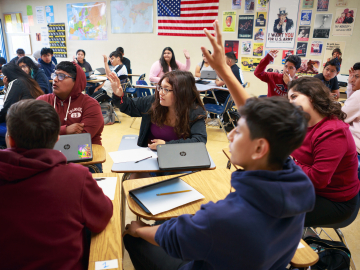
⟵ Go to all Research Stories
Get the Educator
Subscribe to our monthly newsletter.
Stanford Graduate School of Education
482 Galvez Mall Stanford, CA 94305-3096 Tel: (650) 723-2109
- Contact Admissions
- GSE Leadership
- Site Feedback
- Web Accessibility
- Career Resources
- Faculty Open Positions
- Explore Courses
- Academic Calendar
- Office of the Registrar
- Cubberley Library
- StanfordWho
- StanfordYou
Improving lives through learning

- Stanford Home
- Maps & Directions
- Search Stanford
- Emergency Info
- Terms of Use
- Non-Discrimination
- Accessibility
© Stanford University , Stanford , California 94305 .
Is Homework Good for Kids? Here’s What the Research Says
A s kids return to school, debate is heating up once again over how they should spend their time after they leave the classroom for the day.
The no-homework policy of a second-grade teacher in Texas went viral last week , earning praise from parents across the country who lament the heavy workload often assigned to young students. Brandy Young told parents she would not formally assign any homework this year, asking students instead to eat dinner with their families, play outside and go to bed early.
But the question of how much work children should be doing outside of school remains controversial, and plenty of parents take issue with no-homework policies, worried their kids are losing a potential academic advantage. Here’s what you need to know:
For decades, the homework standard has been a “10-minute rule,” which recommends a daily maximum of 10 minutes of homework per grade level. Second graders, for example, should do about 20 minutes of homework each night. High school seniors should complete about two hours of homework each night. The National PTA and the National Education Association both support that guideline.
But some schools have begun to give their youngest students a break. A Massachusetts elementary school has announced a no-homework pilot program for the coming school year, lengthening the school day by two hours to provide more in-class instruction. “We really want kids to go home at 4 o’clock, tired. We want their brain to be tired,” Kelly Elementary School Principal Jackie Glasheen said in an interview with a local TV station . “We want them to enjoy their families. We want them to go to soccer practice or football practice, and we want them to go to bed. And that’s it.”
A New York City public elementary school implemented a similar policy last year, eliminating traditional homework assignments in favor of family time. The change was quickly met with outrage from some parents, though it earned support from other education leaders.
New solutions and approaches to homework differ by community, and these local debates are complicated by the fact that even education experts disagree about what’s best for kids.
The research
The most comprehensive research on homework to date comes from a 2006 meta-analysis by Duke University psychology professor Harris Cooper, who found evidence of a positive correlation between homework and student achievement, meaning students who did homework performed better in school. The correlation was stronger for older students—in seventh through 12th grade—than for those in younger grades, for whom there was a weak relationship between homework and performance.
Cooper’s analysis focused on how homework impacts academic achievement—test scores, for example. His report noted that homework is also thought to improve study habits, attitudes toward school, self-discipline, inquisitiveness and independent problem solving skills. On the other hand, some studies he examined showed that homework can cause physical and emotional fatigue, fuel negative attitudes about learning and limit leisure time for children. At the end of his analysis, Cooper recommended further study of such potential effects of homework.
Despite the weak correlation between homework and performance for young children, Cooper argues that a small amount of homework is useful for all students. Second-graders should not be doing two hours of homework each night, he said, but they also shouldn’t be doing no homework.
Not all education experts agree entirely with Cooper’s assessment.
Cathy Vatterott, an education professor at the University of Missouri-St. Louis, supports the “10-minute rule” as a maximum, but she thinks there is not sufficient proof that homework is helpful for students in elementary school.
“Correlation is not causation,” she said. “Does homework cause achievement, or do high achievers do more homework?”
Vatterott, the author of Rethinking Homework: Best Practices That Support Diverse Needs , thinks there should be more emphasis on improving the quality of homework tasks, and she supports efforts to eliminate homework for younger kids.
“I have no concerns about students not starting homework until fourth grade or fifth grade,” she said, noting that while the debate over homework will undoubtedly continue, she has noticed a trend toward limiting, if not eliminating, homework in elementary school.
The issue has been debated for decades. A TIME cover in 1999 read: “Too much homework! How it’s hurting our kids, and what parents should do about it.” The accompanying story noted that the launch of Sputnik in 1957 led to a push for better math and science education in the U.S. The ensuing pressure to be competitive on a global scale, plus the increasingly demanding college admissions process, fueled the practice of assigning homework.
“The complaints are cyclical, and we’re in the part of the cycle now where the concern is for too much,” Cooper said. “You can go back to the 1970s, when you’ll find there were concerns that there was too little, when we were concerned about our global competitiveness.”
Cooper acknowledged that some students really are bringing home too much homework, and their parents are right to be concerned.
“A good way to think about homework is the way you think about medications or dietary supplements,” he said. “If you take too little, they’ll have no effect. If you take too much, they can kill you. If you take the right amount, you’ll get better.”
More Must-Reads From TIME
- The 100 Most Influential People of 2024
- Coco Gauff Is Playing for Herself Now
- Scenes From Pro-Palestinian Encampments Across U.S. Universities
- 6 Compliments That Land Every Time
- If You're Dating Right Now , You're Brave: Column
- The AI That Could Heal a Divided Internet
- Fallout Is a Brilliant Model for the Future of Video Game Adaptations
- Want Weekly Recs on What to Watch, Read, and More? Sign Up for Worth Your Time
Write to Katie Reilly at [email protected]
Does Homework Really Help Students Learn?
A conversation with a Wheelock researcher, a BU student, and a fourth-grade teacher

“Quality homework is engaging and relevant to kids’ lives,” says Wheelock’s Janine Bempechat. “It gives them autonomy and engages them in the community and with their families. In some subjects, like math, worksheets can be very helpful. It has to do with the value of practicing over and over.” Photo by iStock/Glenn Cook Photography
Do your homework.
If only it were that simple.
Educators have debated the merits of homework since the late 19th century. In recent years, amid concerns of some parents and teachers that children are being stressed out by too much homework, things have only gotten more fraught.
“Homework is complicated,” says developmental psychologist Janine Bempechat, a Wheelock College of Education & Human Development clinical professor. The author of the essay “ The Case for (Quality) Homework—Why It Improves Learning and How Parents Can Help ” in the winter 2019 issue of Education Next , Bempechat has studied how the debate about homework is influencing teacher preparation, parent and student beliefs about learning, and school policies.
She worries especially about socioeconomically disadvantaged students from low-performing schools who, according to research by Bempechat and others, get little or no homework.
BU Today sat down with Bempechat and Erin Bruce (Wheelock’17,’18), a new fourth-grade teacher at a suburban Boston school, and future teacher freshman Emma Ardizzone (Wheelock) to talk about what quality homework looks like, how it can help children learn, and how schools can equip teachers to design it, evaluate it, and facilitate parents’ role in it.
BU Today: Parents and educators who are against homework in elementary school say there is no research definitively linking it to academic performance for kids in the early grades. You’ve said that they’re missing the point.
Bempechat : I think teachers assign homework in elementary school as a way to help kids develop skills they’ll need when they’re older—to begin to instill a sense of responsibility and to learn planning and organizational skills. That’s what I think is the greatest value of homework—in cultivating beliefs about learning and skills associated with academic success. If we greatly reduce or eliminate homework in elementary school, we deprive kids and parents of opportunities to instill these important learning habits and skills.
We do know that beginning in late middle school, and continuing through high school, there is a strong and positive correlation between homework completion and academic success.
That’s what I think is the greatest value of homework—in cultivating beliefs about learning and skills associated with academic success.
You talk about the importance of quality homework. What is that?
Quality homework is engaging and relevant to kids’ lives. It gives them autonomy and engages them in the community and with their families. In some subjects, like math, worksheets can be very helpful. It has to do with the value of practicing over and over.

What are your concerns about homework and low-income children?
The argument that some people make—that homework “punishes the poor” because lower-income parents may not be as well-equipped as affluent parents to help their children with homework—is very troubling to me. There are no parents who don’t care about their children’s learning. Parents don’t actually have to help with homework completion in order for kids to do well. They can help in other ways—by helping children organize a study space, providing snacks, being there as a support, helping children work in groups with siblings or friends.
Isn’t the discussion about getting rid of homework happening mostly in affluent communities?
Yes, and the stories we hear of kids being stressed out from too much homework—four or five hours of homework a night—are real. That’s problematic for physical and mental health and overall well-being. But the research shows that higher-income students get a lot more homework than lower-income kids.
Teachers may not have as high expectations for lower-income children. Schools should bear responsibility for providing supports for kids to be able to get their homework done—after-school clubs, community support, peer group support. It does kids a disservice when our expectations are lower for them.
The conversation around homework is to some extent a social class and social justice issue. If we eliminate homework for all children because affluent children have too much, we’re really doing a disservice to low-income children. They need the challenge, and every student can rise to the challenge with enough supports in place.
What did you learn by studying how education schools are preparing future teachers to handle homework?
My colleague, Margarita Jimenez-Silva, at the University of California, Davis, School of Education, and I interviewed faculty members at education schools, as well as supervising teachers, to find out how students are being prepared. And it seemed that they weren’t. There didn’t seem to be any readings on the research, or conversations on what high-quality homework is and how to design it.
Erin, what kind of training did you get in handling homework?
Bruce : I had phenomenal professors at Wheelock, but homework just didn’t come up. I did lots of student teaching. I’ve been in classrooms where the teachers didn’t assign any homework, and I’ve been in rooms where they assigned hours of homework a night. But I never even considered homework as something that was my decision. I just thought it was something I’d pull out of a book and it’d be done.
I started giving homework on the first night of school this year. My first assignment was to go home and draw a picture of the room where you do your homework. I want to know if it’s at a table and if there are chairs around it and if mom’s cooking dinner while you’re doing homework.
The second night I asked them to talk to a grown-up about how are you going to be able to get your homework done during the week. The kids really enjoyed it. There’s a running joke that I’m teaching life skills.
Friday nights, I read all my kids’ responses to me on their homework from the week and it’s wonderful. They pour their hearts out. It’s like we’re having a conversation on my couch Friday night.
It matters to know that the teacher cares about you and that what you think matters to the teacher. Homework is a vehicle to connect home and school…for parents to know teachers are welcoming to them and their families.
Bempechat : I can’t imagine that most new teachers would have the intuition Erin had in designing homework the way she did.
Ardizzone : Conversations with kids about homework, feeling you’re being listened to—that’s such a big part of wanting to do homework….I grew up in Westchester County. It was a pretty demanding school district. My junior year English teacher—I loved her—she would give us feedback, have meetings with all of us. She’d say, “If you have any questions, if you have anything you want to talk about, you can talk to me, here are my office hours.” It felt like she actually cared.
Bempechat : It matters to know that the teacher cares about you and that what you think matters to the teacher. Homework is a vehicle to connect home and school…for parents to know teachers are welcoming to them and their families.
Ardizzone : But can’t it lead to parents being overbearing and too involved in their children’s lives as students?
Bempechat : There’s good help and there’s bad help. The bad help is what you’re describing—when parents hover inappropriately, when they micromanage, when they see their children confused and struggling and tell them what to do.
Good help is when parents recognize there’s a struggle going on and instead ask informative questions: “Where do you think you went wrong?” They give hints, or pointers, rather than saying, “You missed this,” or “You didn’t read that.”
Bruce : I hope something comes of this. I hope BU or Wheelock can think of some way to make this a more pressing issue. As a first-year teacher, it was not something I even thought about on the first day of school—until a kid raised his hand and said, “Do we have homework?” It would have been wonderful if I’d had a plan from day one.
Explore Related Topics:
- Share this story
Senior Contributing Editor

Sara Rimer A journalist for more than three decades, Sara Rimer worked at the Miami Herald , Washington Post and, for 26 years, the New York Times , where she was the New England bureau chief, and a national reporter covering education, aging, immigration, and other social justice issues. Her stories on the death penalty’s inequities were nominated for a Pulitzer Prize and cited in the U.S. Supreme Court’s decision outlawing the execution of people with intellectual disabilities. Her journalism honors include Columbia University’s Meyer Berger award for in-depth human interest reporting. She holds a BA degree in American Studies from the University of Michigan. Profile
She can be reached at [email protected] .
Comments & Discussion
Boston University moderates comments to facilitate an informed, substantive, civil conversation. Abusive, profane, self-promotional, misleading, incoherent or off-topic comments will be rejected. Moderators are staffed during regular business hours (EST) and can only accept comments written in English. Statistics or facts must include a citation or a link to the citation.
There are 81 comments on Does Homework Really Help Students Learn?
Insightful! The values about homework in elementary schools are well aligned with my intuition as a parent.
when i finish my work i do my homework and i sometimes forget what to do because i did not get enough sleep
same omg it does not help me it is stressful and if I have it in more than one class I hate it.
Same I think my parent wants to help me but, she doesn’t care if I get bad grades so I just try my best and my grades are great.
I think that last question about Good help from parents is not know to all parents, we do as our parents did or how we best think it can be done, so maybe coaching parents or giving them resources on how to help with homework would be very beneficial for the parent on how to help and for the teacher to have consistency and improve homework results, and of course for the child. I do see how homework helps reaffirm the knowledge obtained in the classroom, I also have the ability to see progress and it is a time I share with my kids
The answer to the headline question is a no-brainer – a more pressing problem is why there is a difference in how students from different cultures succeed. Perfect example is the student population at BU – why is there a majority population of Asian students and only about 3% black students at BU? In fact at some universities there are law suits by Asians to stop discrimination and quotas against admitting Asian students because the real truth is that as a group they are demonstrating better qualifications for admittance, while at the same time there are quotas and reduced requirements for black students to boost their portion of the student population because as a group they do more poorly in meeting admissions standards – and it is not about the Benjamins. The real problem is that in our PC society no one has the gazuntas to explore this issue as it may reveal that all people are not created equal after all. Or is it just environmental cultural differences??????
I get you have a concern about the issue but that is not even what the point of this article is about. If you have an issue please take this to the site we have and only post your opinion about the actual topic
This is not at all what the article is talking about.
This literally has nothing to do with the article brought up. You should really take your opinions somewhere else before you speak about something that doesn’t make sense.
we have the same name
so they have the same name what of it?
lol you tell her
totally agree
What does that have to do with homework, that is not what the article talks about AT ALL.
Yes, I think homework plays an important role in the development of student life. Through homework, students have to face challenges on a daily basis and they try to solve them quickly.I am an intense online tutor at 24x7homeworkhelp and I give homework to my students at that level in which they handle it easily.
More than two-thirds of students said they used alcohol and drugs, primarily marijuana, to cope with stress.
You know what’s funny? I got this assignment to write an argument for homework about homework and this article was really helpful and understandable, and I also agree with this article’s point of view.
I also got the same task as you! I was looking for some good resources and I found this! I really found this article useful and easy to understand, just like you! ^^
i think that homework is the best thing that a child can have on the school because it help them with their thinking and memory.
I am a child myself and i think homework is a terrific pass time because i can’t play video games during the week. It also helps me set goals.
Homework is not harmful ,but it will if there is too much
I feel like, from a minors point of view that we shouldn’t get homework. Not only is the homework stressful, but it takes us away from relaxing and being social. For example, me and my friends was supposed to hang at the mall last week but we had to postpone it since we all had some sort of work to do. Our minds shouldn’t be focused on finishing an assignment that in realty, doesn’t matter. I completely understand that we should have homework. I have to write a paper on the unimportance of homework so thanks.
homework isn’t that bad
Are you a student? if not then i don’t really think you know how much and how severe todays homework really is
i am a student and i do not enjoy homework because i practice my sport 4 out of the five days we have school for 4 hours and that’s not even counting the commute time or the fact i still have to shower and eat dinner when i get home. its draining!
i totally agree with you. these people are such boomers
why just why
they do make a really good point, i think that there should be a limit though. hours and hours of homework can be really stressful, and the extra work isn’t making a difference to our learning, but i do believe homework should be optional and extra credit. that would make it for students to not have the leaning stress of a assignment and if you have a low grade you you can catch up.
Studies show that homework improves student achievement in terms of improved grades, test results, and the likelihood to attend college. Research published in the High School Journal indicates that students who spent between 31 and 90 minutes each day on homework “scored about 40 points higher on the SAT-Mathematics subtest than their peers, who reported spending no time on homework each day, on average.” On both standardized tests and grades, students in classes that were assigned homework outperformed 69% of students who didn’t have homework. A majority of studies on homework’s impact – 64% in one meta-study and 72% in another – showed that take home assignments were effective at improving academic achievement. Research by the Institute for the Study of Labor (IZA) concluded that increased homework led to better GPAs and higher probability of college attendance for high school boys. In fact, boys who attended college did more than three hours of additional homework per week in high school.
So how are your measuring student achievement? That’s the real question. The argument that doing homework is simply a tool for teaching responsibility isn’t enough for me. We can teach responsibility in a number of ways. Also the poor argument that parents don’t need to help with homework, and that students can do it on their own, is wishful thinking at best. It completely ignores neurodiverse students. Students in poverty aren’t magically going to find a space to do homework, a friend’s or siblings to help them do it, and snacks to eat. I feel like the author of this piece has never set foot in a classroom of students.
THIS. This article is pathetic coming from a university. So intellectually dishonest, refusing to address the havoc of capitalism and poverty plays on academic success in life. How can they in one sentence use poor kids in an argument and never once address that poor children have access to damn near 0 of the resources affluent kids have? Draw me a picture and let’s talk about feelings lmao what a joke is that gonna put food in their belly so they can have the calories to burn in order to use their brain to study? What about quiet their 7 other siblings that they share a single bedroom with for hours? Is it gonna force the single mom to magically be at home and at work at the same time to cook food while you study and be there to throw an encouraging word?
Also the “parents don’t need to be a parent and be able to guide their kid at all academically they just need to exist in the next room” is wild. Its one thing if a parent straight up is not equipped but to say kids can just figured it out is…. wow coming from an educator What’s next the teacher doesn’t need to teach cause the kid can just follow the packet and figure it out?
Well then get a tutor right? Oh wait you are poor only affluent kids can afford a tutor for their hours of homework a day were they on average have none of the worries a poor child does. Does this address that poor children are more likely to also suffer abuse and mental illness? Like mentioned what about kids that can’t learn or comprehend the forced standardized way? Just let em fail? These children regularly are not in “special education”(some of those are a joke in their own and full of neglect and abuse) programs cause most aren’t even acknowledged as having disabilities or disorders.
But yes all and all those pesky poor kids just aren’t being worked hard enough lol pretty sure poor children’s existence just in childhood is more work, stress, and responsibility alone than an affluent child’s entire life cycle. Love they never once talked about the quality of education in the classroom being so bad between the poor and affluent it can qualify as segregation, just basically blamed poor people for being lazy, good job capitalism for failing us once again!
why the hell?
you should feel bad for saying this, this article can be helpful for people who has to write a essay about it
This is more of a political rant than it is about homework
I know a teacher who has told his students their homework is to find something they are interested in, pursue it and then come share what they learn. The student responses are quite compelling. One girl taught herself German so she could talk to her grandfather. One boy did a research project on Nelson Mandela because the teacher had mentioned him in class. Another boy, a both on the autism spectrum, fixed his family’s computer. The list goes on. This is fourth grade. I think students are highly motivated to learn, when we step aside and encourage them.
The whole point of homework is to give the students a chance to use the material that they have been presented with in class. If they never have the opportunity to use that information, and discover that it is actually useful, it will be in one ear and out the other. As a science teacher, it is critical that the students are challenged to use the material they have been presented with, which gives them the opportunity to actually think about it rather than regurgitate “facts”. Well designed homework forces the student to think conceptually, as opposed to regurgitation, which is never a pretty sight
Wonderful discussion. and yes, homework helps in learning and building skills in students.
not true it just causes kids to stress
Homework can be both beneficial and unuseful, if you will. There are students who are gifted in all subjects in school and ones with disabilities. Why should the students who are gifted get the lucky break, whereas the people who have disabilities suffer? The people who were born with this “gift” go through school with ease whereas people with disabilities struggle with the work given to them. I speak from experience because I am one of those students: the ones with disabilities. Homework doesn’t benefit “us”, it only tears us down and put us in an abyss of confusion and stress and hopelessness because we can’t learn as fast as others. Or we can’t handle the amount of work given whereas the gifted students go through it with ease. It just brings us down and makes us feel lost; because no mater what, it feels like we are destined to fail. It feels like we weren’t “cut out” for success.
homework does help
here is the thing though, if a child is shoved in the face with a whole ton of homework that isn’t really even considered homework it is assignments, it’s not helpful. the teacher should make homework more of a fun learning experience rather than something that is dreaded
This article was wonderful, I am going to ask my teachers about extra, or at all giving homework.
I agree. Especially when you have homework before an exam. Which is distasteful as you’ll need that time to study. It doesn’t make any sense, nor does us doing homework really matters as It’s just facts thrown at us.
Homework is too severe and is just too much for students, schools need to decrease the amount of homework. When teachers assign homework they forget that the students have other classes that give them the same amount of homework each day. Students need to work on social skills and life skills.
I disagree.
Beyond achievement, proponents of homework argue that it can have many other beneficial effects. They claim it can help students develop good study habits so they are ready to grow as their cognitive capacities mature. It can help students recognize that learning can occur at home as well as at school. Homework can foster independent learning and responsible character traits. And it can give parents an opportunity to see what’s going on at school and let them express positive attitudes toward achievement.
Homework is helpful because homework helps us by teaching us how to learn a specific topic.
As a student myself, I can say that I have almost never gotten the full 9 hours of recommended sleep time, because of homework. (Now I’m writing an essay on it in the middle of the night D=)
I am a 10 year old kid doing a report about “Is homework good or bad” for homework before i was going to do homework is bad but the sources from this site changed my mind!
Homeowkr is god for stusenrs
I agree with hunter because homework can be so stressful especially with this whole covid thing no one has time for homework and every one just wants to get back to there normal lives it is especially stressful when you go on a 2 week vaca 3 weeks into the new school year and and then less then a week after you come back from the vaca you are out for over a month because of covid and you have no way to get the assignment done and turned in
As great as homework is said to be in the is article, I feel like the viewpoint of the students was left out. Every where I go on the internet researching about this topic it almost always has interviews from teachers, professors, and the like. However isn’t that a little biased? Of course teachers are going to be for homework, they’re not the ones that have to stay up past midnight completing the homework from not just one class, but all of them. I just feel like this site is one-sided and you should include what the students of today think of spending four hours every night completing 6-8 classes worth of work.
Are we talking about homework or practice? Those are two very different things and can result in different outcomes.
Homework is a graded assignment. I do not know of research showing the benefits of graded assignments going home.
Practice; however, can be extremely beneficial, especially if there is some sort of feedback (not a grade but feedback). That feedback can come from the teacher, another student or even an automated grading program.
As a former band director, I assigned daily practice. I never once thought it would be appropriate for me to require the students to turn in a recording of their practice for me to grade. Instead, I had in-class assignments/assessments that were graded and directly related to the practice assigned.
I would really like to read articles on “homework” that truly distinguish between the two.
oof i feel bad good luck!
thank you guys for the artical because I have to finish an assingment. yes i did cite it but just thanks
thx for the article guys.
Homework is good
I think homework is helpful AND harmful. Sometimes u can’t get sleep bc of homework but it helps u practice for school too so idk.
I agree with this Article. And does anyone know when this was published. I would like to know.
It was published FEb 19, 2019.
Studies have shown that homework improved student achievement in terms of improved grades, test results, and the likelihood to attend college.
i think homework can help kids but at the same time not help kids
This article is so out of touch with majority of homes it would be laughable if it wasn’t so incredibly sad.
There is no value to homework all it does is add stress to already stressed homes. Parents or adults magically having the time or energy to shepherd kids through homework is dome sort of 1950’s fantasy.
What lala land do these teachers live in?
Homework gives noting to the kid
Homework is Bad
homework is bad.
why do kids even have homework?
Comments are closed.
Latest from Bostonia
American academy of arts & sciences welcomes five bu members, com’s newest journalism grad took her time, could boston be the next city to impose congestion pricing, alum has traveled the world to witness total solar eclipses, opening doors: rhonda harrison (eng’98,’04, grs’04), campus reacts and responds to israel-hamas war, reading list: what the pandemic revealed, remembering com’s david anable, cas’ john stone, “intellectual brilliance and brilliant kindness”, one good deed: christine kannler (cas’96, sph’00, camed’00), william fairfield warren society inducts new members, spreading art appreciation, restoring the “black angels” to medical history, in the kitchen with jacques pépin, feedback: readers weigh in on bu’s new president, com’s new expert on misinformation, and what’s really dividing the nation, the gifts of great teaching, sth’s walter fluker honored by roosevelt institute, alum’s debut book is a ramadan story for children, my big idea: covering construction sites with art, former terriers power new professional women’s hockey league.
share this!
August 16, 2021
Is it time to get rid of homework? Mental health experts weigh in
by Sara M Moniuszko

It's no secret that kids hate homework. And as students grapple with an ongoing pandemic that has had a wide-range of mental health impacts, is it time schools start listening to their pleas over workloads?
Some teachers are turning to social media to take a stand against homework .
Tiktok user @misguided.teacher says he doesn't assign it because the "whole premise of homework is flawed."
For starters, he says he can't grade work on "even playing fields" when students' home environments can be vastly different.
"Even students who go home to a peaceful house, do they really want to spend their time on busy work? Because typically that's what a lot of homework is, it's busy work," he says in the video that has garnered 1.6 million likes. "You only get one year to be 7, you only got one year to be 10, you only get one year to be 16, 18."
Mental health experts agree heavy work loads have the potential do more harm than good for students, especially when taking into account the impacts of the pandemic. But they also say the answer may not be to eliminate homework altogether.
Emmy Kang, mental health counselor at Humantold, says studies have shown heavy workloads can be "detrimental" for students and cause a "big impact on their mental, physical and emotional health."
"More than half of students say that homework is their primary source of stress, and we know what stress can do on our bodies," she says, adding that staying up late to finish assignments also leads to disrupted sleep and exhaustion.
Cynthia Catchings, a licensed clinical social worker and therapist at Talkspace, says heavy workloads can also cause serious mental health problems in the long run, like anxiety and depression.
And for all the distress homework causes, it's not as useful as many may think, says Dr. Nicholas Kardaras, a psychologist and CEO of Omega Recovery treatment center.
"The research shows that there's really limited benefit of homework for elementary age students, that really the school work should be contained in the classroom," he says.
For older students, Kang says homework benefits plateau at about two hours per night.
"Most students, especially at these high-achieving schools, they're doing a minimum of three hours, and it's taking away time from their friends from their families, their extracurricular activities. And these are all very important things for a person's mental and emotional health."
Catchings, who also taught third to 12th graders for 12 years, says she's seen the positive effects of a no homework policy while working with students abroad.
"Not having homework was something that I always admired from the French students (and) the French schools, because that was helping the students to really have the time off and really disconnect from school ," she says.
The answer may not be to eliminate homework completely, but to be more mindful of the type of work students go home with, suggests Kang, who was a high-school teacher for 10 years.
"I don't think (we) should scrap homework, I think we should scrap meaningless, purposeless busy work-type homework. That's something that needs to be scrapped entirely," she says, encouraging teachers to be thoughtful and consider the amount of time it would take for students to complete assignments.
The pandemic made the conversation around homework more crucial
Mindfulness surrounding homework is especially important in the context of the last two years. Many students will be struggling with mental health issues that were brought on or worsened by the pandemic, making heavy workloads even harder to balance.
"COVID was just a disaster in terms of the lack of structure. Everything just deteriorated," Kardaras says, pointing to an increase in cognitive issues and decrease in attention spans among students. "School acts as an anchor for a lot of children, as a stabilizing force, and that disappeared."
But even if students transition back to the structure of in-person classes, Kardaras suspects students may still struggle after two school years of shifted schedules and disrupted sleeping habits.
"We've seen adults struggling to go back to in-person work environments from remote work environments. That effect is amplified with children because children have less resources to be able to cope with those transitions than adults do," he explains.
'Get organized' ahead of back-to-school
In order to make the transition back to in-person school easier, Kang encourages students to "get good sleep, exercise regularly (and) eat a healthy diet."
To help manage workloads, she suggests students "get organized."
"There's so much mental clutter up there when you're disorganized... sitting down and planning out their study schedules can really help manage their time," she says.
Breaking assignments up can also make things easier to tackle.
"I know that heavy workloads can be stressful, but if you sit down and you break down that studying into smaller chunks, they're much more manageable."
If workloads are still too much, Kang encourages students to advocate for themselves.
"They should tell their teachers when a homework assignment just took too much time or if it was too difficult for them to do on their own," she says. "It's good to speak up and ask those questions. Respectfully, of course, because these are your teachers. But still, I think sometimes teachers themselves need this feedback from their students."
©2021 USA Today Distributed by Tribune Content Agency, LLC.
Explore further
Feedback to editors

Study: Airway hillocks challenge our understanding of lung biology
18 minutes ago

Religious intolerance predicts science denial, surveys suggest
57 minutes ago

A 'cosmic glitch' in gravity: New model may explain strange behavior on a cosmic scale

Why you can taste more ethanol in a cold pint of beer or warm glass of baijiu

Cell contraction drives the initial shaping of human embryos, study finds

Generating graph states of atomic ensembles via photon-mediated entanglement
2 hours ago

New findings point to an Earth-like environment on ancient Mars

Physicists discover new way to make strange metal

Rock solid evidence: Angola geology reveals prehistoric split between South America and Africa

Taam Ja' Blue Hole in Mexico's Chetumal Bay found to be deepest in the world
Relevant physicsforums posts, physics instructor minimum education - community college.
5 hours ago
Studying "Useful" vs. "Useless" Stuff in School
Apr 30, 2024
Why are Physicists so informal with mathematics?
Apr 29, 2024
Plagiarism & ChatGPT: Is Cheating with AI the New Normal?
Apr 28, 2024
Digital oscilloscope for high school use
Apr 25, 2024
Motivating high school Physics students with Popcorn Physics
Apr 3, 2024
More from STEM Educators and Teaching
Related Stories

Smartphones are lowering student's grades, study finds
Aug 18, 2020

Doing homework is associated with change in students' personality
Oct 6, 2017

Scholar suggests ways to craft more effective homework assignments
Oct 1, 2015

Should parents help their kids with homework?
Aug 29, 2019

How much math, science homework is too much?
Mar 23, 2015

Anxiety, depression, burnout rising as college students prepare to return to campus
Jul 26, 2021
Recommended for you

Training of brain processes makes reading more efficient
Apr 18, 2024

Researchers find lower grades given to students with surnames that come later in alphabetical order
Apr 17, 2024

Earth, the sun and a bike wheel: Why your high-school textbook was wrong about the shape of Earth's orbit
Apr 8, 2024

Touchibo, a robot that fosters inclusion in education through touch
Apr 5, 2024

More than money, family and community bonds prep teens for college success: Study

Research reveals significant effects of onscreen instructors during video classes in aiding student learning
Mar 25, 2024
Let us know if there is a problem with our content
Use this form if you have come across a typo, inaccuracy or would like to send an edit request for the content on this page. For general inquiries, please use our contact form . For general feedback, use the public comments section below (please adhere to guidelines ).
Please select the most appropriate category to facilitate processing of your request
Thank you for taking time to provide your feedback to the editors.
Your feedback is important to us. However, we do not guarantee individual replies due to the high volume of messages.
E-mail the story
Your email address is used only to let the recipient know who sent the email. Neither your address nor the recipient's address will be used for any other purpose. The information you enter will appear in your e-mail message and is not retained by Phys.org in any form.
Newsletter sign up
Get weekly and/or daily updates delivered to your inbox. You can unsubscribe at any time and we'll never share your details to third parties.
More information Privacy policy
Donate and enjoy an ad-free experience
We keep our content available to everyone. Consider supporting Science X's mission by getting a premium account.
E-mail newsletter

The Value of Homework
Are teachers assigning too much homework.
Posted September 5, 2016 | Reviewed by Ekua Hagan
- Studies show that the benefits of homework peak at about one hour to 90 minutes, and then after that, test scores begin to decline.
- Research has found that high school teachers (grades 9-12) report assigning an average of 3.5 hours’ worth of homework a week.
- While homework is necessary, there needs to be balance as well as communication between teachers about the amount of homework being assigned.

The value of homework has been the subject of debate over the years. In regards to research, the jury is still out as to whether homework positively impacts a student's academic achievement.
In the past, I have written a couple of posts on homework and whether or not it is being used or abused by educators. I am always amazed at what some of my young readers share about sleepless nights, not participating in extracurricular events, and high levels of stress —all of which are attributed to large and daunting amounts of homework .
There have been studies that show that doing homework in moderation improves test performance. So we can’t rule out the value of homework if it’s conducive to learning. However, studies have also shown that the benefits of homework peak at about one hour to 90 minutes, and then after that, test scores begin to decline.
Now, while looking at data, it’s important to review the standard, endorsed by the National Education Association and the National Parent-Teacher Association , known as the "10-minute rule" — 10 minutes of homework per grade level per night. That would mean there would only be 10 minutes of homework in the first grade, and end with 120 minutes for senior year of high school (double what research shows beneficial). This leads to an important question: On average, how much homework do teachers assign?

Typical homework amounts
A Harris Poll from the University of Phoenix surveyed teachers about the hours of homework required of students and why they assign it. Pollsters received responses from approximately 1,000 teachers in public, private, and parochial schools across the United States.
High school teachers (grades 9-12) reported assigning an average of 3.5 hours’ worth of homework a week. Middle school teachers (grades 6-8) reported assigning almost the same amount as high school teachers, 3.2 hours of homework a week. Lastly, K-5 teachers said they assigned an average of 2.9 hours of homework each week. This data shows a spike in homework beginning in middle school.
Why homework is assigned
When teachers were asked why they assign homework, they gave the top three reasons:
- to see how well students understand lessons
- to help students develop essential problem-solving skills
- to show parents what's being learned in school
Approximately, 30 percent of teachers reported they assigned homework to cover more content areas. What’s interesting about this poll was the longer an educator had been in the field the less homework they assigned. Take a look at the breakdown below:
- 3.6 hours (teachers with less than 10 years in the classroom)
- 3.1 hours (teachers with 10 to 19 years in the classroom)
- 2.8 hours (teachers with more than 20 years in the classroom)
The need for balance
While many agree that homework does have a time and place, there needs to be a balance between life and school. There also needs to be communication with other teachers in the school about assignments. Oftentimes, educators get so involved in their subject area, they communicate departmentally, not school-wide. As a result, it’s not uncommon for teens to have a project and a couple of tests all on the same day. This dump of work can lead to an overwhelming amount of stress.
Questions for educators
Educators, how can you maximize the benefit of homework? Use the questions below to guide you in whether or not to assign work outside of the classroom. Ask yourself:
- Do I need to assign homework or can this be done in class?
- Does this assignment contribute and supplement the lesson reviewed in class?
- Do students have all of the information they need to do this assignment? In others words, are they prepared to do the homework?
- What are you wanting your students to achieve from this assignment? Do you have a specific objective and intended outcome in mind?
- How much time will the assignment take to complete? Have you given your students a sufficient amount of time?
- Have you taken into account other coursework that your students have due?
- How can you incorporate student choice and feedback into your classroom?
- How can you monitor whether or not you are overloading your students?

What kids think of homework
Educators: As a conclusion, I have provided a few of the many comments, that I have received below. I think it’s important to look at the age/grade level and messages these teens have shared. Take time to read their words and reflect on ways you can incorporate their perspective into course objectives and content. I believe the solution to the homework dilemma can be found in assigning work in moderation and finding a balance between school, home, and life.
“I am a 7th grader in a small school in Michigan. I think one of the main problems about what teachers think about homework is that they do not think about what other classes are assigned for homework. Throughout the day, I get at least two full pages of homework to complete by the next day. During the school year, I am hesitant to sign up for sports because I am staying up after a game or practice to finish my homework.”

“I'm 17 and I'm in my last year of high school. I can honestly tell you that from 7 p.m. to 12 a.m. (sometimes 1 or 2 a.m.) I am doing homework. I've been trying to balance my homework with my work schedule, work around my house, and my social life with no success. So if someone were to ask me if I think kids have too much homework, I would say yes they do. My comment is based solely on my personal experience in high school.”
“I am 13 and I have a problem: homework. I can’t get my homework done at home because it is all on my school MacBook. I don’t own my own personal computer, only an Amazon Fire tablet. What’s the problem with my tablet? There are no middle or high school apps for it. You are might be wondering, “Why not bring the MacBook home?” Well, I am not allowed to, so what is the punishment ? Four late assignments, and 1 late argument essay. And 90% of the homework I get is on my MacBook. This is a mega stresser!"

Raychelle Cassada Lohman n , M.S., LPC, is the author of The Anger Workbook for Teens .
- Find a Therapist
- Find a Treatment Center
- Find a Psychiatrist
- Find a Support Group
- Find Online Therapy
- United States
- Brooklyn, NY
- Chicago, IL
- Houston, TX
- Los Angeles, CA
- New York, NY
- Portland, OR
- San Diego, CA
- San Francisco, CA
- Seattle, WA
- Washington, DC
- Asperger's
- Bipolar Disorder
- Chronic Pain
- Eating Disorders
- Passive Aggression
- Personality
- Goal Setting
- Positive Psychology
- Stopping Smoking
- Low Sexual Desire
- Relationships
- Child Development
- Therapy Center NEW
- Diagnosis Dictionary
- Types of Therapy

Understanding what emotional intelligence looks like and the steps needed to improve it could light a path to a more emotionally adept world.
- Emotional Intelligence
- Gaslighting
- Affective Forecasting
- Neuroscience
The Cult of Homework
America’s devotion to the practice stems in part from the fact that it’s what today’s parents and teachers grew up with themselves.

America has long had a fickle relationship with homework. A century or so ago, progressive reformers argued that it made kids unduly stressed , which later led in some cases to district-level bans on it for all grades under seventh. This anti-homework sentiment faded, though, amid mid-century fears that the U.S. was falling behind the Soviet Union (which led to more homework), only to resurface in the 1960s and ’70s, when a more open culture came to see homework as stifling play and creativity (which led to less). But this didn’t last either: In the ’80s, government researchers blamed America’s schools for its economic troubles and recommended ramping homework up once more.
The 21st century has so far been a homework-heavy era, with American teenagers now averaging about twice as much time spent on homework each day as their predecessors did in the 1990s . Even little kids are asked to bring school home with them. A 2015 study , for instance, found that kindergarteners, who researchers tend to agree shouldn’t have any take-home work, were spending about 25 minutes a night on it.
But not without pushback. As many children, not to mention their parents and teachers, are drained by their daily workload, some schools and districts are rethinking how homework should work—and some teachers are doing away with it entirely. They’re reviewing the research on homework (which, it should be noted, is contested) and concluding that it’s time to revisit the subject.
Read: My daughter’s homework is killing me
Hillsborough, California, an affluent suburb of San Francisco, is one district that has changed its ways. The district, which includes three elementary schools and a middle school, worked with teachers and convened panels of parents in order to come up with a homework policy that would allow students more unscheduled time to spend with their families or to play. In August 2017, it rolled out an updated policy, which emphasized that homework should be “meaningful” and banned due dates that fell on the day after a weekend or a break.
“The first year was a bit bumpy,” says Louann Carlomagno, the district’s superintendent. She says the adjustment was at times hard for the teachers, some of whom had been doing their job in a similar fashion for a quarter of a century. Parents’ expectations were also an issue. Carlomagno says they took some time to “realize that it was okay not to have an hour of homework for a second grader—that was new.”
Most of the way through year two, though, the policy appears to be working more smoothly. “The students do seem to be less stressed based on conversations I’ve had with parents,” Carlomagno says. It also helps that the students performed just as well on the state standardized test last year as they have in the past.
Earlier this year, the district of Somerville, Massachusetts, also rewrote its homework policy, reducing the amount of homework its elementary and middle schoolers may receive. In grades six through eight, for example, homework is capped at an hour a night and can only be assigned two to three nights a week.
Jack Schneider, an education professor at the University of Massachusetts at Lowell whose daughter attends school in Somerville, is generally pleased with the new policy. But, he says, it’s part of a bigger, worrisome pattern. “The origin for this was general parental dissatisfaction, which not surprisingly was coming from a particular demographic,” Schneider says. “Middle-class white parents tend to be more vocal about concerns about homework … They feel entitled enough to voice their opinions.”
Schneider is all for revisiting taken-for-granted practices like homework, but thinks districts need to take care to be inclusive in that process. “I hear approximately zero middle-class white parents talking about how homework done best in grades K through two actually strengthens the connection between home and school for young people and their families,” he says. Because many of these parents already feel connected to their school community, this benefit of homework can seem redundant. “They don’t need it,” Schneider says, “so they’re not advocating for it.”
That doesn’t mean, necessarily, that homework is more vital in low-income districts. In fact, there are different, but just as compelling, reasons it can be burdensome in these communities as well. Allison Wienhold, who teaches high-school Spanish in the small town of Dunkerton, Iowa, has phased out homework assignments over the past three years. Her thinking: Some of her students, she says, have little time for homework because they’re working 30 hours a week or responsible for looking after younger siblings.
As educators reduce or eliminate the homework they assign, it’s worth asking what amount and what kind of homework is best for students. It turns out that there’s some disagreement about this among researchers, who tend to fall in one of two camps.
In the first camp is Harris Cooper, a professor of psychology and neuroscience at Duke University. Cooper conducted a review of the existing research on homework in the mid-2000s , and found that, up to a point, the amount of homework students reported doing correlates with their performance on in-class tests. This correlation, the review found, was stronger for older students than for younger ones.
This conclusion is generally accepted among educators, in part because it’s compatible with “the 10-minute rule,” a rule of thumb popular among teachers suggesting that the proper amount of homework is approximately 10 minutes per night, per grade level—that is, 10 minutes a night for first graders, 20 minutes a night for second graders, and so on, up to two hours a night for high schoolers.
In Cooper’s eyes, homework isn’t overly burdensome for the typical American kid. He points to a 2014 Brookings Institution report that found “little evidence that the homework load has increased for the average student”; onerous amounts of homework, it determined, are indeed out there, but relatively rare. Moreover, the report noted that most parents think their children get the right amount of homework, and that parents who are worried about under-assigning outnumber those who are worried about over-assigning. Cooper says that those latter worries tend to come from a small number of communities with “concerns about being competitive for the most selective colleges and universities.”
According to Alfie Kohn, squarely in camp two, most of the conclusions listed in the previous three paragraphs are questionable. Kohn, the author of The Homework Myth: Why Our Kids Get Too Much of a Bad Thing , considers homework to be a “reliable extinguisher of curiosity,” and has several complaints with the evidence that Cooper and others cite in favor of it. Kohn notes, among other things, that Cooper’s 2006 meta-analysis doesn’t establish causation, and that its central correlation is based on children’s (potentially unreliable) self-reporting of how much time they spend doing homework. (Kohn’s prolific writing on the subject alleges numerous other methodological faults.)
In fact, other correlations make a compelling case that homework doesn’t help. Some countries whose students regularly outperform American kids on standardized tests, such as Japan and Denmark, send their kids home with less schoolwork , while students from some countries with higher homework loads than the U.S., such as Thailand and Greece, fare worse on tests. (Of course, international comparisons can be fraught because so many factors, in education systems and in societies at large, might shape students’ success.)
Kohn also takes issue with the way achievement is commonly assessed. “If all you want is to cram kids’ heads with facts for tomorrow’s tests that they’re going to forget by next week, yeah, if you give them more time and make them do the cramming at night, that could raise the scores,” he says. “But if you’re interested in kids who know how to think or enjoy learning, then homework isn’t merely ineffective, but counterproductive.”
His concern is, in a way, a philosophical one. “The practice of homework assumes that only academic growth matters, to the point that having kids work on that most of the school day isn’t enough,” Kohn says. What about homework’s effect on quality time spent with family? On long-term information retention? On critical-thinking skills? On social development? On success later in life? On happiness? The research is quiet on these questions.
Another problem is that research tends to focus on homework’s quantity rather than its quality, because the former is much easier to measure than the latter. While experts generally agree that the substance of an assignment matters greatly (and that a lot of homework is uninspiring busywork), there isn’t a catchall rule for what’s best—the answer is often specific to a certain curriculum or even an individual student.
Given that homework’s benefits are so narrowly defined (and even then, contested), it’s a bit surprising that assigning so much of it is often a classroom default, and that more isn’t done to make the homework that is assigned more enriching. A number of things are preserving this state of affairs—things that have little to do with whether homework helps students learn.
Jack Schneider, the Massachusetts parent and professor, thinks it’s important to consider the generational inertia of the practice. “The vast majority of parents of public-school students themselves are graduates of the public education system,” he says. “Therefore, their views of what is legitimate have been shaped already by the system that they would ostensibly be critiquing.” In other words, many parents’ own history with homework might lead them to expect the same for their children, and anything less is often taken as an indicator that a school or a teacher isn’t rigorous enough. (This dovetails with—and complicates—the finding that most parents think their children have the right amount of homework.)
Barbara Stengel, an education professor at Vanderbilt University’s Peabody College, brought up two developments in the educational system that might be keeping homework rote and unexciting. The first is the importance placed in the past few decades on standardized testing, which looms over many public-school classroom decisions and frequently discourages teachers from trying out more creative homework assignments. “They could do it, but they’re afraid to do it, because they’re getting pressure every day about test scores,” Stengel says.
Second, she notes that the profession of teaching, with its relatively low wages and lack of autonomy, struggles to attract and support some of the people who might reimagine homework, as well as other aspects of education. “Part of why we get less interesting homework is because some of the people who would really have pushed the limits of that are no longer in teaching,” she says.
“In general, we have no imagination when it comes to homework,” Stengel says. She wishes teachers had the time and resources to remake homework into something that actually engages students. “If we had kids reading—anything, the sports page, anything that they’re able to read—that’s the best single thing. If we had kids going to the zoo, if we had kids going to parks after school, if we had them doing all of those things, their test scores would improve. But they’re not. They’re going home and doing homework that is not expanding what they think about.”
“Exploratory” is one word Mike Simpson used when describing the types of homework he’d like his students to undertake. Simpson is the head of the Stone Independent School, a tiny private high school in Lancaster, Pennsylvania, that opened in 2017. “We were lucky to start a school a year and a half ago,” Simpson says, “so it’s been easy to say we aren’t going to assign worksheets, we aren’t going assign regurgitative problem sets.” For instance, a half-dozen students recently built a 25-foot trebuchet on campus.
Simpson says he thinks it’s a shame that the things students have to do at home are often the least fulfilling parts of schooling: “When our students can’t make the connection between the work they’re doing at 11 o’clock at night on a Tuesday to the way they want their lives to be, I think we begin to lose the plot.”
When I talked with other teachers who did homework makeovers in their classrooms, I heard few regrets. Brandy Young, a second-grade teacher in Joshua, Texas, stopped assigning take-home packets of worksheets three years ago, and instead started asking her students to do 20 minutes of pleasure reading a night. She says she’s pleased with the results, but she’s noticed something funny. “Some kids,” she says, “really do like homework.” She’s started putting out a bucket of it for students to draw from voluntarily—whether because they want an additional challenge or something to pass the time at home.
Chris Bronke, a high-school English teacher in the Chicago suburb of Downers Grove, told me something similar. This school year, he eliminated homework for his class of freshmen, and now mostly lets students study on their own or in small groups during class time. It’s usually up to them what they work on each day, and Bronke has been impressed by how they’ve managed their time.
In fact, some of them willingly spend time on assignments at home, whether because they’re particularly engaged, because they prefer to do some deeper thinking outside school, or because they needed to spend time in class that day preparing for, say, a biology test the following period. “They’re making meaningful decisions about their time that I don’t think education really ever gives students the experience, nor the practice, of doing,” Bronke said.
The typical prescription offered by those overwhelmed with homework is to assign less of it—to subtract. But perhaps a more useful approach, for many classrooms, would be to create homework only when teachers and students believe it’s actually needed to further the learning that takes place in class—to start with nothing, and add as necessary.
Does homework really work?
by: Leslie Crawford | Updated: December 12, 2023
Print article

You know the drill. It’s 10:15 p.m., and the cardboard-and-toothpick Golden Gate Bridge is collapsing. The pages of polynomials have been abandoned. The paper on the Battle of Waterloo seems to have frozen in time with Napoleon lingering eternally over his breakfast at Le Caillou. Then come the tears and tantrums — while we parents wonder, Does the gain merit all this pain? Is this just too much homework?
However the drama unfolds night after night, year after year, most parents hold on to the hope that homework (after soccer games, dinner, flute practice, and, oh yes, that childhood pastime of yore known as playing) advances their children academically.
But what does homework really do for kids? Is the forest’s worth of book reports and math and spelling sheets the average American student completes in their 12 years of primary schooling making a difference? Or is it just busywork?
Homework haterz
Whether or not homework helps, or even hurts, depends on who you ask. If you ask my 12-year-old son, Sam, he’ll say, “Homework doesn’t help anything. It makes kids stressed-out and tired and makes them hate school more.”
Nothing more than common kid bellyaching?
Maybe, but in the fractious field of homework studies, it’s worth noting that Sam’s sentiments nicely synopsize one side of the ivory tower debate. Books like The End of Homework , The Homework Myth , and The Case Against Homework the film Race to Nowhere , and the anguished parent essay “ My Daughter’s Homework is Killing Me ” make the case that homework, by taking away precious family time and putting kids under unneeded pressure, is an ineffective way to help children become better learners and thinkers.
One Canadian couple took their homework apostasy all the way to the Supreme Court of Canada. After arguing that there was no evidence that it improved academic performance, they won a ruling that exempted their two children from all homework.
So what’s the real relationship between homework and academic achievement?
How much is too much?
To answer this question, researchers have been doing their homework on homework, conducting and examining hundreds of studies. Chris Drew Ph.D., founder and editor at The Helpful Professor recently compiled multiple statistics revealing the folly of today’s after-school busy work. Does any of the data he listed below ring true for you?
• 45 percent of parents think homework is too easy for their child, primarily because it is geared to the lowest standard under the Common Core State Standards .
• 74 percent of students say homework is a source of stress , defined as headaches, exhaustion, sleep deprivation, weight loss, and stomach problems.
• Students in high-performing high schools spend an average of 3.1 hours a night on homework , even though 1 to 2 hours is the optimal duration, according to a peer-reviewed study .
Not included in the list above is the fact many kids have to abandon activities they love — like sports and clubs — because homework deprives them of the needed time to enjoy themselves with other pursuits.
Conversely, The Helpful Professor does list a few pros of homework, noting it teaches discipline and time management, and helps parents know what’s being taught in the class.
The oft-bandied rule on homework quantity — 10 minutes a night per grade (starting from between 10 to 20 minutes in first grade) — is listed on the National Education Association’s website and the National Parent Teacher Association’s website , but few schools follow this rule.
Do you think your child is doing excessive homework? Harris Cooper Ph.D., author of a meta-study on homework , recommends talking with the teacher. “Often there is a miscommunication about the goals of homework assignments,” he says. “What appears to be problematic for kids, why they are doing an assignment, can be cleared up with a conversation.” Also, Cooper suggests taking a careful look at how your child is doing the assignments. It may seem like they’re taking two hours, but maybe your child is wandering off frequently to get a snack or getting distracted.
Less is often more
If your child is dutifully doing their work but still burning the midnight oil, it’s worth intervening to make sure your child gets enough sleep. A 2012 study of 535 high school students found that proper sleep may be far more essential to brain and body development.
For elementary school-age children, Cooper’s research at Duke University shows there is no measurable academic advantage to homework. For middle-schoolers, Cooper found there is a direct correlation between homework and achievement if assignments last between one to two hours per night. After two hours, however, achievement doesn’t improve. For high schoolers, Cooper’s research suggests that two hours per night is optimal. If teens have more than two hours of homework a night, their academic success flatlines. But less is not better. The average high school student doing homework outperformed 69 percent of the students in a class with no homework.
Many schools are starting to act on this research. A Florida superintendent abolished homework in her 42,000 student district, replacing it with 20 minutes of nightly reading. She attributed her decision to “ solid research about what works best in improving academic achievement in students .”
More family time
A 2020 survey by Crayola Experience reports 82 percent of children complain they don’t have enough quality time with their parents. Homework deserves much of the blame. “Kids should have a chance to just be kids and do things they enjoy, particularly after spending six hours a day in school,” says Alfie Kohn, author of The Homework Myth . “It’s absurd to insist that children must be engaged in constructive activities right up until their heads hit the pillow.”
By far, the best replacement for homework — for both parents and children — is bonding, relaxing time together.
Homes Nearby
Homes for rent and sale near schools

How families of color can fight for fair discipline in school

Dealing with teacher bias

The most important school data families of color need to consider
Yes! Sign me up for updates relevant to my child's grade.
Please enter a valid email address
Thank you for signing up!
Server Issue: Please try again later. Sorry for the inconvenience
- Share full article
Advertisement
Supported by
Student Opinion
Should We Get Rid of Homework?
Some educators are pushing to get rid of homework. Would that be a good thing?

By Jeremy Engle and Michael Gonchar
Do you like doing homework? Do you think it has benefited you educationally?
Has homework ever helped you practice a difficult skill — in math, for example — until you mastered it? Has it helped you learn new concepts in history or science? Has it helped to teach you life skills, such as independence and responsibility? Or, have you had a more negative experience with homework? Does it stress you out, numb your brain from busywork or actually make you fall behind in your classes?
Should we get rid of homework?
In “ The Movement to End Homework Is Wrong, ” published in July, the Times Opinion writer Jay Caspian Kang argues that homework may be imperfect, but it still serves an important purpose in school. The essay begins:
Do students really need to do their homework? As a parent and a former teacher, I have been pondering this question for quite a long time. The teacher side of me can acknowledge that there were assignments I gave out to my students that probably had little to no academic value. But I also imagine that some of my students never would have done their basic reading if they hadn’t been trained to complete expected assignments, which would have made the task of teaching an English class nearly impossible. As a parent, I would rather my daughter not get stuck doing the sort of pointless homework I would occasionally assign, but I also think there’s a lot of value in saying, “Hey, a lot of work you’re going to end up doing in your life is pointless, so why not just get used to it?” I certainly am not the only person wondering about the value of homework. Recently, the sociologist Jessica McCrory Calarco and the mathematics education scholars Ilana Horn and Grace Chen published a paper, “ You Need to Be More Responsible: The Myth of Meritocracy and Teachers’ Accounts of Homework Inequalities .” They argued that while there’s some evidence that homework might help students learn, it also exacerbates inequalities and reinforces what they call the “meritocratic” narrative that says kids who do well in school do so because of “individual competence, effort and responsibility.” The authors believe this meritocratic narrative is a myth and that homework — math homework in particular — further entrenches the myth in the minds of teachers and their students. Calarco, Horn and Chen write, “Research has highlighted inequalities in students’ homework production and linked those inequalities to differences in students’ home lives and in the support students’ families can provide.”
Mr. Kang argues:
But there’s a defense of homework that doesn’t really have much to do with class mobility, equality or any sense of reinforcing the notion of meritocracy. It’s one that became quite clear to me when I was a teacher: Kids need to learn how to practice things. Homework, in many cases, is the only ritualized thing they have to do every day. Even if we could perfectly equalize opportunity in school and empower all students not to be encumbered by the weight of their socioeconomic status or ethnicity, I’m not sure what good it would do if the kids didn’t know how to do something relentlessly, over and over again, until they perfected it. Most teachers know that type of progress is very difficult to achieve inside the classroom, regardless of a student’s background, which is why, I imagine, Calarco, Horn and Chen found that most teachers weren’t thinking in a structural inequalities frame. Holistic ideas of education, in which learning is emphasized and students can explore concepts and ideas, are largely for the types of kids who don’t need to worry about class mobility. A defense of rote practice through homework might seem revanchist at this moment, but if we truly believe that schools should teach children lessons that fall outside the meritocracy, I can’t think of one that matters more than the simple satisfaction of mastering something that you were once bad at. That takes homework and the acknowledgment that sometimes a student can get a question wrong and, with proper instruction, eventually get it right.
Students, read the entire article, then tell us:
Should we get rid of homework? Why, or why not?
Is homework an outdated, ineffective or counterproductive tool for learning? Do you agree with the authors of the paper that homework is harmful and worsens inequalities that exist between students’ home circumstances?
Or do you agree with Mr. Kang that homework still has real educational value?
When you get home after school, how much homework will you do? Do you think the amount is appropriate, too much or too little? Is homework, including the projects and writing assignments you do at home, an important part of your learning experience? Or, in your opinion, is it not a good use of time? Explain.
In these letters to the editor , one reader makes a distinction between elementary school and high school:
Homework’s value is unclear for younger students. But by high school and college, homework is absolutely essential for any student who wishes to excel. There simply isn’t time to digest Dostoyevsky if you only ever read him in class.
What do you think? How much does grade level matter when discussing the value of homework?
Is there a way to make homework more effective?
If you were a teacher, would you assign homework? What kind of assignments would you give and why?
Want more writing prompts? You can find all of our questions in our Student Opinion column . Teachers, check out this guide to learn how you can incorporate them into your classroom.
Students 13 and older in the United States and Britain, and 16 and older elsewhere, are invited to comment. All comments are moderated by the Learning Network staff, but please keep in mind that once your comment is accepted, it will be made public.
Jeremy Engle joined The Learning Network as a staff editor in 2018 after spending more than 20 years as a classroom humanities and documentary-making teacher, professional developer and curriculum designer working with students and teachers across the country. More about Jeremy Engle
Is it time to get rid of homework? Mental health experts weigh in.

It's no secret that kids hate homework. And as students grapple with an ongoing pandemic that has had a wide range of mental health impacts, is it time schools start listening to their pleas about workloads?
Some teachers are turning to social media to take a stand against homework.
Tiktok user @misguided.teacher says he doesn't assign it because the "whole premise of homework is flawed."
For starters, he says, he can't grade work on "even playing fields" when students' home environments can be vastly different.
"Even students who go home to a peaceful house, do they really want to spend their time on busy work? Because typically that's what a lot of homework is, it's busy work," he says in the video that has garnered 1.6 million likes. "You only get one year to be 7, you only got one year to be 10, you only get one year to be 16, 18."
Mental health experts agree heavy workloads have the potential do more harm than good for students, especially when taking into account the impacts of the pandemic. But they also say the answer may not be to eliminate homework altogether.
Emmy Kang, mental health counselor at Humantold , says studies have shown heavy workloads can be "detrimental" for students and cause a "big impact on their mental, physical and emotional health."
"More than half of students say that homework is their primary source of stress, and we know what stress can do on our bodies," she says, adding that staying up late to finish assignments also leads to disrupted sleep and exhaustion.
Cynthia Catchings, a licensed clinical social worker and therapist at Talkspace , says heavy workloads can also cause serious mental health problems in the long run, like anxiety and depression.
And for all the distress homework can cause, it's not as useful as many may think, says Dr. Nicholas Kardaras, a psychologist and CEO of Omega Recovery treatment center.
"The research shows that there's really limited benefit of homework for elementary age students, that really the school work should be contained in the classroom," he says.
For older students, Kang says, homework benefits plateau at about two hours per night.
"Most students, especially at these high achieving schools, they're doing a minimum of three hours, and it's taking away time from their friends, from their families, their extracurricular activities. And these are all very important things for a person's mental and emotional health."
Catchings, who also taught third to 12th graders for 12 years, says she's seen the positive effects of a no-homework policy while working with students abroad.
"Not having homework was something that I always admired from the French students (and) the French schools, because that was helping the students to really have the time off and really disconnect from school," she says.
The answer may not be to eliminate homework completely but to be more mindful of the type of work students take home, suggests Kang, who was a high school teacher for 10 years.
"I don't think (we) should scrap homework; I think we should scrap meaningless, purposeless busy work-type homework. That's something that needs to be scrapped entirely," she says, encouraging teachers to be thoughtful and consider the amount of time it would take for students to complete assignments.
The pandemic made the conversation around homework more crucial
Mindfulness surrounding homework is especially important in the context of the past two years. Many students will be struggling with mental health issues that were brought on or worsened by the pandemic , making heavy workloads even harder to balance.
"COVID was just a disaster in terms of the lack of structure. Everything just deteriorated," Kardaras says, pointing to an increase in cognitive issues and decrease in attention spans among students. "School acts as an anchor for a lot of children, as a stabilizing force, and that disappeared."
But even if students transition back to the structure of in-person classes, Kardaras suspects students may still struggle after two school years of shifted schedules and disrupted sleeping habits.
"We've seen adults struggling to go back to in-person work environments from remote work environments. That effect is amplified with children because children have less resources to be able to cope with those transitions than adults do," he explains.
'Get organized' ahead of back-to-school
In order to make the transition back to in-person school easier, Kang encourages students to "get good sleep, exercise regularly (and) eat a healthy diet."
To help manage workloads, she suggests students "get organized."
"There's so much mental clutter up there when you're disorganized. ... Sitting down and planning out their study schedules can really help manage their time," she says.
Breaking up assignments can also make things easier to tackle.
"I know that heavy workloads can be stressful, but if you sit down and you break down that studying into smaller chunks, they're much more manageable."
If workloads are still too much, Kang encourages students to advocate for themselves.
"They should tell their teachers when a homework assignment just took too much time or if it was too difficult for them to do on their own," she says. "It's good to speak up and ask those questions. Respectfully, of course, because these are your teachers. But still, I think sometimes teachers themselves need this feedback from their students."
More: Some teachers let their students sleep in class. Here's what mental health experts say.
More: Some parents are slipping young kids in for the COVID-19 vaccine, but doctors discourage the move as 'risky'
- Second Opinion
- Research & Innovation
- Patients & Families
- Health Professionals
- Recently Visited
- Segunda opinión
- Refer a patient
- MyChart Login
Healthier, Happy Lives Blog
Sort articles by..., sort by category.
- Celebrating Volunteers
- Community Outreach
- Construction Updates
- Family-Centered Care
- Healthy Eating
- Heart Center
- Interesting Things
- Mental Health
- Patient Stories
- Research and Innovation
- Safety Tips
- Sustainability
- World-Class Care
About Our Blog
- Back-to-School
- Pediatric Technology
Latest Posts
- Tween Misses Old Heart but Grateful for New One After Transplant
- Q&A: Answering the ‘Why’ Behind Liver Transplant Inequity
- Stanford Medicine Children’s Health Draws Attention to Sustainability Through Recycled Art
- Boy With Short Bowel Syndrome Living the Dream of a Better Life
- NICU Sims Set Stage for Lifesaving Care

Health Hazards of Homework
March 18, 2014 | Julie Greicius Pediatrics .

A new study by the Stanford Graduate School of Education and colleagues found that students in high-performing schools who did excessive hours of homework “experienced greater behavioral engagement in school but also more academic stress, physical health problems, and lack of balance in their lives.”
Those health problems ranged from stress, headaches, exhaustion, sleep deprivation, weight loss and stomach problems, to psycho-social effects like dropping activities, not seeing friends or family, and not pursuing hobbies they enjoy.
In the Stanford Report story about the research, Denise Pope , a senior lecturer at the Stanford Graduate School of Education and a co-author of the study published in the Journal of Experimental Education , says, “Our findings on the effects of homework challenge the traditional assumption that homework is inherently good.”
The study was based on survey data from a sample of 4,317 students from 10 high-performing high schools in California communities in which median household income exceeded $90,000. Of the students surveyed, homework volume averaged about 3.1 hours each night.
“It is time to re-evaluate how the school environment is preparing our high school student for today’s workplace,” says Neville Golden, MD , chief of adolescent medicine at Stanford Medicine Children’s Health and a professor at the School of Medicine. “This landmark study shows that excessive homework is counterproductive, leading to sleep deprivation, school stress and other health problems. Parents can best support their children in these demanding academic environments by advocating for them through direct communication with teachers and school administrators about homework load.”
Related Posts

Top-ranked group group in Los Gatos, Calif., is now a part of one of the…

The Stanford Medicine Children’s Health network continues to grow with our newest addition, Town and…
- Julie Greicius
- more by this author...
Connect with us:
Download our App:
ABOUT STANFORD MEDICINE CHILDREN'S HEALTH
- Leadership Team
- Vision, Mission & Values
- The Stanford Advantage
- Government and Community Relations

LUCILE PACKARD FOUNDATION FOR CHILDREN'S HEALTH
- Get Involved
- Volunteering Services
- Auxiliaries & Affiliates
- Our Hospital
- Send a Greeting Card
- New Hospital
- Refer a Patient
- Pay Your Bill

Also Find Us on:
- Notice of Nondiscrimination
- Terms of Use
- Privacy Policy
- Code of Conduct
- Price Transparency
- Stanford School of Medicine
- Stanford Health Care
- Stanford University
Are You Down With or Done With Homework?
- Posted January 17, 2012
- By Lory Hough

The debate over how much schoolwork students should be doing at home has flared again, with one side saying it's too much, the other side saying in our competitive world, it's just not enough.
It was a move that doesn't happen very often in American public schools: The principal got rid of homework.
This past September, Stephanie Brant, principal of Gaithersburg Elementary School in Gaithersburg, Md., decided that instead of teachers sending kids home with math worksheets and spelling flash cards, students would instead go home and read. Every day for 30 minutes, more if they had time or the inclination, with parents or on their own.
"I knew this would be a big shift for my community," she says. But she also strongly believed it was a necessary one. Twenty-first-century learners, especially those in elementary school, need to think critically and understand their own learning — not spend night after night doing rote homework drills.
Brant's move may not be common, but she isn't alone in her questioning. The value of doing schoolwork at home has gone in and out of fashion in the United States among educators, policymakers, the media, and, more recently, parents. As far back as the late 1800s, with the rise of the Progressive Era, doctors such as Joseph Mayer Rice began pushing for a limit on what he called "mechanical homework," saying it caused childhood nervous conditions and eyestrain. Around that time, the then-influential Ladies Home Journal began publishing a series of anti-homework articles, stating that five hours of brain work a day was "the most we should ask of our children," and that homework was an intrusion on family life. In response, states like California passed laws abolishing homework for students under a certain age.
But, as is often the case with education, the tide eventually turned. After the Russians launched the Sputnik satellite in 1957, a space race emerged, and, writes Brian Gill in the journal Theory Into Practice, "The homework problem was reconceived as part of a national crisis; the U.S. was losing the Cold War because Russian children were smarter." Many earlier laws limiting homework were abolished, and the longterm trend toward less homework came to an end.
The debate re-emerged a decade later when parents of the late '60s and '70s argued that children should be free to play and explore — similar anti-homework wellness arguments echoed nearly a century earlier. By the early-1980s, however, the pendulum swung again with the publication of A Nation at Risk , which blamed poor education for a "rising tide of mediocrity." Students needed to work harder, the report said, and one way to do this was more homework.
For the most part, this pro-homework sentiment is still going strong today, in part because of mandatory testing and continued economic concerns about the nation's competitiveness. Many believe that today's students are falling behind their peers in places like Korea and Finland and are paying more attention to Angry Birds than to ancient Babylonia.
But there are also a growing number of Stephanie Brants out there, educators and parents who believe that students are stressed and missing out on valuable family time. Students, they say, particularly younger students who have seen a rise in the amount of take-home work and already put in a six- to nine-hour "work" day, need less, not more homework.
Who is right? Are students not working hard enough or is homework not working for them? Here's where the story gets a little tricky: It depends on whom you ask and what research you're looking at. As Cathy Vatterott, the author of Rethinking Homework , points out, "Homework has generated enough research so that a study can be found to support almost any position, as long as conflicting studies are ignored." Alfie Kohn, author of The Homework Myth and a strong believer in eliminating all homework, writes that, "The fact that there isn't anything close to unanimity among experts belies the widespread assumption that homework helps." At best, he says, homework shows only an association, not a causal relationship, with academic achievement. In other words, it's hard to tease out how homework is really affecting test scores and grades. Did one teacher give better homework than another? Was one teacher more effective in the classroom? Do certain students test better or just try harder?
"It is difficult to separate where the effect of classroom teaching ends," Vatterott writes, "and the effect of homework begins."
Putting research aside, however, much of the current debate over homework is focused less on how homework affects academic achievement and more on time. Parents in particular have been saying that the amount of time children spend in school, especially with afterschool programs, combined with the amount of homework given — as early as kindergarten — is leaving students with little time to run around, eat dinner with their families, or even get enough sleep.
Certainly, for some parents, homework is a way to stay connected to their children's learning. But for others, homework creates a tug-of-war between parents and children, says Liz Goodenough, M.A.T.'71, creator of a documentary called Where Do the Children Play?
"Ideally homework should be about taking something home, spending a few curious and interesting moments in which children might engage with parents, and then getting that project back to school — an organizational triumph," she says. "A nag-free activity could engage family time: Ask a parent about his or her own childhood. Interview siblings."
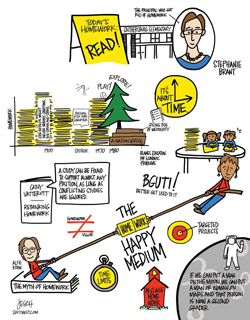
Instead, as the authors of The Case Against Homework write, "Homework overload is turning many of us into the types of parents we never wanted to be: nags, bribers, and taskmasters."
Leslie Butchko saw it happen a few years ago when her son started sixth grade in the Santa Monica-Malibu (Calif.) United School District. She remembers him getting two to four hours of homework a night, plus weekend and vacation projects. He was overwhelmed and struggled to finish assignments, especially on nights when he also had an extracurricular activity.
"Ultimately, we felt compelled to have Bobby quit karate — he's a black belt — to allow more time for homework," she says. And then, with all of their attention focused on Bobby's homework, she and her husband started sending their youngest to his room so that Bobby could focus. "One day, my younger son gave us 15-minute coupons as a present for us to use to send him to play in the back room. … It was then that we realized there had to be something wrong with the amount of homework we were facing."
Butchko joined forces with another mother who was having similar struggles and ultimately helped get the homework policy in her district changed, limiting homework on weekends and holidays, setting time guidelines for daily homework, and broadening the definition of homework to include projects and studying for tests. As she told the school board at one meeting when the policy was first being discussed, "In closing, I just want to say that I had more free time at Harvard Law School than my son has in middle school, and that is not in the best interests of our children."
One barrier that Butchko had to overcome initially was convincing many teachers and parents that more homework doesn't necessarily equal rigor.
"Most of the parents that were against the homework policy felt that students need a large quantity of homework to prepare them for the rigorous AP classes in high school and to get them into Harvard," she says.
Stephanie Conklin, Ed.M.'06, sees this at Another Course to College, the Boston pilot school where she teaches math. "When a student is not completing [his or her] homework, parents usually are frustrated by this and agree with me that homework is an important part of their child's learning," she says.
As Timothy Jarman, Ed.M.'10, a ninth-grade English teacher at Eugene Ashley High School in Wilmington, N.C., says, "Parents think it is strange when their children are not assigned a substantial amount of homework."
That's because, writes Vatterott, in her chapter, "The Cult(ure) of Homework," the concept of homework "has become so engrained in U.S. culture that the word homework is part of the common vernacular."
These days, nightly homework is a given in American schools, writes Kohn.
"Homework isn't limited to those occasions when it seems appropriate and important. Most teachers and administrators aren't saying, 'It may be useful to do this particular project at home,'" he writes. "Rather, the point of departure seems to be, 'We've decided ahead of time that children will have to do something every night (or several times a week). … This commitment to the idea of homework in the abstract is accepted by the overwhelming majority of schools — public and private, elementary and secondary."
Brant had to confront this when she cut homework at Gaithersburg Elementary.
"A lot of my parents have this idea that homework is part of life. This is what I had to do when I was young," she says, and so, too, will our kids. "So I had to shift their thinking." She did this slowly, first by asking her teachers last year to really think about what they were sending home. And this year, in addition to forming a parent advisory group around the issue, she also holds events to answer questions.
Still, not everyone is convinced that homework as a given is a bad thing. "Any pursuit of excellence, be it in sports, the arts, or academics, requires hard work. That our culture finds it okay for kids to spend hours a day in a sport but not equal time on academics is part of the problem," wrote one pro-homework parent on the blog for the documentary Race to Nowhere , which looks at the stress American students are under. "Homework has always been an issue for parents and children. It is now and it was 20 years ago. I think when people decide to have children that it is their responsibility to educate them," wrote another.
And part of educating them, some believe, is helping them develop skills they will eventually need in adulthood. "Homework can help students develop study skills that will be of value even after they leave school," reads a publication on the U.S. Department of Education website called Homework Tips for Parents. "It can teach them that learning takes place anywhere, not just in the classroom. … It can foster positive character traits such as independence and responsibility. Homework can teach children how to manage time."
Annie Brown, Ed.M.'01, feels this is particularly critical at less affluent schools like the ones she has worked at in Boston, Cambridge, Mass., and Los Angeles as a literacy coach.
"It feels important that my students do homework because they will ultimately be competing for college placement and jobs with students who have done homework and have developed a work ethic," she says. "Also it will get them ready for independently taking responsibility for their learning, which will need to happen for them to go to college."
The problem with this thinking, writes Vatterott, is that homework becomes a way to practice being a worker.
"Which begs the question," she writes. "Is our job as educators to produce learners or workers?"
Slate magazine editor Emily Bazelon, in a piece about homework, says this makes no sense for younger kids.
"Why should we think that practicing homework in first grade will make you better at doing it in middle school?" she writes. "Doesn't the opposite seem equally plausible: that it's counterproductive to ask children to sit down and work at night before they're developmentally ready because you'll just make them tired and cross?"
Kohn writes in the American School Board Journal that this "premature exposure" to practices like homework (and sit-and-listen lessons and tests) "are clearly a bad match for younger children and of questionable value at any age." He calls it BGUTI: Better Get Used to It. "The logic here is that we have to prepare you for the bad things that are going to be done to you later … by doing them to you now."
According to a recent University of Michigan study, daily homework for six- to eight-year-olds increased on average from about 8 minutes in 1981 to 22 minutes in 2003. A review of research by Duke University Professor Harris Cooper found that for elementary school students, "the average correlation between time spent on homework and achievement … hovered around zero."
So should homework be eliminated? Of course not, say many Ed School graduates who are teaching. Not only would students not have time for essays and long projects, but also teachers would not be able to get all students to grade level or to cover critical material, says Brett Pangburn, Ed.M.'06, a sixth-grade English teacher at Excel Academy Charter School in Boston. Still, he says, homework has to be relevant.
"Kids need to practice the skills being taught in class, especially where, like the kids I teach at Excel, they are behind and need to catch up," he says. "Our results at Excel have demonstrated that kids can catch up and view themselves as in control of their academic futures, but this requires hard work, and homework is a part of it."
Ed School Professor Howard Gardner basically agrees.
"America and Americans lurch between too little homework in many of our schools to an excess of homework in our most competitive environments — Li'l Abner vs. Tiger Mother," he says. "Neither approach makes sense. Homework should build on what happens in class, consolidating skills and helping students to answer new questions."
So how can schools come to a happy medium, a way that allows teachers to cover everything they need while not overwhelming students? Conklin says she often gives online math assignments that act as labs and students have two or three days to complete them, including some in-class time. Students at Pangburn's school have a 50-minute silent period during regular school hours where homework can be started, and where teachers pull individual or small groups of students aside for tutoring, often on that night's homework. Afterschool homework clubs can help.
Some schools and districts have adapted time limits rather than nix homework completely, with the 10-minute per grade rule being the standard — 10 minutes a night for first-graders, 30 minutes for third-graders, and so on. (This remedy, however, is often met with mixed results since not all students work at the same pace.) Other schools offer an extended day that allows teachers to cover more material in school, in turn requiring fewer take-home assignments. And for others, like Stephanie Brant's elementary school in Maryland, more reading with a few targeted project assignments has been the answer.
"The routine of reading is so much more important than the routine of homework," she says. "Let's have kids reflect. You can still have the routine and you can still have your workspace, but now it's for reading. I often say to parents, if we can put a man on the moon, we can put a man or woman on Mars and that person is now a second-grader. We don't know what skills that person will need. At the end of the day, we have to feel confident that we're giving them something they can use on Mars."
Read a January 2014 update.
Homework Policy Still Going Strong
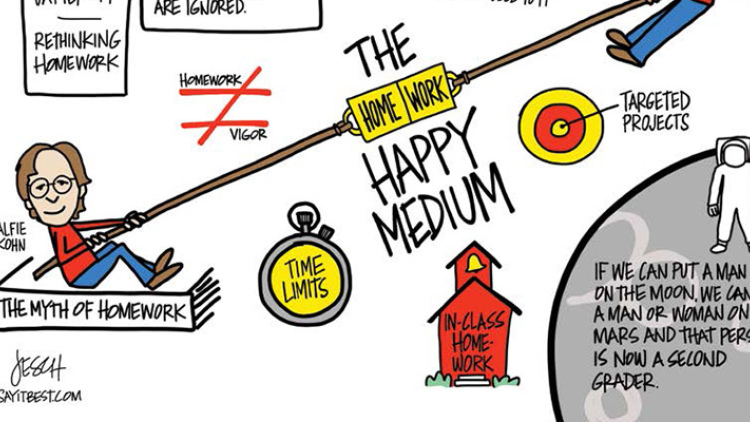
Ed. Magazine
The magazine of the Harvard Graduate School of Education
Related Articles

Commencement Marshal Sarah Fiarman: The Principal of the Matter

Making Math “Almost Fun”
Alum develops curriculum to entice reluctant math learners

Reshaping Teacher Licensure: Lessons from the Pandemic
Olivia Chi, Ed.M.'17, Ph.D.'20, discusses the ongoing efforts to ensure the quality and stability of the teaching workforce
Request More Info
Fill out the form below and a member of our team will reach out right away!
" * " indicates required fields
Is Homework Necessary? Education Inequity and Its Impact on Students

The Problem with Homework: It Highlights Inequalities
How much homework is too much homework, when does homework actually help, negative effects of homework for students, how teachers can help.
Schools are getting rid of homework from Essex, Mass., to Los Angeles, Calif. Although the no-homework trend may sound alarming, especially to parents dreaming of their child’s acceptance to Harvard, Stanford or Yale, there is mounting evidence that eliminating homework in grade school may actually have great benefits , especially with regard to educational equity.
In fact, while the push to eliminate homework may come as a surprise to many adults, the debate is not new . Parents and educators have been talking about this subject for the last century, so that the educational pendulum continues to swing back and forth between the need for homework and the need to eliminate homework.
One of the most pressing talking points around homework is how it disproportionately affects students from less affluent families. The American Psychological Association (APA) explained:
“Kids from wealthier homes are more likely to have resources such as computers, internet connections, dedicated areas to do schoolwork and parents who tend to be more educated and more available to help them with tricky assignments. Kids from disadvantaged homes are more likely to work at afterschool jobs, or to be home without supervision in the evenings while their parents work multiple jobs.”
[RELATED] How to Advance Your Career: A Guide for Educators >>
While students growing up in more affluent areas are likely playing sports, participating in other recreational activities after school, or receiving additional tutoring, children in disadvantaged areas are more likely headed to work after school, taking care of siblings while their parents work or dealing with an unstable home life. Adding homework into the mix is one more thing to deal with — and if the student is struggling, the task of completing homework can be too much to consider at the end of an already long school day.
While all students may groan at the mention of homework, it may be more than just a nuisance for poor and disadvantaged children, instead becoming another burden to carry and contend with.
Beyond the logistical issues, homework can negatively impact physical health and stress — and once again this may be a more significant problem among economically disadvantaged youth who typically already have a higher stress level than peers from more financially stable families .
Yet, today, it is not just the disadvantaged who suffer from the stressors that homework inflicts. A 2014 CNN article, “Is Homework Making Your Child Sick?” , covered the issue of extreme pressure placed on children of the affluent. The article looked at the results of a study surveying more than 4,300 students from 10 high-performing public and private high schools in upper-middle-class California communities.
“Their findings were troubling: Research showed that excessive homework is associated with high stress levels, physical health problems and lack of balance in children’s lives; 56% of the students in the study cited homework as a primary stressor in their lives,” according to the CNN story. “That children growing up in poverty are at-risk for a number of ailments is both intuitive and well-supported by research. More difficult to believe is the growing consensus that children on the other end of the spectrum, children raised in affluence, may also be at risk.”
When it comes to health and stress it is clear that excessive homework, for children at both ends of the spectrum, can be damaging. Which begs the question, how much homework is too much?
The National Education Association and the National Parent Teacher Association recommend that students spend 10 minutes per grade level per night on homework . That means that first graders should spend 10 minutes on homework, second graders 20 minutes and so on. But a study published by The American Journal of Family Therapy found that students are getting much more than that.
While 10 minutes per day doesn’t sound like much, that quickly adds up to an hour per night by sixth grade. The National Center for Education Statistics found that high school students get an average of 6.8 hours of homework per week, a figure that is much too high according to the Organization for Economic Cooperation and Development (OECD). It is also to be noted that this figure does not take into consideration the needs of underprivileged student populations.
In a study conducted by the OECD it was found that “after around four hours of homework per week, the additional time invested in homework has a negligible impact on performance .” That means that by asking our children to put in an hour or more per day of dedicated homework time, we are not only not helping them, but — according to the aforementioned studies — we are hurting them, both physically and emotionally.
What’s more is that homework is, as the name implies, to be completed at home, after a full day of learning that is typically six to seven hours long with breaks and lunch included. However, a study by the APA on how people develop expertise found that elite musicians, scientists and athletes do their most productive work for about only four hours per day. Similarly, companies like Tower Paddle Boards are experimenting with a five-hour workday, under the assumption that people are not able to be truly productive for much longer than that. CEO Stephan Aarstol told CNBC that he believes most Americans only get about two to three hours of work done in an eight-hour day.
In the scope of world history, homework is a fairly new construct in the U.S. Students of all ages have been receiving work to complete at home for centuries, but it was educational reformer Horace Mann who first brought the concept to America from Prussia.
Since then, homework’s popularity has ebbed and flowed in the court of public opinion. In the 1930s, it was considered child labor (as, ironically, it compromised children’s ability to do chores at home). Then, in the 1950s, implementing mandatory homework was hailed as a way to ensure America’s youth were always one step ahead of Soviet children during the Cold War. Homework was formally mandated as a tool for boosting educational quality in 1986 by the U.S. Department of Education, and has remained in common practice ever since.
School work assigned and completed outside of school hours is not without its benefits. Numerous studies have shown that regular homework has a hand in improving student performance and connecting students to their learning. When reviewing these studies, take them with a grain of salt; there are strong arguments for both sides, and only you will know which solution is best for your students or school.
Homework improves student achievement.
- Source: The High School Journal, “ When is Homework Worth the Time?: Evaluating the Association between Homework and Achievement in High School Science and Math ,” 2012.
- Source: IZA.org, “ Does High School Homework Increase Academic Achievement? ,” 2014. **Note: Study sample comprised only high school boys.
Homework helps reinforce classroom learning.
- Source: “ Debunk This: People Remember 10 Percent of What They Read ,” 2015.
Homework helps students develop good study habits and life skills.
- Sources: The Repository @ St. Cloud State, “ Types of Homework and Their Effect on Student Achievement ,” 2017; Journal of Advanced Academics, “ Developing Self-Regulation Skills: The Important Role of Homework ,” 2011.
- Source: Journal of Advanced Academics, “ Developing Self-Regulation Skills: The Important Role of Homework ,” 2011.
Homework allows parents to be involved with their children’s learning.
- Parents can see what their children are learning and working on in school every day.
- Parents can participate in their children’s learning by guiding them through homework assignments and reinforcing positive study and research habits.
- Homework observation and participation can help parents understand their children’s academic strengths and weaknesses, and even identify possible learning difficulties.
- Source: Phys.org, “ Sociologist Upends Notions about Parental Help with Homework ,” 2018.
While some amount of homework may help students connect to their learning and enhance their in-class performance, too much homework can have damaging effects.
Students with too much homework have elevated stress levels.
- Source: USA Today, “ Is It Time to Get Rid of Homework? Mental Health Experts Weigh In ,” 2021.
- Source: Stanford University, “ Stanford Research Shows Pitfalls of Homework ,” 2014.
Students with too much homework may be tempted to cheat.
- Source: The Chronicle of Higher Education, “ High-Tech Cheating Abounds, and Professors Bear Some Blame ,” 2010.
- Source: The American Journal of Family Therapy, “ Homework and Family Stress: With Consideration of Parents’ Self Confidence, Educational Level, and Cultural Background ,” 2015.
Homework highlights digital inequity.
- Sources: NEAToday.org, “ The Homework Gap: The ‘Cruelest Part of the Digital Divide’ ,” 2016; CNET.com, “ The Digital Divide Has Left Millions of School Kids Behind ,” 2021.
- Source: Investopedia, “ Digital Divide ,” 2022; International Journal of Education and Social Science, “ Getting the Homework Done: Social Class and Parents’ Relationship to Homework ,” 2015.
- Source: World Economic Forum, “ COVID-19 exposed the digital divide. Here’s how we can close it ,” 2021.
Homework does not help younger students.
- Source: Review of Educational Research, “ Does Homework Improve Academic Achievement? A Synthesis of Researcher, 1987-2003 ,” 2006.
To help students find the right balance and succeed, teachers and educators must start the homework conversation, both internally at their school and with parents. But in order to successfully advocate on behalf of students, teachers must be well educated on the subject, fully understanding the research and the outcomes that can be achieved by eliminating or reducing the homework burden. There is a plethora of research and writing on the subject for those interested in self-study.
For teachers looking for a more in-depth approach or for educators with a keen interest in educational equity, formal education may be the best route. If this latter option sounds appealing, there are now many reputable schools offering online master of education degree programs to help educators balance the demands of work and family life while furthering their education in the quest to help others.
YOU’RE INVITED! Watch Free Webinar on USD’s Online MEd Program >>
Be Sure To Share This Article
- Share on Twitter
- Share on Facebook
- Share on LinkedIn
Top 11 Reasons to get Your Master of Education Degree
Free 22-page Book

- Master of Education
Related Posts


School Life Balance , Tips for Online Students
The Pros and Cons of Homework
Updated: December 7, 2023
Published: January 23, 2020

Homework is a word that most students dread hearing. After hours upon hours of sitting in class , the last thing we want is more schoolwork over our precious weekends. While it’s known to be a staple of traditional schooling, homework has also become a rather divise topic. Some feel as though homework is a necessary part of school, while others believe that the time could be better invested. Should students have homework? Have a closer look into the arguments on both sides to decide for yourself.

Photo by energepic.com from Pexels
Why should students have homework, 1. homework encourages practice.
Many people believe that one of the positive effects of homework is that it encourages the discipline of practice. While it may be time consuming and boring compared to other activities, repetition is needed to get better at skills. Homework helps make concepts more clear, and gives students more opportunities when starting their career .
2. Homework Gets Parents Involved
Homework can be something that gets parents involved in their children’s lives if the environment is a healthy one. A parent helping their child with homework makes them take part in their academic success, and allows for the parent to keep up with what the child is doing in school. It can also be a chance to connect together.
3. Homework Teaches Time Management
Homework is much more than just completing the assigned tasks. Homework can develop time management skills , forcing students to plan their time and make sure that all of their homework assignments are done on time. By learning to manage their time, students also practice their problem-solving skills and independent thinking. One of the positive effects of homework is that it forces decision making and compromises to be made.
4. Homework Opens A Bridge Of Communication
Homework creates a connection between the student, the teacher, the school, and the parents. It allows everyone to get to know each other better, and parents can see where their children are struggling. In the same sense, parents can also see where their children are excelling. Homework in turn can allow for a better, more targeted educational plan for the student.
5. Homework Allows For More Learning Time
Homework allows for more time to complete the learning process. School hours are not always enough time for students to really understand core concepts, and homework can counter the effects of time shortages, benefiting students in the long run, even if they can’t see it in the moment.
6. Homework Reduces Screen Time
Many students in North America spend far too many hours watching TV. If they weren’t in school, these numbers would likely increase even more. Although homework is usually undesired, it encourages better study habits and discourages spending time in front of the TV. Homework can be seen as another extracurricular activity, and many families already invest a lot of time and money in different clubs and lessons to fill up their children’s extra time. Just like extracurricular activities, homework can be fit into one’s schedule.

The Other Side: Why Homework Is Bad
1. homework encourages a sedentary lifestyle.
Should students have homework? Well, that depends on where you stand. There are arguments both for the advantages and the disadvantages of homework.
While classroom time is important, playground time is just as important. If children are given too much homework, they won’t have enough playtime, which can impact their social development and learning. Studies have found that those who get more play get better grades in school , as it can help them pay closer attention in the classroom.
Children are already sitting long hours in the classroom, and homework assignments only add to these hours. Sedentary lifestyles can be dangerous and can cause health problems such as obesity. Homework takes away from time that could be spent investing in physical activity.
2. Homework Isn’t Healthy In Every Home
While many people that think homes are a beneficial environment for children to learn, not all homes provide a healthy environment, and there may be very little investment from parents. Some parents do not provide any kind of support or homework help, and even if they would like to, due to personal barriers, they sometimes cannot. Homework can create friction between children and their parents, which is one of the reasons why homework is bad .
3. Homework Adds To An Already Full-Time Job
School is already a full-time job for students, as they generally spend over 6 hours each day in class. Students also often have extracurricular activities such as sports, music, or art that are just as important as their traditional courses. Adding on extra hours to all of these demands is a lot for children to manage, and prevents students from having extra time to themselves for a variety of creative endeavors. Homework prevents self discovery and having the time to learn new skills outside of the school system. This is one of the main disadvantages of homework.
4. Homework Has Not Been Proven To Provide Results
Endless surveys have found that homework creates a negative attitude towards school, and homework has not been found to be linked to a higher level of academic success.
The positive effects of homework have not been backed up enough. While homework may help some students improve in specific subjects, if they have outside help there is no real proof that homework makes for improvements.
It can be a challenge to really enforce the completion of homework, and students can still get decent grades without doing their homework. Extra school time does not necessarily mean better grades — quality must always come before quantity.
Accurate practice when it comes to homework simply isn’t reliable. Homework could even cause opposite effects if misunderstood, especially since the reliance is placed on the student and their parents — one of the major reasons as to why homework is bad. Many students would rather cheat in class to avoid doing their homework at home, and children often just copy off of each other or from what they read on the internet.
5. Homework Assignments Are Overdone
The general agreement is that students should not be given more than 10 minutes a day per grade level. What this means is that a first grader should be given a maximum of 10 minutes of homework, while a second grader receives 20 minutes, etc. Many students are given a lot more homework than the recommended amount, however.
On average, college students spend as much as 3 hours per night on homework . By giving too much homework, it can increase stress levels and lead to burn out. This in turn provides an opposite effect when it comes to academic success.
The pros and cons of homework are both valid, and it seems as though the question of ‘‘should students have homework?’ is not a simple, straightforward one. Parents and teachers often are found to be clashing heads, while the student is left in the middle without much say.
It’s important to understand all the advantages and disadvantages of homework, taking both perspectives into conversation to find a common ground. At the end of the day, everyone’s goal is the success of the student.
Related Articles
- Skip to primary navigation
- Skip to main content
- Skip to primary sidebar
- Skip to footer
Don't Miss a Post! Subscribe
- Guest Posts

- Educational AI
- Edtech Tools
- Edtech Apps
- Teacher Resources
- Special Education
- Edtech for Kids
- Buying Guides for Teachers

Educators Technology
Innovative EdTech for teachers, educators, parents, and students
Is Homework Bad? Here Is What Research Says
By Med Kharbach, PhD | Last Update: April 30, 2024

Homework is a controversial topic and the object of differing opinions among teachers, parents, and educators . While some highly value it considering it key in scholarly achievement and academic performance, others view it as a nuisance to students’ independence and a cause for unwarranted emotional and physical stress for kids.
The controversy surrounding homework does not only revolve around its value, but also around questions such as: How much homework is enough homework? How much time should be allotted to homework? How frequent should homework be assigned? Does help from others (e.g., parents or other students) undermine the value of homework? Should homework be banned? Should kids be assigned homework? and many more.
However, as the research cited in this article demonstrates, homework, controversial as it is, has some benefits for students although these benefits differ according to various factors including students age, skill and grade level, students socio-economic status, purpose behind homework, duration of the homework, among other considerations. In this article, I cover some of the key issues related to homework and provide research resources to help teachers and parents learn more about homework.
What Does Homework Mean?
According to Cooper (1989), homework is defined as “tasks assigned to students by school teachers that are meant to be carried out during non-school hours”. Cooper’s definition is similar to the one found in Cambridge Dictionary which defines homework as “work that teachers give their students to do at home” or as “studying that students do at home to prepare for school”.
There is way more to homework than what these general definitions outline. Homework assignments are not equal and there are various variables that can affect the value and effectiveness of homework.
Some of these variables, according to Blazer (2009) , include difficulty level of assigned tasks, skill and subject areas covered, completion timeframe (short or long term), degree of autonomy and individualization, social context (done independently or with the help of others), obligatory or voluntary, whether it will be submitted for grading or not, among other variables.
Is Homework Bad?
Going through the scholarly literature and regardless of the disagreement and controversies the topic of homework raises, there is a growing consensus that homework has some benefits , especially for students in middle and high school ( National Education Association ).
One of the most comprehensive research studies on homework is a meta-analysis done by professor Harris Cooper and his colleagues (2006) and published in the journal Review of Educational Research .
In this study, Cooper et al analyzed a large pool of research studies on homework conducted in the United States between between 1987 and 2003. Their findings indicate the existence of ‘a positive influence of homework on achievement’.
The influence is mainly noticed in students in grades 7-12 and less in students grades K-6. However, even though kids benefit less from homework, Cooper et al. confirm the importance of some form of homework for students of all ages.
What Is The Purpose of Homework?
There are several reasons for assigning homework. Some of these reasons according to Blazer include:
– Review and reinforce materials learned in class – Check students understanding and assess their skills and knowledge – Enhance students study skills – Provide students with learning opportunities where they can use their newly acquired skills to explore new insights. – Enable students to hone in their search skills and apply them to find resources on an assigned topic – Help students develop social emotional learning skills – Enable students to develop functional study habits and life skills. These include time management and organization skills, problem solving skills, self-discipline, accountability, self-confidence, communication skills, critical thinking skills, inquisitiveness, among others.
Drawbacks of Homework
Critics of homework argue that it has less value and can result in negative consequences. In her literature review, Blazer (2009) summarized some of these drawbacks in the following points:
– Homework can cause emotional and physical fatigue – Homework takes away from kids’ leisure time and interferes with their natural development. – Homework can drive students to develop negative attitudes towards school and learning. – Assigned homework prevents students from engaging in self-directed and independent learning. – Homework can interfere with students’ engagement in social activities including sports and community involvement. – Excessive homework can create tension and stress and lead to friction between parents and kids. – Homework may encourage a culture of cheating – Homework “can widen social inequalities. Compared to their higher income peers, students from lower income homes are more likely to work after school and less likely to have an environment conducive to studying”.

How Much Homework Should Students Have?
According to Fernández-Alonso, Suárez-Álvarez and Muñiz ( 2015 ), spending 60 minutes per day doing homework is considered a reasonably effective time. However, the study also added that the amount of help and effort needed to do homework is key in this equation because “when it comes to homework”, as the authors concluded, “how is more important than how much”.
This conclusion is congruent with several other studies (e.g., Farrow et al. (1999), that emphasize the idea that when doing homework, quality is more important than quantity. When the variables of time and effort are taken into account, the question of how much homework should students have becomes statistically irrelevant.
Catty Vatterott, author of Rethinking Homework: Best Practices that Support Diverse Needs , also advocates for quality over quantity when assigning homework tasks.She argues that instead of banning homework altogether, we can embrace a more open approach to homework; one that deemphasizes grading and differentiates tasks.
Along similar lines, studies have also confirmed the correlation between autonomy and positive performance. Autonomous students, that is those who can do homework on their own, are more likely to perform better academically (Fernández-Alonso, 2015; Dettmers et al.,2010, 2011; Trautwein & Lüdtke, 2007, (Xu, 2010a). Findings from these studies indicate that “students who need frequent or constant help with homework have worse academic results.” (Fernández-Alonso, 2015)
Besides the 60 minutes per day recommendation for older students, there is also the 10 minutes rule which, according to Harris Cooper , works by multiplying a kid’s grade by 10 to determine how much time they need for homework per day.
According to the 10 minute rule, first graders require 10 minutes per day of homework, second graders 20 minutes, and for each subsequent year you add another 10 minutes so that at the last year of high school, grade 12 students will have 2 hours of daily homework. As Cooper argues, “when you assign more than these levels, the law of diminishing returns or even negative effects – stress especially – begin to appear”.
The debate over homework is far from being settled and probably will never reach definitive conclusions. With that being said, l personally view homework as a heuristic for learning. It scaffolds classroom learning and helps students reinforce learned skills. For elementary students, homework should not be tied to any academic grades or achievement expectation.
In fact, kids’ homework assignments, if any, should align with the overall interests of kids in that it should support and include elements of play, fun, and exploration. Needless to mention that, once outside school, kids are to be given ample time to play, explore, and learn by doing.
As Cooper stated “A good way to think about homework is the way you think about medications or dietary supplements. If you take too little, they’ll have no effect. If you take too much, they can kill you. If you take the right amount, you’ll get better.”
Research on Homework
The topic of homework has been the subject of several academic research studies. The following is a sample of some of these research studies:
- Blazer, C. (2009). Literature review: Homework. Miami, FL: Miami Dade County Public Schools.
- Cooper, H. (1989). Synthesis of research on homework. Educational Leadership, 47, 85–91.
- Cooper, H., Robinson, J. C., & Patall, E. A. (2006). Does homework improve academic achievement? A synthesis of research, 1987–2003. Review of Educational Research, 76, 1– 62.
- Dettmers, S., Trautwein, U., Lüdtke, M., Kunter, M., & Baumert, J. (2010). Homework works if homework quality is high: Using multilevel modeling to predict the development of achievement in mathematics. Journal of Educational Psychology,
- Dettmers, S., Trautwein, U., & Lüdtke, O. (2009). The relationship between homework time and achievement is not universal: Evidence from multilevel analyses in 40 countries. School Effectiveness and School Improvement, 20, 375– 405.
- Epstein, J. L., & van Voorhis, F. L. (2001). More than minutes: Teachers’ roles in designing homework. Educational Psychologist, 36, 181–193
- Farrow, S., Tymms, P., & Henderson, B. (1999). Homework and attainment in primary schools. British Educational Research Journal, 25, 323–341
- Goldstein, A. (1960). Does homework help? A review of research. The Elementary School Journal, 60, 212–224.
- Trautwein, U., & Köller, O. (2003). The relationship between homework and achievement: Still much of a mystery. Educational Psychology Review, 15, 115–145
- Warton, P. M. (2001). The forgotten voices in homework: Views of students. Educational Psychologist, 36, 155–165.
- Xu, J. (2013). Why do students have difficulties completing homework? The need for homework management. Journal of Education and Training Studies, 1, 98 –105.
- Zimmerman, B. J., & Kitsantas, A. (2005). Homework practices and academic achievement: The mediating role of self-efficacy and perceived responsibility beliefs. Contemporary Educational Psychology, 30, 397– 417.
- Kralovec, E., & Buell, J. (2001). End Homework Now. Educational Leadership, 58(7), 39-42.
- Krashen, S. (2005). The Hard Work Hypothesis: Is Doing Your Homework Enough to Overcome the Effects of Poverty? Multicultural Education, 12(4), 16-19.
- Lenard, W. (1997). The Homework Scam. Teacher Magazine, 9(1), 60-61.
- Marzano, R.J., & Pickering, D.J. (2007). The Case For and Against Homework. Educational Leadership, 64(6), 74-79.
- Skinner, D. (2004). The Homework Wars. Public Interest, 154, Winter, 49-60.
- Corno, L. (1996). Homework is a Complicated Thing. Educational Researcher, 25(8), 27-30.
- Forster, K. (2000). Homework: A Bridge Too Far? Issues in Educational Research, 10(1), 21-37.
- Hoover-Dempsey, K.V., Battiato, A.C., Walker, J.M., Reed, R.P., DeLong, J.M., & Jones, K.P. (2001). Parent Involvement in Homework. Educational Psychologist, 36(3), 195-209.
Books on Homework
Here are some interesting books that profoundly explore the concept of homework:
1. The Homework Myth: Why Our Kids Get Too Much of a Bad Thing , by Kohn (2006)
- 2. Rethinking Homework: Best Practices that Support Diverse Needs , by Catty Vatterot
- 3. The End of Homework: How Homework Disrupts Families, Overburdens Children, and Limits Learning , by Kralovec, E., & Buell, J. (2000)
- 4. The Case Against Homework: How Homework Is Hurting Children and What Parents Can Do About It , by Sara Bennett and Nancy Kalish

Join our mailing list
Never miss an EdTech beat! Subscribe now for exclusive insights and resources .

Meet Med Kharbach, PhD
Dr. Med Kharbach is an influential voice in the global educational technology landscape, with an extensive background in educational studies and a decade-long experience as a K-12 teacher. Holding a Ph.D. from Mount Saint Vincent University in Halifax, Canada, he brings a unique perspective to the educational world by integrating his profound academic knowledge with his hands-on teaching experience. Dr. Kharbach's academic pursuits encompass curriculum studies, discourse analysis, language learning/teaching, language and identity, emerging literacies, educational technology, and research methodologies. His work has been presented at numerous national and international conferences and published in various esteemed academic journals.

Join our email list for exclusive EdTech content.

Home » Tips for Teachers » 7 Research-Based Reasons Why Students Should Not Have Homework: Academic Insights, Opposing Perspectives & Alternatives
7 Research-Based Reasons Why Students Should Not Have Homework: Academic Insights, Opposing Perspectives & Alternatives
In recent years, the question of why students should not have homework has become a topic of intense debate among educators, parents, and students themselves. This discussion stems from a growing body of research that challenges the traditional view of homework as an essential component of academic success. The notion that homework is an integral part of learning is being reevaluated in light of new findings about its effectiveness and impact on students’ overall well-being.
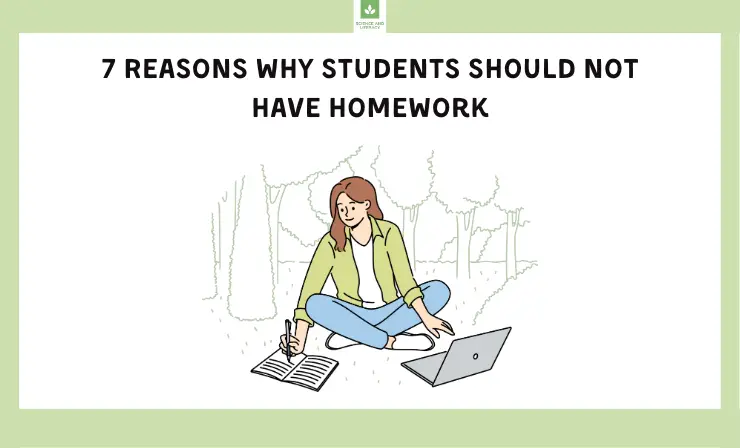
The push against homework is not just about the hours spent on completing assignments; it’s about rethinking the role of education in fostering the well-rounded development of young individuals. Critics argue that homework, particularly in excessive amounts, can lead to negative outcomes such as stress, burnout, and a diminished love for learning. Moreover, it often disproportionately affects students from disadvantaged backgrounds, exacerbating educational inequities. The debate also highlights the importance of allowing children to have enough free time for play, exploration, and family interaction, which are crucial for their social and emotional development.
Checking 13yo’s math homework & I have just one question. I can catch mistakes & help her correct. But what do kids do when their parent isn’t an Algebra teacher? Answer: They get frustrated. Quit. Get a bad grade. Think they aren’t good at math. How is homework fair??? — Jay Wamsted (@JayWamsted) March 24, 2022
As we delve into this discussion, we explore various facets of why reducing or even eliminating homework could be beneficial. We consider the research, weigh the pros and cons, and examine alternative approaches to traditional homework that can enhance learning without overburdening students.
Once you’ve finished this article, you’ll know:
- Insights from Teachers and Education Industry Experts →
- 7 Reasons Why Students Should Not Have Homework →
- Opposing Views on Homework Practices →
- Exploring Alternatives to Homework →
Insights from Teachers and Education Industry Experts: Diverse Perspectives on Homework
In the ongoing conversation about the role and impact of homework in education, the perspectives of those directly involved in the teaching process are invaluable. Teachers and education industry experts bring a wealth of experience and insights from the front lines of learning. Their viewpoints, shaped by years of interaction with students and a deep understanding of educational methodologies, offer a critical lens through which we can evaluate the effectiveness and necessity of homework in our current educational paradigm.
Check out this video featuring Courtney White, a high school language arts teacher who gained widespread attention for her explanation of why she chooses not to assign homework.
Here are the insights and opinions from various experts in the educational field on this topic:
“I teach 1st grade. I had parents ask for homework. I explained that I don’t give homework. Home time is family time. Time to play, cook, explore and spend time together. I do send books home, but there is no requirement or checklist for reading them. Read them, enjoy them, and return them when your child is ready for more. I explained that as a parent myself, I know they are busy—and what a waste of energy it is to sit and force their kids to do work at home—when they could use that time to form relationships and build a loving home. Something kids need more than a few math problems a week.” — Colleen S. , 1st grade teacher
“The lasting educational value of homework at that age is not proven. A kid says the times tables [at school] because he studied the times tables last night. But over a long period of time, a kid who is drilled on the times tables at school, rather than as homework, will also memorize their times tables. We are worried about young children and their social emotional learning. And that has to do with physical activity, it has to do with playing with peers, it has to do with family time. All of those are very important and can be removed by too much homework.” — David Bloomfield , education professor at Brooklyn College and the City University of New York graduate center
“Homework in primary school has an effect of around zero. In high school it’s larger. (…) Which is why we need to get it right. Not why we need to get rid of it. It’s one of those lower hanging fruit that we should be looking in our primary schools to say, ‘Is it really making a difference?’” — John Hattie , professor
”Many kids are working as many hours as their overscheduled parents and it is taking a toll – psychologically and in many other ways too. We see kids getting up hours before school starts just to get their homework done from the night before… While homework may give kids one more responsibility, it ignores the fact that kids do not need to grow up and become adults at ages 10 or 12. With schools cutting recess time or eliminating playgrounds, kids absorb every single stress there is, only on an even higher level. Their brains and bodies need time to be curious, have fun, be creative and just be a kid.” — Pat Wayman, teacher and CEO of HowtoLearn.com
7 Reasons Why Students Should Not Have Homework
Let’s delve into the reasons against assigning homework to students. Examining these arguments offers important perspectives on the wider educational and developmental consequences of homework practices.
1. Elevated Stress and Health Consequences
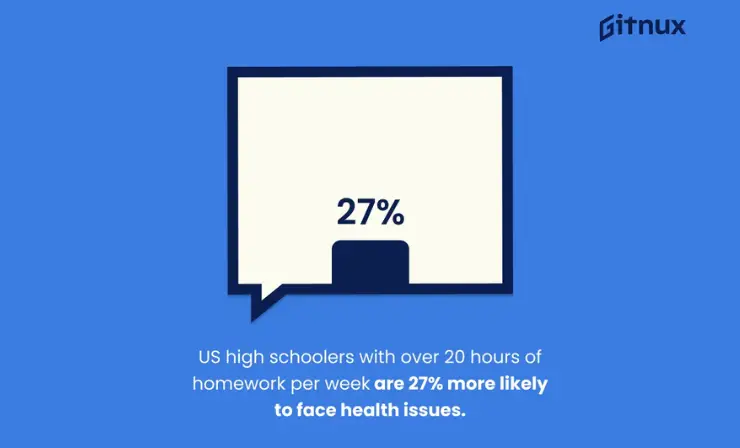
The ongoing debate about homework often focuses on its educational value, but a vital aspect that cannot be overlooked is the significant stress and health consequences it brings to students. In the context of American life, where approximately 70% of people report moderate or extreme stress due to various factors like mass shootings, healthcare affordability, discrimination, racism, sexual harassment, climate change, presidential elections, and the need to stay informed, the additional burden of homework further exacerbates this stress, particularly among students.
Key findings and statistics reveal a worrying trend:
- Overwhelming Student Stress: A staggering 72% of students report being often or always stressed over schoolwork, with a concerning 82% experiencing physical symptoms due to this stress.
- Serious Health Issues: Symptoms linked to homework stress include sleep deprivation, headaches, exhaustion, weight loss, and stomach problems.
- Sleep Deprivation: Despite the National Sleep Foundation recommending 8.5 to 9.25 hours of sleep for healthy adolescent development, students average just 6.80 hours of sleep on school nights. About 68% of students stated that schoolwork often or always prevented them from getting enough sleep, which is critical for their physical and mental health.
- Turning to Unhealthy Coping Mechanisms: Alarmingly, the pressure from excessive homework has led some students to turn to alcohol and drugs as a way to cope with stress.
This data paints a concerning picture. Students, already navigating a world filled with various stressors, find themselves further burdened by homework demands. The direct correlation between excessive homework and health issues indicates a need for reevaluation. The goal should be to ensure that homework if assigned, adds value to students’ learning experiences without compromising their health and well-being.
By addressing the issue of homework-related stress and health consequences, we can take a significant step toward creating a more nurturing and effective educational environment. This environment would not only prioritize academic achievement but also the overall well-being and happiness of students, preparing them for a balanced and healthy life both inside and outside the classroom.
2. Inequitable Impact and Socioeconomic Disparities
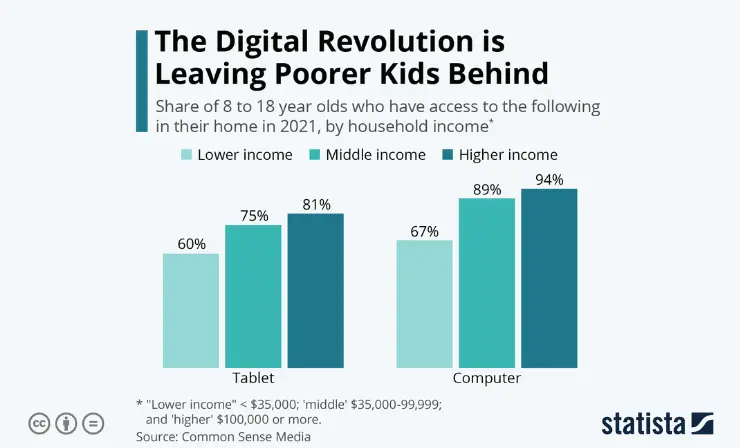
In the discourse surrounding educational equity, homework emerges as a factor exacerbating socioeconomic disparities, particularly affecting students from lower-income families and those with less supportive home environments. While homework is often justified as a means to raise academic standards and promote equity, its real-world impact tells a different story.
The inequitable burden of homework becomes starkly evident when considering the resources required to complete it, especially in the digital age. Homework today often necessitates a computer and internet access – resources not readily available to all students. This digital divide significantly disadvantages students from lower-income backgrounds, deepening the chasm between them and their more affluent peers.
Key points highlighting the disparities:
- Digital Inequity: Many students lack access to necessary technology for homework, with low-income families disproportionately affected.
- Impact of COVID-19: The pandemic exacerbated these disparities as education shifted online, revealing the extent of the digital divide.
- Educational Outcomes Tied to Income: A critical indicator of college success is linked more to family income levels than to rigorous academic preparation. Research indicates that while 77% of students from high-income families graduate from highly competitive colleges, only 9% from low-income families achieve the same . This disparity suggests that the pressure of heavy homework loads, rather than leveling the playing field, may actually hinder the chances of success for less affluent students.
Moreover, the approach to homework varies significantly across different types of schools. While some rigorous private and preparatory schools in both marginalized and affluent communities assign extreme levels of homework, many progressive schools focusing on holistic learning and self-actualization opt for no homework, yet achieve similar levels of college and career success. This contrast raises questions about the efficacy and necessity of heavy homework loads in achieving educational outcomes.
The issue of homework and its inequitable impact is not just an academic concern; it is a reflection of broader societal inequalities. By continuing practices that disproportionately burden students from less privileged backgrounds, the educational system inadvertently perpetuates the very disparities it seeks to overcome.
3. Negative Impact on Family Dynamics
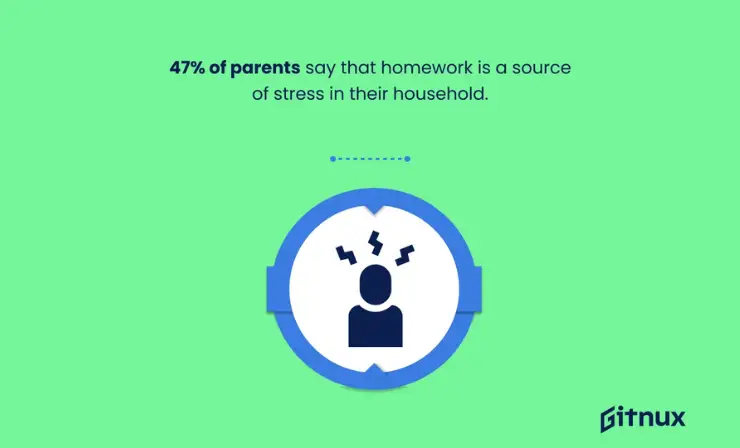
Homework, a staple of the educational system, is often perceived as a necessary tool for academic reinforcement. However, its impact extends beyond the realm of academics, significantly affecting family dynamics. The negative repercussions of homework on the home environment have become increasingly evident, revealing a troubling pattern that can lead to conflict, mental health issues, and domestic friction.
A study conducted in 2015 involving 1,100 parents sheds light on the strain homework places on family relationships. The findings are telling:
- Increased Likelihood of Conflicts: Families where parents did not have a college degree were 200% more likely to experience fights over homework.
- Misinterpretations and Misunderstandings: Parents often misinterpret their children’s difficulties with homework as a lack of attention in school, leading to feelings of frustration and mistrust on both sides.
- Discriminatory Impact: The research concluded that the current approach to homework disproportionately affects children whose parents have lower educational backgrounds, speak English as a second language, or belong to lower-income groups.
The issue is not confined to specific demographics but is a widespread concern. Samantha Hulsman, a teacher featured in Education Week Teacher , shared her personal experience with the toll that homework can take on family time. She observed that a seemingly simple 30-minute assignment could escalate into a three-hour ordeal, causing stress and strife between parents and children. Hulsman’s insights challenge the traditional mindset about homework, highlighting a shift towards the need for skills such as collaboration and problem-solving over rote memorization of facts.
The need of the hour is to reassess the role and amount of homework assigned to students. It’s imperative to find a balance that facilitates learning and growth without compromising the well-being of the family unit. Such a reassessment would not only aid in reducing domestic conflicts but also contribute to a more supportive and nurturing environment for children’s overall development.
4. Consumption of Free Time
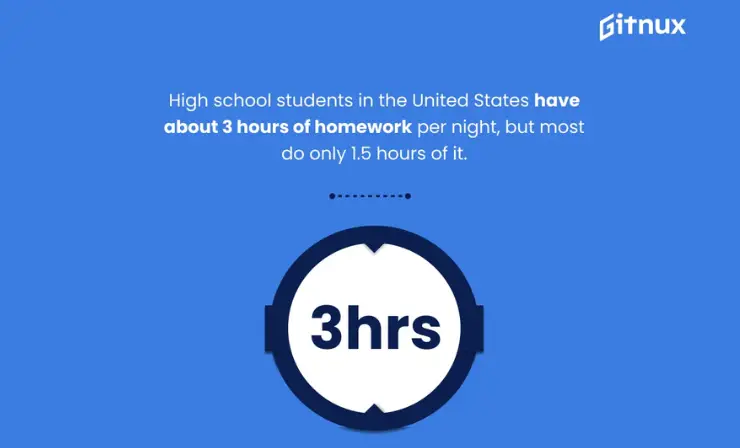
In recent years, a growing chorus of voices has raised concerns about the excessive burden of homework on students, emphasizing how it consumes their free time and impedes their overall well-being. The issue is not just the quantity of homework, but its encroachment on time that could be used for personal growth, relaxation, and family bonding.
Authors Sara Bennett and Nancy Kalish , in their book “The Case Against Homework,” offer an insightful window into the lives of families grappling with the demands of excessive homework. They share stories from numerous interviews conducted in the mid-2000s, highlighting the universal struggle faced by families across different demographics. A poignant account from a parent in Menlo Park, California, describes nightly sessions extending until 11 p.m., filled with stress and frustration, leading to a soured attitude towards school in both the child and the parent. This narrative is not isolated, as about one-third of the families interviewed expressed feeling crushed by the overwhelming workload.
Key points of concern:
- Excessive Time Commitment: Students, on average, spend over 6 hours in school each day, and homework adds significantly to this time, leaving little room for other activities.
- Impact on Extracurricular Activities: Homework infringes upon time for sports, music, art, and other enriching experiences, which are as crucial as academic courses.
- Stifling Creativity and Self-Discovery: The constant pressure of homework limits opportunities for students to explore their interests and learn new skills independently.
The National Education Association (NEA) and the National PTA (NPTA) recommend a “10 minutes of homework per grade level” standard, suggesting a more balanced approach. However, the reality often far exceeds this guideline, particularly for older students. The impact of this overreach is profound, affecting not just academic performance but also students’ attitudes toward school, their self-confidence, social skills, and overall quality of life.
Furthermore, the intense homework routine’s effectiveness is doubtful, as it can overwhelm students and detract from the joy of learning. Effective learning builds on prior knowledge in an engaging way, but excessive homework in a home setting may be irrelevant and uninteresting. The key challenge is balancing homework to enhance learning without overburdening students, allowing time for holistic growth and activities beyond academics. It’s crucial to reassess homework policies to support well-rounded development.
5. Challenges for Students with Learning Disabilities
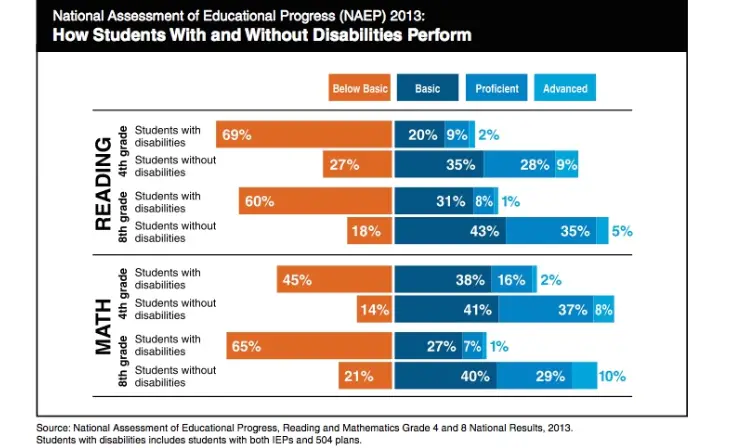
Homework, a standard educational tool, poses unique challenges for students with learning disabilities, often leading to a frustrating and disheartening experience. These challenges go beyond the typical struggles faced by most students and can significantly impede their educational progress and emotional well-being.
Child psychologist Kenneth Barish’s insights in Psychology Today shed light on the complex relationship between homework and students with learning disabilities:
- Homework as a Painful Endeavor: For students with learning disabilities, completing homework can be likened to “running with a sprained ankle.” It’s a task that, while doable, is fraught with difficulty and discomfort.
- Misconceptions about Laziness: Often, children who struggle with homework are perceived as lazy. However, Barish emphasizes that these students are more likely to be frustrated, discouraged, or anxious rather than unmotivated.
- Limited Improvement in School Performance: The battles over homework rarely translate into significant improvement in school for these children, challenging the conventional notion of homework as universally beneficial.
These points highlight the need for a tailored approach to homework for students with learning disabilities. It’s crucial to recognize that the traditional homework model may not be the most effective or appropriate method for facilitating their learning. Instead, alternative strategies that accommodate their unique needs and learning styles should be considered.
In conclusion, the conventional homework paradigm needs reevaluation, particularly concerning students with learning disabilities. By understanding and addressing their unique challenges, educators can create a more inclusive and supportive educational environment. This approach not only aids in their academic growth but also nurtures their confidence and overall development, ensuring that they receive an equitable and empathetic educational experience.
6. Critique of Underlying Assumptions about Learning
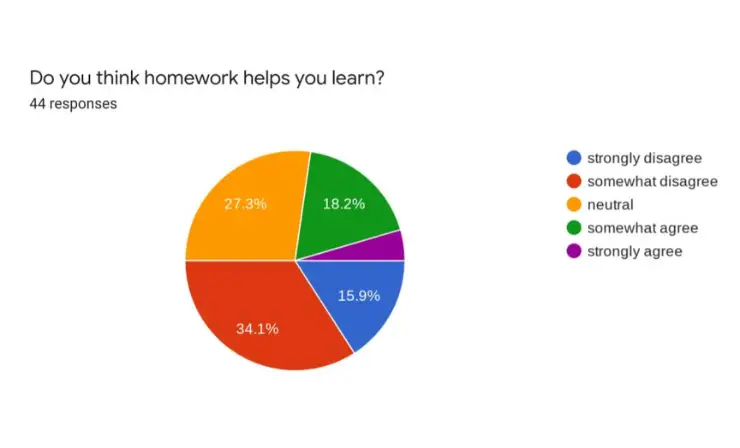
The longstanding belief in the educational sphere that more homework automatically translates to more learning is increasingly being challenged. Critics argue that this assumption is not only flawed but also unsupported by solid evidence, questioning the efficacy of homework as an effective learning tool.
Alfie Kohn , a prominent critic of homework, aptly compares students to vending machines in this context, suggesting that the expectation of inserting an assignment and automatically getting out of learning is misguided. Kohn goes further, labeling homework as the “greatest single extinguisher of children’s curiosity.” This critique highlights a fundamental issue: the potential of homework to stifle the natural inquisitiveness and love for learning in children.
The lack of concrete evidence supporting the effectiveness of homework is evident in various studies:
- Marginal Effectiveness of Homework: A study involving 28,051 high school seniors found that the effectiveness of homework was marginal, and in some cases, it was counterproductive, leading to more academic problems than solutions.
- No Correlation with Academic Achievement: Research in “ National Differences, Global Similarities ” showed no correlation between homework and academic achievement in elementary students, and any positive correlation in middle or high school diminished with increasing homework loads.
- Increased Academic Pressure: The Teachers College Record published findings that homework adds to academic pressure and societal stress, exacerbating performance gaps between students from different socioeconomic backgrounds.
These findings bring to light several critical points:
- Quality Over Quantity: According to a recent article in Monitor on Psychology , experts concur that the quality of homework assignments, along with the quality of instruction, student motivation, and inherent ability, is more crucial for academic success than the quantity of homework.
- Counterproductive Nature of Excessive Homework: Excessive homework can lead to more academic challenges, particularly for students already facing pressures from other aspects of their lives.
- Societal Stress and Performance Gaps: Homework can intensify societal stress and widen the academic performance divide.
The emerging consensus from these studies suggests that the traditional approach to homework needs rethinking. Rather than focusing on the quantity of assignments, educators should consider the quality and relevance of homework, ensuring it truly contributes to learning and development. This reassessment is crucial for fostering an educational environment that nurtures curiosity and a love for learning, rather than extinguishing it.
7. Issues with Homework Enforcement, Reliability, and Temptation to Cheat
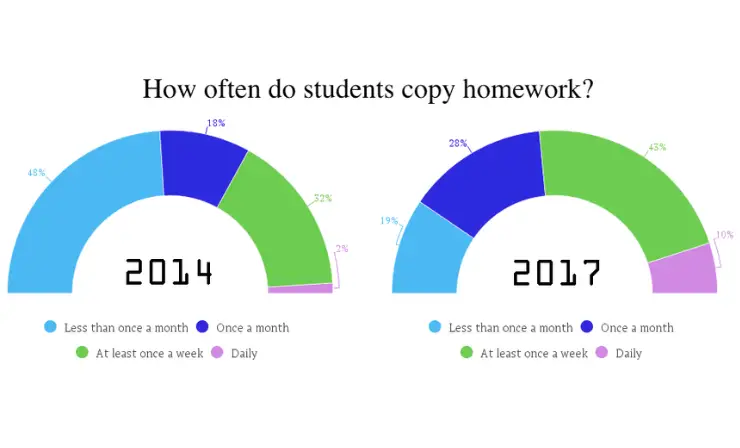
In the academic realm, the enforcement of homework is a subject of ongoing debate, primarily due to its implications on student integrity and the true value of assignments. The challenges associated with homework enforcement often lead to unintended yet significant issues, such as cheating, copying, and a general undermining of educational values.
Key points highlighting enforcement challenges:
- Difficulty in Enforcing Completion: Ensuring that students complete their homework can be a complex task, and not completing homework does not always correlate with poor grades.
- Reliability of Homework Practice: The reliability of homework as a practice tool is undermined when students, either out of desperation or lack of understanding, choose shortcuts over genuine learning. This approach can lead to the opposite of the intended effect, especially when assignments are not well-aligned with the students’ learning levels or interests.
- Temptation to Cheat: The issue of cheating is particularly troubling. According to a report by The Chronicle of Higher Education , under the pressure of at-home assignments, many students turn to copying others’ work, plagiarizing, or using creative technological “hacks.” This tendency not only questions the integrity of the learning process but also reflects the extreme stress that homework can induce.
- Parental Involvement in Completion: As noted in The American Journal of Family Therapy , this raises concerns about the authenticity of the work submitted. When parents complete assignments for their children, it not only deprives the students of the opportunity to learn but also distorts the purpose of homework as a learning aid.
In conclusion, the challenges of homework enforcement present a complex problem that requires careful consideration. The focus should shift towards creating meaningful, manageable, and quality-driven assignments that encourage genuine learning and integrity, rather than overwhelming students and prompting counterproductive behaviors.
Addressing Opposing Views on Homework Practices
While opinions on homework policies are diverse, understanding different viewpoints is crucial. In the following sections, we will examine common arguments supporting homework assignments, along with counterarguments that offer alternative perspectives on this educational practice.
1. Improvement of Academic Performance

Homework is commonly perceived as a means to enhance academic performance, with the belief that it directly contributes to better grades and test scores. This view posits that through homework, students reinforce what they learn in class, leading to improved understanding and retention, which ultimately translates into higher academic achievement.
However, the question of why students should not have homework becomes pertinent when considering the complex relationship between homework and academic performance. Studies have indicated that excessive homework doesn’t necessarily equate to higher grades or test scores. Instead, too much homework can backfire, leading to stress and fatigue that adversely affect a student’s performance. Reuters highlights an intriguing correlation suggesting that physical activity may be more conducive to academic success than additional homework, underscoring the importance of a holistic approach to education that prioritizes both physical and mental well-being for enhanced academic outcomes.
2. Reinforcement of Learning
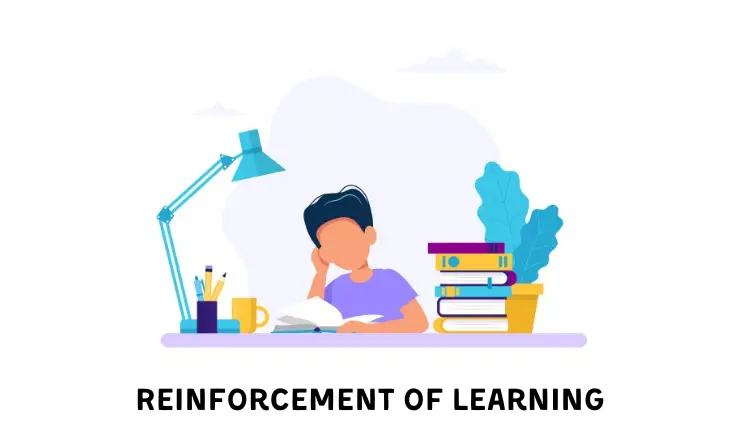
Homework is traditionally viewed as a tool to reinforce classroom learning, enabling students to practice and retain material. However, research suggests its effectiveness is ambiguous. In instances where homework is well-aligned with students’ abilities and classroom teachings, it can indeed be beneficial. Particularly for younger students , excessive homework can cause burnout and a loss of interest in learning, counteracting its intended purpose.
Furthermore, when homework surpasses a student’s capability, it may induce frustration and confusion rather than aid in learning. This challenges the notion that more homework invariably leads to better understanding and retention of educational content.
3. Development of Time Management Skills

Homework is often considered a crucial tool in helping students develop important life skills such as time management and organization. The idea is that by regularly completing assignments, students learn to allocate their time efficiently and organize their tasks effectively, skills that are invaluable in both academic and personal life.
However, the impact of homework on developing these skills is not always positive. For younger students, especially, an overwhelming amount of homework can be more of a hindrance than a help. Instead of fostering time management and organizational skills, an excessive workload often leads to stress and anxiety . These negative effects can impede the learning process and make it difficult for students to manage their time and tasks effectively, contradicting the original purpose of homework.
4. Preparation for Future Academic Challenges

Homework is often touted as a preparatory tool for future academic challenges that students will encounter in higher education and their professional lives. The argument is that by tackling homework, students build a foundation of knowledge and skills necessary for success in more advanced studies and in the workforce, fostering a sense of readiness and confidence.
Contrarily, an excessive homework load, especially from a young age, can have the opposite effect . It can instill a negative attitude towards education, dampening students’ enthusiasm and willingness to embrace future academic challenges. Overburdening students with homework risks disengagement and loss of interest, thereby defeating the purpose of preparing them for future challenges. Striking a balance in the amount and complexity of homework is crucial to maintaining student engagement and fostering a positive attitude towards ongoing learning.
5. Parental Involvement in Education
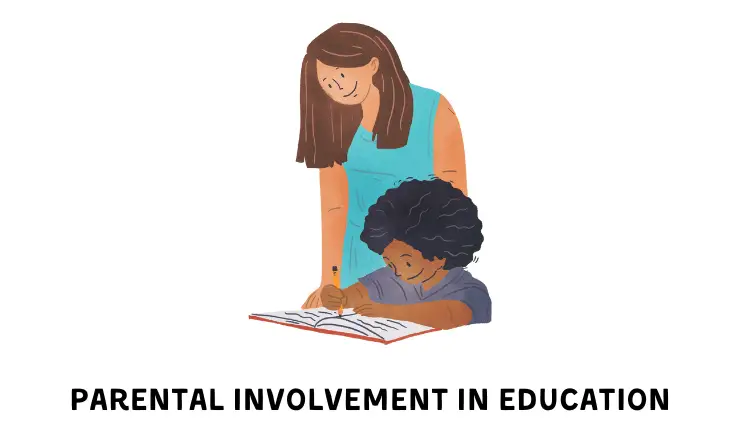
Homework often acts as a vital link connecting parents to their child’s educational journey, offering insights into the school’s curriculum and their child’s learning process. This involvement is key in fostering a supportive home environment and encouraging a collaborative relationship between parents and the school. When parents understand and engage with what their children are learning, it can significantly enhance the educational experience for the child.
However, the line between involvement and over-involvement is thin. When parents excessively intervene by completing their child’s homework, it can have adverse effects . Such actions not only diminish the educational value of homework but also rob children of the opportunity to develop problem-solving skills and independence. This over-involvement, coupled with disparities in parental ability to assist due to variations in time, knowledge, or resources, may lead to unequal educational outcomes, underlining the importance of a balanced approach to parental participation in homework.
Exploring Alternatives to Homework and Finding a Middle Ground

In the ongoing debate about the role of homework in education, it’s essential to consider viable alternatives and strategies to minimize its burden. While completely eliminating homework may not be feasible for all educators, there are several effective methods to reduce its impact and offer more engaging, student-friendly approaches to learning.
Alternatives to Traditional Homework
- Project-Based Learning: This method focuses on hands-on, long-term projects where students explore real-world problems. It encourages creativity, critical thinking, and collaborative skills, offering a more engaging and practical learning experience than traditional homework. For creative ideas on school projects, especially related to the solar system, be sure to explore our dedicated article on solar system projects .
- Flipped Classrooms: Here, students are introduced to new content through videos or reading materials at home and then use class time for interactive activities. This approach allows for more personalized and active learning during school hours.
- Reading for Pleasure: Encouraging students to read books of their choice can foster a love for reading and improve literacy skills without the pressure of traditional homework assignments. This approach is exemplified by Marion County, Florida , where public schools implemented a no-homework policy for elementary students. Instead, they are encouraged to read nightly for 20 minutes . Superintendent Heidi Maier’s decision was influenced by research showing that while homework offers minimal benefit to young students, regular reading significantly boosts their learning. For book recommendations tailored to middle school students, take a look at our specially curated article .
Ideas for Minimizing Homework
- Limiting Homework Quantity: Adhering to guidelines like the “ 10-minute rule ” (10 minutes of homework per grade level per night) can help ensure that homework does not become overwhelming.
- Quality Over Quantity: Focus on assigning meaningful homework that is directly relevant to what is being taught in class, ensuring it adds value to students’ learning.
- Homework Menus: Offering students a choice of assignments can cater to diverse learning styles and interests, making homework more engaging and personalized.
- Integrating Technology: Utilizing educational apps and online platforms can make homework more interactive and enjoyable, while also providing immediate feedback to students. To gain deeper insights into the role of technology in learning environments, explore our articles discussing the benefits of incorporating technology in classrooms and a comprehensive list of educational VR apps . These resources will provide you with valuable information on how technology can enhance the educational experience.
For teachers who are not ready to fully eliminate homework, these strategies offer a compromise, ensuring that homework supports rather than hinders student learning. By focusing on quality, relevance, and student engagement, educators can transform homework from a chore into a meaningful component of education that genuinely contributes to students’ academic growth and personal development. In this way, we can move towards a more balanced and student-centric approach to learning, both in and out of the classroom.
Useful Resources
- Is homework a good idea or not? by BBC
- The Great Homework Debate: What’s Getting Lost in the Hype
- Alternative Homework Ideas
The evidence and arguments presented in the discussion of why students should not have homework call for a significant shift in homework practices. It’s time for educators and policymakers to rethink and reformulate homework strategies, focusing on enhancing the quality, relevance, and balance of assignments. By doing so, we can create a more equitable, effective, and student-friendly educational environment that fosters learning, well-being, and holistic development.
- “Here’s what an education expert says about that viral ‘no-homework’ policy”, Insider
- “John Hattie on BBC Radio 4: Homework in primary school has an effect of zero”, Visible Learning
- HowtoLearn.com
- “Time Spent On Homework Statistics [Fresh Research]”, Gitnux
- “Stress in America”, American Psychological Association (APA)
- “Homework hurts high-achieving students, study says”, The Washington Post
- “National Sleep Foundation’s updated sleep duration recommendations: final report”, National Library of Medicine
- “A multi-method exploratory study of stress, coping, and substance use among high school youth in private schools”, Frontiers
- “The Digital Revolution is Leaving Poorer Kids Behind”, Statista
- “The digital divide has left millions of school kids behind”, CNET
- “The Digital Divide: What It Is, and What’s Being Done to Close It”, Investopedia
- “COVID-19 exposed the digital divide. Here’s how we can close it”, World Economic Forum
- “PBS NewsHour: Biggest Predictor of College Success is Family Income”, America’s Promise Alliance
- “Homework and Family Stress: With Consideration of Parents’ Self Confidence, Educational Level, and Cultural Background”, Taylor & Francis Online
- “What Do You Mean My Kid Doesn’t Have Homework?”, EducationWeek
- “Excerpt From The Case Against Homework”, Penguin Random House Canada
- “How much homework is too much?”, neaToday
- “The Nation’s Report Card: A First Look: 2013 Mathematics and Reading”, National Center for Education Statistics
- “Battles Over Homework: Advice For Parents”, Psychology Today
- “How Homework Is Destroying Teens’ Health”, The Lion’s Roar
- “ Breaking the Homework Habit”, Education World
- “Testing a model of school learning: Direct and indirect effects on academic achievement”, ScienceDirect
- “National Differences, Global Similarities: World Culture and the Future of Schooling”, Stanford University Press
- “When school goes home: Some problems in the organization of homework”, APA PsycNet
- “Is homework a necessary evil?”, APA PsycNet
- “Epidemic of copying homework catalyzed by technology”, Redwood Bark
- “High-Tech Cheating Abounds, and Professors Bear Some Blame”, The Chronicle of Higher Education
- “Homework and Family Stress: With Consideration of Parents’ Self Confidence, Educational Level, and Cultural Background”, ResearchGate
- “Kids who get moving may also get better grades”, Reuters
- “Does Homework Improve Academic Achievement? A Synthesis of Research, 1987–2003”, SageJournals
- “Is it time to get rid of homework?”, USAToday
- “Stanford research shows pitfalls of homework”, Stanford
- “Florida school district bans homework, replaces it with daily reading”, USAToday
- “Encouraging Students to Read: Tips for High School Teachers”, wgu.edu
- Recent Posts

Simona Johnes is the visionary being the creation of our project. Johnes spent much of her career in the classroom working with students. And, after many years in the classroom, Johnes became a principal.
- Exploring the Evidence: 7 Comprehensive Reasons Why School Should Start Later for Enhanced Student Well-being and Academic Success - February 15, 2024
- Why Students Should Learn a Second Language for Future Success: Exploring the 7 Benefits - February 12, 2024
- 9 Reasons Why Teachers Should Accept Late Work: Balancing Discipline and Flexibility in Education - January 31, 2024
Leave a Comment Cancel reply
Save my name, email, and website in this browser for the next time I comment.

More From Forbes
The battle over gen z minds - sad, bad or mad.
- Share to Facebook
- Share to Twitter
- Share to Linkedin
Sad, Bad or Mad? Or None of the Above?
There’s a global debate raging about the state of our youth. On the one hand, there are the influential voices of two academics, Jonathan Haidt and Jean Twenge, raising the alarm that kids everywhere are cracking under the pressure of a technological revolution they aren’t wired to manage. On the other, a growing list of opposing voices, most recently led by a cover story in The Economist, suggesting that on many measures the kids are doing better than we think.
Who’s right? Only time will tell, but here are some of the key data points being argued over – and who is taking which side. Telling in itself.
Happy or Sad?
The heart of the debate is the sudden increase in mental health issues faced by young people aged between 12 and 27, aka Gen Z. Social psychologist Jonathan Haidt is leading the charge, pointing the finger at social media for making our kids, especially girls, sick. His book, The Anxious Generation: How the Great Rewiring of Childhood is Causing an Epidemic of Mental Illness , charts the rise in mental health issues among Gen Z starting in 2012. That was the year Apple launched the iPhone. Haidt is leading a campaign to restrict social media access and protect young brains from the pull of unregulated tech giants and their algorithms designed for addiction. He pulls together research and proof of the causation between social media and mental health, and is sharing it all online. In particular he points to four, inter-related “foundational harms”: social deprivation, lack of sleep, attention fragmentation and addiction - and is working to “bring childhood back to earth.”
Jean Twenge is a psychology professor who’s built a career on analysing generational traits and trends. Her most recent book is lengthily titled IGen: Why Today’s Kids Are Growing Up Less Rebellious, More Tolerant, less Happy and Completely Unprepared for Adulthood . That pretty well sums up her thesis which she scrupulously documents with mountains of data charting “39 million people” through dozens of analyses and graphs. She profiles Gen Z (who she calls iGen) across a series of ‘I’ words: “Internet, No In-Person, Insecure, Irreligious, Insulated, Indefinite, Inclusive, and Independent.” In her substack, she shares the latest statistics on suicide, showing the fast-increasing levels of young American men in their 20s taking their own lives, overtaking middle-aged men. It’s not an encouraging portrait.
Both of these positions come from American writers and thinkers, even though they are casting their research nets globally. One of the challenges for the rest of the world is to disentangle the cultural and generational arguments of causality.
300 Billion Perfect Storm Bitcoin Price Crash Under 60 000 Suddenly Accelerates As Ethereum XRP And Crypto Brace For Shock Fed Flip
Police deployed to ucla protest clashes after nypd arrests pro palestinian demonstrators at columbia, the top 10 richest people in the world (may 2024).
Purposefully striding into the boxing ring on the opposing side is the British-based Economist magazine, with a recent cover story titled Reasons to be Cheerful About Generation Z – They Are Not Doomed to Be Poor and Anxious . In a series of articles, The Economist offers a different perspective on this group of emerging adults now entering the workforce. It contexts the conversation with a global look at the two billion young people born between 1997 and 2012 who are being debated under the single, simplifying label of ‘Gen Z.’ One of the key points they underline is that four-fifths of this cohort live in emerging economies. Unlike the American youthscape currently dominating much of the debate, they suggest the majority of these ‘young’ are likely to grow up better off than their parents – “richer, healthier and more educated.”
Everyone is getting in on the argument. Gallup (sponsored by the Walton Family Foundation) just published a report on Youth Happiness claiming that 73% of American Gen Zers self-report as being ‘somewhat’ or ‘very’ happy. They also argue that Gen Z adults who are already married and have children are “markedly happier than their peers.” They dig down into the diversity of this huge cohort and note that the one fifth of Gen Zers who identify as LGBT are “16 percentage points less likely to say they are happy than heterosexual Gen Z adults.” It’s perhaps not surprising to note that this research is funded by a family foundation.
Gallup’s data also has happiness declining markedly with… age. While the 12- to 14-year-olds feel pretty good, this plummets to a much lower level after 21. And like most other studies (and aligning with Haidt), this one confirms that the more time kids spend on social media, the more anxious they are. If you read to the end, Gallup agrees that nearly half of Gen Zers report feeling anxious and a quarter feel depressed, which clashes somewhat with their headline claim of majority happiness.
Where most researchers align is both that technology is a major differentiator of this generation, and the more time young people spend online, the more ill-health they suffer. A recent McKinsey study, Gen Z and Mental Health , interviewed 42,000 young people across 26 countries and corroborated the link, but added that in eight countries surveyed, Boomers spent as much time on social media as Gen Zers do. McKinsey puts the separation between healthy and unhealthy usage at two hours per day. Over that level, younger people report more problems. (In Asia, a third of Gen Zers spend six or more hours per day on their phones). But McKinsey focuses on the many positive impacts of technology reported across all generations. More than half of every generation say self-expression and social connectivity are the valued upsides of social media.
So… happy or sad? It seems to depend on a degree of moderation, a balance with other factors - and a 2-hour social media limit.
Connected or Disconnected?
Is Gen Z the most globally connected generation the world has ever seen, able to reach like-minded people across cultures, countries and socio-economic classes in a way no prior generation has even approached? Or are they a lonely, alienated group who spend most of their time online in their rooms as a way to avoid ‘real’ social interactions?
A group of four inter-disciplinary (anthropology, linguistics, sociology and religious studies) professors (from Oxford and Stanford) look at this question in Gen Z, Explained - The Art of Living in a Digital Age. They describe a generation that has much to teach all of us about how to collaborate and thrive in the digital age. They remind us that Gen Z is the first generation connected to 8 billion people across the planet. They are learning to navigate “the vast expansion of information and options on the internet to find like-minded people with whom to cluster and, through such exploration, discover, refine and create their own identities.” Which includes the extraordinary use and attachment to TikTok , now much beloved of some 170 million American users, and where almost a third of 18-to-30 year-olds get their news.
What seems promising in this new age of connectedness is the pent-up demand from people of all ages to work together. A report from CoGenerate ( Is America Ready to Unleash a MultiGenerational Force for Good? ) looks at what it would take to de-silo America’s increasingly age-compartmentalised culture - and how welcome this would be to both young and old. Over 96% of survey respondents think that working inter-generationally would “help solve America’s problems.”
But while connectedness may be reaching new heights and global breadth, others point to an ‘ epidemic of loneliness .’ They share data showing that Gen Z are the loneliest generation alive. That the constant search for convenience is eliminating the pain and promise of human connections – from the supermarket to the school teacher. In Gen Z, Explained , a kindergarten teacher described her 5-year old charges addressing her the way they do Alexa – with no emotion, respect or even acknowledgement that they are addressing another human.
Freya India is a 24-year-old writer who eloquently describes what Gen Z is like - from the inside. She’s just been recruited to join Haidt’s Anxious Generation team. In her substack, GIRLS , she writes that her generation has been hijacked by algorithms and suffers from something called ‘anemoia.’ That’s nostalgia for a time you’ve never even experienced. She describes how Gen Zers are busy watching old video snippets online, yearning for an unimaginable pre-phone time where teens weren’t glued to their phones and can be seen actually talking and relating to each other. She shares her own dystopian world of loneliness and hunger for seemingly impossible connections. Her writing is compelling.
As is that of NYU business school student Bradley Andrews who describes the impact of “uninterrupted continuity” of 24-hour global connectedness in his substack, Prolix . It gives the individual “constant info to consume without the opportunity to truly understand or integrate it. It simultaneously lacks completion and prevents wholeness. Uninterrupted discontinuity is the psychological equivalent of hitting lightspeed in a hamster wheel.”
Haidt suggests we listen to what the kids are telling us. That not all truth is limited to statistics and numbers. And that connectedness has consequences.
But one thing is perhaps easier to measure – that’s money.
Rich or Poor?
The Economist argues counter-intuitively (and in the face of much self-reported perception of financial distress) that this generation is “unprecedently rich” - that both Millennials and Boomers were poorer than Gen Z at a similar age and stage. They remind us that of the 250 million people behind the Gen Z label in the US, half are now working [?], and that ‘Zoomers’ already account for 6,000 American CEOs. “The pushing and shoving over Gen Z’s anxiety,” writes the magazine, “has obscured another way in which the cohort is distinct. In financial terms, Gen Z is doing extraordinarily well.”
Because of demographic shifts and fewer young people relative to older generations, they are heading into tight labour markets where they have more bargaining power – and an increased interest in labour organising. The Economist points to outsized Gen Z wage growth in a number of countries, and the highest ‘young person premium’ since reliable data started. Even given educational debt and sky-high housing prices, they say that Americans under 25 spent 43% of post-tax income on housing and education (including interest) – slightly below the average for the same age group between 1989 and 2019.
Gen Z, they add, see working as a right, rather than the privilege that Millennials graduating during the financial crisis did. So they are more demanding, less loyal - and also far less entrepreneurial. They are also less convinced of the need for (and the cost of) graduate degrees and are increasingly leaning towards vocational training – and in-demand skills.
Yet most Gen Zers don’t feel rich. The overwhelming narrative has been that they are caught between the impossible pressures of cost of living crises , unattainable housing prices and shackled by educational debt. But other reporting finds them shunning college and the associated debt for other qualifications that are more pragmatically linked to old fashioned income-generation .
Ed Huang , Co-Founder and Executive Director at Resume Genius , points to the 158% jump in US college tuition fees to explain Gen Z’s new choices. "It’s clear that younger generations like Gen Z are gravitating toward vocational training not just for its affordability but because it aligns closely with their realistic assessments of what today's economy looks like. This generation — what some are calling the ' toolbelt generation ' — is acutely aware of the uncertainties that lie ahead, including job security and the ability to afford a home, concerns that weren’t as pronounced for previous generations at the same age."
Tech Enabled or Addled?
The heart of the debate over this digital-age generation is whether technology – and the social media it has spawned – is making or breaking them. Gen Z now accounts for 30% of the global population and represent 27% of the workforce in 2025. Almost all of them (98%) have a smartphone. And their state of mind is leaving home and schools and starting to impact the workplace - and the economy.
Most people refer to this generation as ‘digital natives,’ scoffs futurist Peter Hinssen , author of The New Normal. But it’s much deeper than that, he suggests. Technology is embedded in the way they live their lives and construct their very identities. They don’t see it as ‘digital’ at all. They navigate the online world more holistically and seamlessly than their elders - but also more knowledgeably. They work, shop, learn and love online. Having grown up with the stuff, they may also know better than older folk how to limit its excesses in their own lives. They are starting to curate their online existences more intentionally and may turn to trends of downsizing their public online presences.
George Ploubidis , Professor of Population Health and Statistics at University College London’s Social Research Institute, doesn’t think social media is the underlying cause – or maybe just a part of many inter-related factors. His theories zoom out to include a life-course perspective, noting that Gen Z had very different childhoods than their predecessors. He points to a combination of entirely other factors: helicopter parenting, security concerns, the lack of face-to-face interactive play with other children, and the growing inequalities that exist not only between generations but also within them .
How much of the rising mental health crisis is caused by tech, and how much of it is fuelled by what is going on in the world as these kids emerge into adolescence and adulthood: geopolitical unrest, wars and disruptions, political polarisation, financial worries, educational interruptions during the pandemic and the constantly darkening cloud of climate change?
Deep in the McKinsey report cited earlier is this short passage: “Many Gen Z respondents reported experiencing stress, sadness, anger, and frustration due to climate change and its related disasters. More than 50 percent of total respondents expressed fear and anxiety about the future, with Gen Z demonstrating greater concern than other generations. More than 50 percent of all respondents agree or strongly agree that “government leaders and companies have failed to take care of the planet.”
Roberta Katz, one of the co-authors of Gen Z, Explained, says that “as much as postmillenials have to learn, they also have much to teach. They are trying to humanise an intractable, inhuman world that seems to be headed for disaster.”
How do we measure the impact of the social, economic and political climate they are growing up in compared to the technology they are using to learn about it, discuss it and start to reshape it?
Bradley Schurman of Human Change suggests that Gen Z most resembles the ‘Greatest Generation’, born almost exactly a century before Gen Z (1901 to 1927). They experienced parallel pressures. He outlines them his NewRulesMedia substack:
- INEQUALITY : a period of extreme income inequality during the high-flying 1920s, followed by the Crash and the Great Depression.
- PANDEMICS : The Spanish Flu epidemic of 1918-20 that killed many more millions than Covid.
- AUTHORITARIANISM : The rise of Nazism and Stalinism, the attack on Pearl Harbour and two World Wars.
- NEW MEDIA : The emergence of new media like radio and film that were quickly used and manipulated by authoritarian powers for propaganda.
The Greatest Generation, forged in fire, became a force for extraordinary change and statesmanship globally, following World War II. Will Gen Z, now flexing its activist muscles on campuses across the US and in emerging countries around the globe do the same? What will their impact be on the mass of 2024 elections they will increasingly decide (including whether or not they vote)? For sure, their ability to harness social media and create communities of influence will reshape the pace and content of politics and policy for decades to come.
Confusion Reigns - and Distracts
The scientists, psychologists, sociologists and economists are not yet aligned on the causes - or consequences - of what’s ailing our global young. But there is growing agreement that the kids aren’t OK. UCL’s Ploubidis refers to the phenomenon, in a phone interview, as ‘generational drift.’ That each generation is slightly worse off in a variety of ways than the one preceding it.
These issues don’t usually get the attention they deserve, he notes, until it impacts the economy. That’s what’s happening now. As Gen Z enters the workforce, companies, consultants and governments are waking up to Gen Z’s unprecedented levels of mental health challenges. If we don’t find, address and accompany the issue , the long-term impacts will not be pretty. But focusing the conversation on a single cause like social media, he says, may not be doing them – or us - a service. It may lead to insufficient or ineffective solutions like banning smartphones until certain ages.
Candice L. Odgers , associate dean for research and a professor of psychological science and informatics at the University of California, Irvine, agrees. She recently published a review of Haidt’s book in Nature warning against over-blaming tech and social media for the state of the world’s young. She says that this allows us to take our eye off the ball of other potential causes – and solutions – too quickly. “We have a generation in crisis,” she writes, “and in desperate need of the best of what science and evidence-based solutions can offer. Unfortunately, our time is being spent telling stories that are unsupported by research and that do little to support young people who need, and deserve, more.”
Including what we call the people most affected, and lumping all the issues under the ‘Gen Z’ label. Pew Research has announced it’s giving up on generational labels altogether. Pew says they have been over-hyped, over-sold and under-researched. They note that “generational research has become a crowded arena. The field has been flooded with content that’s often sold as research but is more like clickbait or marketing mythology.” So they won’t be calling them Gen Z anymore.
But whatever we call them (or don’t), our kids may need better help than we even know how to define. It’s complex, contradictory and will dominate media columns for some time to come. No matter your age, the health of our global young will mark your future. It’s time the grown-ups do their homework.

- Editorial Standards
- Reprints & Permissions
Numbers, Facts and Trends Shaping Your World
Read our research on:
Full Topic List
Regions & Countries
- Publications
- Our Methods
- Short Reads
- Tools & Resources
Read Our Research On:
In Tight Presidential Race, Voters Are Broadly Critical of Both Biden and Trump
About half of voters say that, if given the chance, they would replace both candidates on the ballot, table of contents.
- The state of the 2024 presidential race
- Other findings: Biden’s job approval ticks up, Trump’s election-related criminal charges
- Educational differences in candidate support
- What are 2020 voters’ preferences today?
- How Biden’s supporters view his personal traits
- How Trump’s supporters view his personal traits
- Views of Biden’s presidency and retrospective evaluations of Trump’s time in office
- Attention to the candidates
- Does it matter who wins?
- What if voters could change the presidential ballot?
- How important is it for the losing candidate to publicly acknowledge the winner?
- 4. Joe Biden’s approval ratings
- Acknowledgments
- The American Trends Panel survey methodology
- Validated voters

Pew Research Center conducted this study to understand voters’ views on the 2024 presidential election, as well how the public views President Joe Biden. For this analysis, we surveyed 8,709 adults – including 7,166 registered voters – from April 8 to April 14, 2024. Everyone who took part in this survey is a member of the Center’s American Trends Panel (ATP), an online survey panel that is recruited through national, random sampling of residential addresses. This way nearly all U.S. adults have a chance of selection. The survey is weighted to be representative of the U.S. adult population by gender, race, ethnicity, partisan affiliation, education and other categories. Read more about the ATP’s methodology .
Here are the questions used for this report , along with responses, and the survey methodology .
As the 2024 presidential race heats up, American voters face a similar set of choices as they did four years ago – and many are not happy about it.
With the election still more than six months away, a new Pew Research Center survey finds that the presidential race is virtually tied : 49% of registered voters favor Donald Trump or lean toward voting for him, while 48% support or lean toward Joe Biden.
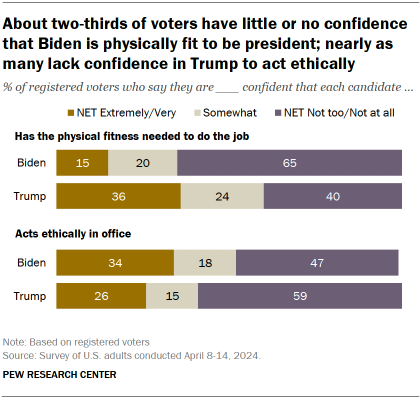
A defining characteristic of the contest is that voters overall have little confidence in either candidate across a range of key traits, including fitness for office, personal ethics and respect for democratic values.
Where Trump has the advantage: More than a third of voters say they are extremely or very confident that Trump has the physical fitness (36%) and mental fitness (38%) needed to do the job of president.
Far fewer say the same of Biden (15% are at least very confident in his physical fitness; 21% are extremely or very confident in his mental fitness). Majorities say they are not too or not at all confident in Biden’s physical and mental fitness.
Where Biden has the advantage: More voters are extremely or very confident in Biden (34%) than in Trump (26%) to act ethically in office. And while 38% say they are at least very confident in Biden to respect the country’s democratic values, fewer (34%) express that level of confidence in Trump. The survey was conducted before the start of Trump’s “hush money” trial in New York City .
( Read more about voters’ views of Biden and Trump in Chapter 2. )
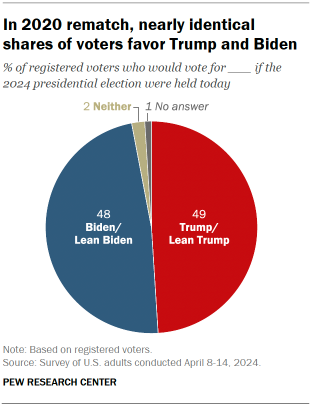
The new Center survey of 8,709 adults – including 7,166 registered voters – conducted April 8-14, 2024, finds large divides in voters’ candidate preference by age, education, and race and ethnicity. As was the case in 2020, younger voters and those with a four-year college degree are more likely to favor Biden than Trump.
Older voters and those with no college degree favor Trump by large margins.
Among racial and ethnic groups:
- White voters favor Trump (56%) over Biden (42%) by a wide margin.
- Roughly three-quarters of Black voters (77%) support Biden, while 18% back Trump.
- Hispanic voters are more evenly divided – 52% favor Biden, while 44% back Trump.
- Asian voters favor Biden (59%) over Trump (36%).
( Read more about voters’ candidate preferences in Chapter 1. )
Most voters who turned out in 2020 favor the same candidate in 2024. Among validated 2020 voters, overwhelming majorities of those who cast ballots for Biden (91%) and Trump (94%) support the same candidate this year. Registered voters who did not vote in 2020 are about evenly divided: 48% back Trump, while 46% support Biden.
A majority of voters say “it really matters who wins” the 2024 race. Today, 69% of voters say it really matters which candidate wins the presidential contest this November. This is somewhat smaller than the share who said this in April 2020 about that year’s election (74%). Nearly identical shares of Biden’s and Trump’s supporters say the outcome of the presidential race really matters.
About half of voters would replace both Biden and Trump on the 2024 ballot
Reflecting their dissatisfaction with the Biden-Trump matchup, nearly half of registered voters (49%) say that, if they had the ability to decide the major party candidates for the 2024 election, they would replace both Biden and Trump on the ballot .
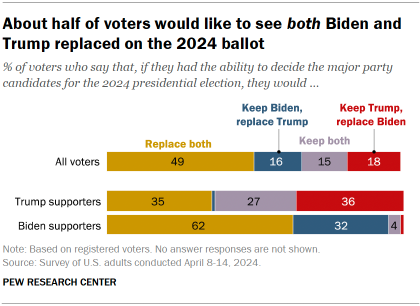
Biden’s supporters are especially likely to say they would replace both candidates if they had the chance. Roughly six-in-ten (62%) express this view, compared with 35% of Trump supporters.
There also are stark age differences in these views: 66% of voters under 30 say they would replace both candidates if they had the chance, compared with 54% of those ages 30 to 49 and fewer than half (43%) of those 50 and older.
( Read more about voters’ feelings toward the upcoming election in Chapter 3. )
Evaluations of the Biden and Trump presidencies
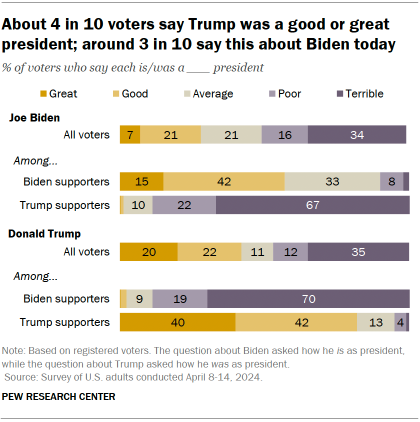
- 42% of voters overall say Trump was a good or great president, while 11% say he was average. This is a modest improvement since March 2021, two months after he left office.
- 28% of voters say Biden is a good or great president, while 21% say he is average. These views are mostly on par with June 2020 assessments of the kind of president Biden would be – but today, a smaller share of voters say he is average.
( Read more about ratings of Biden’s and Trump’s presidencies in Chapter 1. )
- Biden’s approval among the general public: Today, Biden’s approval rating sits at 35% – roughly on par with his rating in January (33%). His job rating has climbed slightly among Democrats over that period, however. Today, 65% of Democrats approve of him – up 4 percentage points since January. ( Read more about Biden’s approval rating in Chapter 4. )
- Conceding the presidential election: A majority of voters say it is important that the losing candidate in November publicly acknowledge the winner as the legitimate president. But Trump’s supporters are far less likely than Biden’s to say it is very important (44% vs. 77%). ( Read more about voters’ views on election concession in Chapter 3. )
Trump’s criminal charges related to the 2020 election
As Trump faces charges that he sought to overturn the outcome of the 2020 election, 45% of Americans say they think Trump’s actions broke the law. This compares with 38% who say his actions did not break the law – including 15% who say his actions were wrong but not illegal, and 23% who say he did nothing wrong. Nearly two-in-ten are not sure.
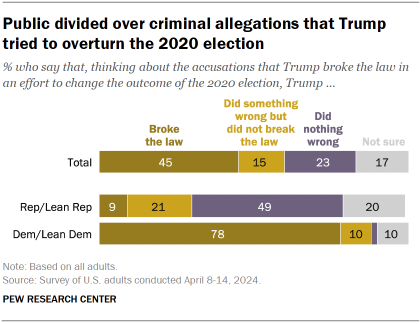
Democrats mostly say Trump broke the law; Republicans are more divided. An overwhelming majority of Democrats and Democratic-leaning independents (78%) say Trump’s actions in seeking to change the outcome of the 2020 election broke the law.
Among Republicans and Republican leaners:
- 49% say Trump did nothing wrong.
- 21% say he did something wrong but did not break the law.
- 9% say Trump broke the law.
- 20% are not sure.
Sign up for our weekly newsletter
Fresh data delivery Saturday mornings
Sign up for The Briefing
Weekly updates on the world of news & information
- Donald Trump
- Election 2024
- Partisanship & Issues
- Presidential Approval
- Voter Demographics
- Voter Participation
Voters’ views of Trump and Biden differ sharply by religion
Changing partisan coalitions in a politically divided nation, about 1 in 4 americans have unfavorable views of both biden and trump, 2024 presidential primary season was one of the shortest in the modern political era, americans more upbeat on the economy; biden’s job rating remains very low, most popular, report materials.
- April 2024 Biden Job Approval Detailed Tables
1615 L St. NW, Suite 800 Washington, DC 20036 USA (+1) 202-419-4300 | Main (+1) 202-857-8562 | Fax (+1) 202-419-4372 | Media Inquiries
Research Topics
- Age & Generations
- Coronavirus (COVID-19)
- Economy & Work
- Family & Relationships
- Gender & LGBTQ
- Immigration & Migration
- International Affairs
- Internet & Technology
- Methodological Research
- News Habits & Media
- Non-U.S. Governments
- Other Topics
- Politics & Policy
- Race & Ethnicity
- Email Newsletters
ABOUT PEW RESEARCH CENTER Pew Research Center is a nonpartisan fact tank that informs the public about the issues, attitudes and trends shaping the world. It conducts public opinion polling, demographic research, media content analysis and other empirical social science research. Pew Research Center does not take policy positions. It is a subsidiary of The Pew Charitable Trusts .
Copyright 2024 Pew Research Center
Terms & Conditions
Privacy Policy
Cookie Settings
Reprints, Permissions & Use Policy
DI men's golf selection show | Golf Channel
🏃♀️ T&F records on notice this postseason
🏐 Men's volleyball semis set
⚾️ Math teacher, pitcher, doctoral student
Mike Lopresti | NCAA.com | April 30, 2024
A math teacher, college pitcher and doctoral student: zach gitschier's unusual journey.

The high school algebra teacher has a fastball that touches 90 and pitches out of the bullpen for Southern New Hampshire. That’s when he isn’t either grading papers or completing his next assignment in pursuit of his doctorate.
Welcome to the unconventional journey of Zach Gitschier.
You might find him teaching a senior class in statistics at Greater Lowell Tech just outside Boston. Think coming in to pitch with the bases loaded is daunting? Try facing a room full of variously motivated and unmotivated teenagers. “I’ve had plenty of jam situations like that,” Gitschier was saying over the phone between classes the other day. “So at this point you let it roll off your back and you get out there and go. But it’s nerve-wracking coming into a classroom when you know nobody.”
Or you might find him racing out of the school parking lot to make the 40-minute drive to campus for practice. Or in the car driving himself to an away game since he wasn’t out of class in time for the team bus. There was the weekend he had to make a 10-hour drive through the snow and sleet to get to a series in Ohio.
Or you might find him late at night, after practice and class prep are over, turning to his own project for his doctorate. “Some days you go in and you’re just exhausted from the day before,” he said. “It’s tough because I’m full-time teaching, I’m also in a doctorate program and I’m playing baseball. There are some days I come home from work and I’m like, 'I need to catch up on sleep for about two hours,' and the next thing you know I’m out four hours. So there’s a lot of catch-up mixed in.”
Or you might actually find him in those moments he loves — on the mound. Between Clark and Southern New Hampshire he has now been at it six years, his college career extended by the pandemic like so many others. He worked a perfect ninth inning just last Sunday against Saint Michael’s, striking out two in a 16-2 victory. That pushed Southern New Hampshire’s record to 28-15. No trifling baseball program, these Penmen. Just last spring they were 44-13 and in the Division II championships.
🔄 CATCH UP: The latest in DII sports
In truth, the season has been something of a struggle for Gitschier. He has struck out 27 batters in 25.2 innings but the earned run average is 9.47. He knows enough about stats to understand that’s not good. But then, it’s a pretty full plate he’s trying to manage. Been that way since he decided to give baseball one final go.
“The biggest deciding factor was my teammates and wanting to be there for those guys and play for them and with them one last time,” he said. There was also a coaching change at Southern New Hampshire and new man Chris Shank and the staff were on board for his quest, which was vital. “They’ve been nothing but accommodating and great for me. In talking with some of my mentors and coaches along the way, the biggest thing was having no regrets about my career. Looking back, yes, it’s been a grind but I wouldn’t want to have it any other way because I would have regretted not playing this year more. "It’s been very hard to manage it all just because I’ve got papers that I have to write, I’ve got to grade, I’ve got to teach, I’ve got to play, I’ve got to work out. I also have to eat and sleep. It really comes down to the support you have.”
That means his family, an understanding girlfriend, his coaches, his teammates, who have even volunteered to help him grade papers. “Being able to go out this way, those guys have been great, they’ve really gone to battle for me in multiple ways. And my coaches, they’ve really meant the world to me. They gave me an opportunity that otherwise I probably wouldn’t have had.”
This road started as a little boy playing backyard Wiffle ball with the neighborhood kids in Lowell. He was a Boston area kid who somehow grew up a New York Mets fan and came from a baseball-minded family, but also one that valued helping others. Gitschier had a younger cousin often visit and they’d have a game where he was the teacher, and she was the math student. Why math? How else can you calculate batting averages and fielding percentages? “That’s really where all the math came into play. Baseball is a numbers game,” he said. “I paid attention to so many stats growing up and now I teach stats. It really started with just being upstairs in a room teaching my little cousin. It’s been a long journey from there.”
He played baseball in high school, went on to Clark University and let his hair grow for more than two years. That’s when the sense of helping others came into play again. When the locks were really flowing — more than 12 inches long — he had them cut off to donate to the Children with Hair Loss Foundation, while also raising $6,000 . That cause provides hair replacement for children who lose their hair because of illness.
Even Southern New Hampshire’s nickname fits the theme of Gitschier’s story. The Penmen. That came from all the Colonial accountants and clerks who banded together, going from their ledgers of numbers to the American Revolution. Now one of the Penmen is a 24-year-old math teacher. “I’m almost at that quarter-life crisis. I’m just glad it hasn’t happened just yet. I’ll possibly be done playing when it does happen,” he said. But in a way, there has also been one last spring of childhood, once he gets out of the car — the one with the school papers in the back seat — and puts on his baseball uniform.
A lot of his students don’t understand all he’s trying to do. And when they try to excuse not having homework finished because they were too busy, well, they’re pleading their case before the wrong judge.
“I was always told that hard work pays off, not just saying it but actually doing it, and it really has. I’m going to end up with a doctorate, full-time teaching and playing baseball,” he said. “There’s very few people I think that can say that they’ve done that. Hopefully it provides (his students) with some hopes and dreams for them to do something similar.
“Some days are tough; most days are really good. The enjoyment you get from helping a student who has struggled their whole life with math, that outweighs the negatives of teaching and all the bad things that come with it. I had friends growing up who were just like them. That’s really where a lot of my drive of being in an inner-city school comes from.
“It’s pretty cool to be able to say I have a game today, And they’re like for what? And then when you say it, they like, you’re still playing college baseball?”
⚾️ Schools with the most DII baseball championships
He is for a little bit longer, anyway. Southern New Hampshire plays Post University Tuesday night then closes its regular season this weekend with a big showdown series against Franklin Pierce, matching the top two teams in the NE10 Conference. Then comes the league tournament. Gitschier thinks he found a flaw in his pitching mechanics that helped him have a strong appearance last weekend and he’s hoping it carries over.
But soon he'll move to the next chapter. He’ll be a pitching coach this summer in the college Futures League for the Westfield Starfires. There is the doctorate to complete and more algebra and statistics to teach. His goal one day is to coach college baseball. All in all, it has been a mission without a lot of downtime.
“I don’t think I’ll understand it until it’s all said and done,” he said. “That this was pretty special to be able to do.”
LATEST DII BASEBALL NEWS
HISTORY: Most national championships | Angelo State wins 2023 title | Full champ history

Run-rule wins for Texas A&M, ECU and Duke highlight new college baseball Power 10 rankings

Top 10 college baseball home run hitters this season

2024 NCAA baseball bracket: Men's College World Series scores, schedule

- Skip to main content
- Keyboard shortcuts for audio player
Despite a fortified border, migrants will keep coming, analysts agree. Here's why.

Sergio Martínez-Beltrán

Border Patrol picks up a group of people seeking asylum from an aid camp near Sasabe, Arizona, on Wednesday, March 13, 2024. Justin Hamel/Bloomberg via Getty Images hide caption
Border Patrol picks up a group of people seeking asylum from an aid camp near Sasabe, Arizona, on Wednesday, March 13, 2024.
The U.S. southern border is as fortified as ever and Texas is carrying out its own enforcement to stop people from crossing illegally, yet observers and analysts agree on this: migrants not only will continue to come, but their numbers will likely increase in the coming months.
The expected surge can be attributed not only to seasonal migration patterns, but an increase of people displaced by war, poverty, and climate factors in all continents.
And why do these analysts say this?
They keep a close eye on the Darién Gap in Panama and the borders between Central American countries, two key points to gauge the number of people venturing up north.
"In most countries (outward) migration has increased ... particularly in Venezuela, and that's not really reflected yet in the U.S. numbers," said Adam Isacson, an analyst of border and migration patterns at the Washington Office on Latin America, a nonpartisan research and advocacy organization based in Washington D.C.
Despite Mexico's cracking down on migrants, Isacson said people are still making their way up north, even if they need to pause for months at different points during their journey.
"There must be a huge number of people from Venezuela bottled up in Mexico right now," he said.
The Darién Gap serves as a good barometer for migration flows.
This 100-mile-long tropical jungle between Colombia and Panama has claimed the lives of hundreds of migrants, according to a report from the Migration Policy Institute, a Washington, D.C.-based think tank.
Yet the dangers at this jungle are not a deterrent, said Ariel Ruiz Soto, a senior policy analyst with this organization. The majority of people migrating are from Venezuela.
"The reason why I referred to Venezuelans in particular is because they represent a key challenge for removals from Mexico and from the United States to Venezuela," Ruiz Soto said.
Mexico and the U.S. had been flying Venezuelan migrants back to the South American country . However, earlier this year, Venezuelan President Nicolás Maduro stopped accepting flights from the U.S. in response to economic sanctions imposed by the Biden administration.
Panama reported a 2% increase in crossings through the Darién Gap in February compared to the previous month.

Aerial view showing migrants walking through the jungle near Bajo Chiquito village, the first border control of the Darien Province in Panama, on September 22, 2023. LUIS ACOSTA/AFP via Getty Images hide caption
Aerial view showing migrants walking through the jungle near Bajo Chiquito village, the first border control of the Darien Province in Panama, on September 22, 2023.
What the numbers show
Analysts are projecting the increase in the remaining months of the fiscal year, even though U.S. Customs and Border Protection reported a 2.2% decrease in encounters with migrants along the Southern border in March. An encounter is every time a migrant is picked up by immigration authorities.
These numbers are consistent with cyclical patterns of illegal crossings that dip in the winter months, followed by more migrants attempting to get to the U.S. as warm weather arrives, said Ruiz Soto.
In a statement, CBP Spokesperson Erin Waters said the agency remains vigilant to "continually shifting migration patterns" amid "historic global migration."
Waters said the agency has also been partnering with Mexico to curb the flow of people migrating to the U.S.
Mexico has commissioned its National Guard to patrol its borders with Guatemala and the U.S.
"CBP continues to work with our partners throughout the hemisphere, including the Government of Mexico, and around the world to disrupt the criminal networks who take advantage of and profit from vulnerable migrants," Waters said.
Where are migrants crossing the border?
For the last few months, more migrants are attempting to cross through Arizona instead of Texas, according to CBP.
In 2023, the El Paso and Del Rio sector in Texas saw more crossings than any other place across the 2,000-mile Southern border. But this year the Tucson sector in Arizona has seen a 167% increase in crossings, more than any other.
Tiffany Burrow, operations director at Val Verde Border Humanitarian Coalition, an assistance organization for newly border crossers in Del Rio, said she has seen the shift.
"It's empty," Burrow said, pointing to her organizations' office. "There are no migrants."
In March, she helped only three migrants after they were released by CBP pending their court date. In December, they helped 13,511 migrants.
Burrow said that's how migration works — it ebbs and flows.
"We have to be ready to adapt," Burrow said.

Texas Department of Safety Troopers patrol on the Rio Grande along the U.S.-Mexico border. Eric Gay/AP hide caption
Texas Department of Safety Troopers patrol on the Rio Grande along the U.S.-Mexico border.
Texas' role
Burrow and other immigrant advocates are closely observing Texas' ramping up of border enforcement.
In 2021 Gov. Greg Abbott launched Operation Lone Star initiative and deployed the Texas National Guard. Last year the state started lining up razor wire in sections of the Rio Grande.
Texas is also asking the courts to be allowed to implement a law passed last year by the Republican-controlled legislature, known as SB4, which requires local and state police to arrest migrants they suspect are in the country illegally.
It might be too early to know if all these efforts will have an impact on migration patterns, analysts said, considering that Texas saw the highest number of illegal crossings last year.
But, Mike Banks, special advisor on border matters to Abbott, said the state's efforts are fruitful.
Texas has spent over $11 billion in this initiative.
"The vast majority of the United States' southern border is in Texas, and because of Texas' efforts to secure the border, more migrants are moving west to illegally cross the border into other states," said Mike Banks in a statement to NPR.
Ruiz Soto, from the Migrant Policy Institute, said the impact of Texas' policies on arrivals "is likely to be minimal over the long term."
Carla Angulo-Pasel, an assistant professor who specializes in border studies and international migration at the University of Texas at Rio Grande Valley, said that even with Texas' policies in place, migrants are likely to continue to cross.
"You can't claim, as much as I think Gov. Abbott wants to claim, that Operation Lone Star is going to somehow mean that you're going to see less numbers in Texas because that hasn't held true," Angulo-Pasel said. "We could also argue that things are going to progressively get more and more as the spring months progress."
An official website of the United States government
Gross Domestic Product, First Quarter 2024 (Advance Estimate)
- News Release
- Related Materials
- Additional Information
Real gross domestic product (GDP) increased at an annual rate of 1.6 percent in the first quarter of 2024 (table 1), according to the "advance" estimate released by the Bureau of Economic Analysis. In the fourth quarter of 2023, real GDP increased 3.4 percent.
The GDP estimate released today is based on source data that are incomplete or subject to further revision by the source agency (refer to “Source Data for the Advance Estimate” on page 3). The “second” estimate for the first quarter, based on more complete source data, will be released on May 30, 2024.
The increase in real GDP primarily reflected increases in consumer spending, residential fixed investment, nonresidential fixed investment, and state and local government spending that were partly offset by a decrease in private inventory investment. Imports, which are a subtraction in the calculation of GDP, increased (table 2).
The increase in consumer spending reflected an increase in services that was partly offset by a decrease in goods. Within services, the increase primarily reflected increases in health care as well as financial services and insurance. Within goods, the decrease primarily reflected decreases in motor vehicles and parts as well as gasoline and other energy goods. Within residential fixed investment, the increase was led by brokers’ commissions and other ownership transfer costs as well as new single-family housing construction. The increase in nonresidential fixed investment mainly reflected an increase in intellectual property products. The increase in state and local government spending reflected an increase in compensation of state and local government employees. The decrease in inventory investment primarily reflected decreases in wholesale trade and manufacturing. Within imports, the increase reflected increases in both goods and services.
Compared to the fourth quarter, the deceleration in real GDP in the first quarter primarily reflected decelerations in consumer spending, exports, and state and local government spending and a downturn in federal government spending. These movements were partly offset by an acceleration in residential fixed investment. Imports accelerated.
Current‑dollar GDP increased 4.8 percent at an annual rate, or $327.5 billion, in the first quarter to a level of $28.28 trillion. In the fourth quarter, GDP increased 5.1 percent, or $346.9 billion (tables 1 and 3).
The price index for gross domestic purchases increased 3.1 percent in the first quarter, compared with an increase of 1.9 percent in the fourth quarter (table 4). The personal consumption expenditures (PCE) price index increased 3.4 percent, compared with an increase of 1.8 percent. Excluding food and energy prices, the PCE price index increased 3.7 percent, compared with an increase of 2.0 percent.
Personal Income
Current-dollar personal income increased $407.1 billion in the first quarter, compared with an increase of $230.2 billion in the fourth quarter. The increase primarily reflected increases in compensation and personal current transfer receipts (table 8).
Disposable personal income increased $226.2 billion, or 4.5 percent, in the first quarter, compared with an increase of $190.4 billion, or 3.8 percent, in the fourth quarter. Increases in compensation and personal current transfer receipts were partly offset by an increase in personal current taxes, which are a subtraction in the calculation of DPI. Real disposable personal income increased 1.1 percent, compared with an increase of 2.0 percent.
Personal saving was $755.7 billion in the first quarter, compared with $815.5 billion in the fourth quarter. The personal saving rate —personal saving as a percentage of disposable personal income—was 3.6 percent in the first quarter, compared with 4.0 percent in the fourth quarter.
Source Data for the Advance Estimate
The GDP estimate released today is based on source data that are incomplete or subject to further revision by the source agency. Information on the source data and key assumptions used in the advance estimate is provided in a Technical Note and a detailed " Key Source Data and Assumptions " file posted with the release. The second estimate for the first quarter, based on more complete data, will be released on May 30, 2024. For information on updates to GDP, refer to the "Additional Information" section that follows.
* * *
Next release, May 30, 2024, at 8:30 a.m. EDT Gross Domestic Product (Second Estimate) Corporate Profits (Preliminary Estimate) First Quarter 2024
Full Release & Tables (PDF)
Technical note (pdf), tables only (excel), release highlights (pdf), historical comparisons (pdf), key source data and assumptions (excel), revision information.
- GDP Lisa Mataloni 301-278-9083 [email protected]
- Corporate Profits Kate Pinard 301-278-9417 [email protected]
- Media (BEA) Connie O’Connell 301-278-9003 [email protected]
Additional resources available at www.bea.gov :
- Stay informed about BEA developments by reading the BEA blog , signing up for BEA's email subscription service , or following BEA on X, formerly known as Twitter @BEA_News .
- Historical time series for these estimates can be accessed in BEA's interactive data application .
- Access BEA data by registering for BEA's data Application Programming Interface (API).
- For more on BEA's statistics, refer to our online journal, the Survey of Current Business .
- BEA's news release schedule
- NIPA Handbook : Concepts and Methods of the U.S. National Income and Product Accounts
Definitions
Gross domestic product (GDP), or value added , is the value of the goods and services produced by the nation's economy less the value of the goods and services used up in production. GDP is also equal to the sum of personal consumption expenditures, gross private domestic investment, net exports of goods and services, and government consumption expenditures and gross investment.
Gross domestic income (GDI) is the sum of incomes earned and costs incurred in the production of GDP. In national economic accounting, GDP and GDI are conceptually equal. In practice, GDP and GDI differ because they are constructed using largely independent source data.
Gross output is the value of the goods and services produced by the nation's economy. It is principally measured using industry sales or receipts, including sales to final users (GDP) and sales to other industries (intermediate inputs).
Current-dollar estimates are valued in the prices of the period when the transactions occurred—that is, at "market value." Also referred to as "nominal estimates" or as "current-price estimates."
Real values are inflation-adjusted estimates—that is, estimates that exclude the effects of price changes.
The gross domestic purchases price index measures the prices of final goods and services purchased by U.S. residents.
The personal consumption expenditure price index measures the prices paid for the goods and services purchased by, or on the behalf of, "persons."
Personal income is the income received by, or on behalf of, all persons from all sources: from participation as laborers in production, from owning a home or business, from the ownership of financial assets, and from government and business in the form of transfers. It includes income from domestic sources as well as the rest of world. It does not include realized or unrealized capital gains or losses.
Disposable personal income is the income available to persons for spending or saving. It is equal to personal income less personal current taxes.
Personal outlays is the sum of personal consumption expenditures, personal interest payments, and personal current transfer payments.
Personal saving is personal income less personal outlays and personal current taxes.
The personal saving rate is personal saving as a percentage of disposable personal income.
Profits from current production , referred to as corporate profits with inventory valuation adjustment (IVA) and capital consumption (CCAdj) adjustment in the National Income and Product Accounts (NIPAs), is a measure of the net income of corporations before deducting income taxes that is consistent with the value of goods and services measured in GDP. The IVA and CCAdj are adjustments that convert inventory withdrawals and depreciation of fixed assets reported on a tax-return, historical-cost basis to the current-cost economic measures used in the national income and product accounts. Profits for domestic industries reflect profits for all corporations located within the geographic borders of the United States. The rest-of-the-world (ROW) component of profits is measured as the difference between profits received from ROW and profits paid to ROW.
For more definitions, refer to the Glossary: National Income and Product Accounts .
Statistical conventions
Annual-vs-quarterly rates . Quarterly seasonally adjusted values are expressed at annual rates, unless otherwise specified. This convention is used for BEA's featured, seasonally adjusted measures to facilitate comparisons with related and historical data. For details, refer to the FAQ " Why does BEA publish estimates at annual rates? "
Quarterly not seasonally adjusted values are expressed only at quarterly rates.
Percent changes . Percent changes in quarterly seasonally adjusted series are displayed at annual rates, unless otherwise specified. For details, refer to the FAQ " How is average annual growth calculated? " and " Why does BEA publish percent changes in quarterly series at annual rates? " Percent changes in quarterly not seasonally adjusted values are calculated from the same quarter one year ago. All published percent changes are calculated from unrounded data.
Calendar years and quarters . Unless noted otherwise, annual and quarterly data are presented on a calendar basis.
Quantities and prices . Quantities, or "real" volume measures, and prices are expressed as index numbers with a specified reference year equal to 100 (currently 2017). Quantity and price indexes are calculated using a Fisher-chained weighted formula that incorporates weights from two adjacent periods (quarters for quarterly data and annuals for annual data). For details on the calculation of quantity and price indexes, refer to Chapter 4: Estimating Methods in the NIPA Handbook .
Chained-dollar values are calculated by multiplying the quantity index by the current dollar value in the reference year (2017) and then dividing by 100. Percent changes calculated from real quantity indexes and chained-dollar levels are conceptually the same; any differences are due to rounding. Chained-dollar values are not additive because the relative weights for a given period differ from those of the reference year. In tables that display chained-dollar values, a "residual" line shows the difference between the sum of detailed chained-dollar series and its corresponding aggregate.
Updates to GDP
BEA releases three vintages of the current quarterly estimate for GDP. "Advance" estimates are released near the end of the first month following the end of the quarter and are based on source data that are incomplete or subject to further revision by the source agency. "Second" and "third" estimates are released near the end of the second and third months, respectively, and are based on more detailed and more comprehensive data as they become available.
The table below shows the average revisions to the quarterly percent changes in real GDP between different estimate vintages, without regard to sign.
Annual and comprehensive updates are released in late September. Annual updates generally cover at least the five most recent calendar years (and their associated quarters) and incorporate newly available major annual source data as well as some changes in methods and definitions to improve the accounts. Comprehensive (or benchmark) updates are carried out at about 5-year intervals and incorporate major periodic source data, as well as major conceptual improvements.
Unlike GDP, advance current quarterly estimates of GDI and corporate profits are not released because data on domestic profits and net interest of domestic industries are not available. For fourth quarter estimates, these data are not available until the third estimate.
GDP by industry and gross output estimates are released with the third estimate of GDP.
Mother’s Day is almost here! Shop our gift guides for everyone on your list
- TODAY Plaza
- Share this —

- Watch Full Episodes
- Read With Jenna
- Inspirational
- Relationships
- TODAY Table
- Newsletters
- Start TODAY
- Shop TODAY Awards
- Citi Concert Series
- Listen All Day
Follow today
More Brands
- On The Show
50 math jokes and puns that are the perfect equation for laughter
For all the math lovers — and, okay, Dad jokes lovers — out there, a good math joke is worth its weight in ounces, grams and pounds.
If you're looking for cringe-worthy puns and math jokes that would make Pythagoras crack a smile, we’ve gathered a wide array of math jokes below. With this list of funny jokes , it’s all about the geometric jabs to get you laughing out loud. Whether you’re a calculus wizard or just looking for a funny one-liner to put in a birthday card for a beloved math teacher in your life, we’ve got just the formula for success.
Ahead, we’ve got enough amazing math jokes, math knock-knock jokes and math puns to put you in stitches. Ready to add a laugh to your day? Keep reading.
Best math jokes
- Why was the math book sad? It had too many problems.
- Where do math lovers go on vacation? Times Square.
- Where do math lovers go on a tropical vacation? The Bermuda Triangle.
- In life, what’s the one thing you can always count on? A calculator.
- Parallel lines have so much in common. It’s a shame they’ll never meet.
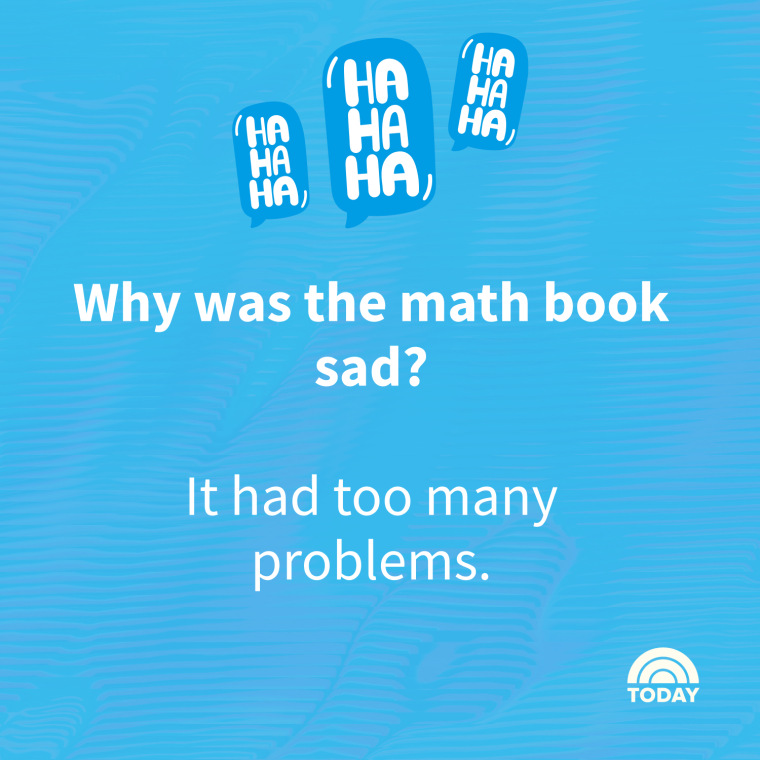
- How did the equal sign stay so humble? Because it knew it wasn’t less than or greater than anyone else.
- Why should you never talk to pi? Because it will go on and on forever.
- Why is the obtuse angle so frustrating? Because it's never right.
- What did the triangle say to the circle? You’re pointless.
- Why did the circle go to the gym? To get in shape.
Corny math jokes
- Which king loved fractions? Henry the ⅛.
- What do you call a crushed angle? A rectangle.
- Why did the obtuse angle go to the beach? Because it was over 90 degrees.
- Have you heard the latest statistics joke? Probably.
- What did one math book tell another math book? I’ve got my own problems.

Math jokes about pi
- What’s a math teacher’s favorite dessert? Pi à la mode.
- What do you call a snake that’s 3.14-feet long? A π-thon!
- How many pastry chefs does it take to make a pi? 3.14
- What did the pi say to its lover? You look absolutely radian.
- Why should you take it easy on the pi? To avoid the big circumference.

Math jokes for kids
- Why did the student eat his homework? Because the math teacher said it was a piece of cake.
- What did zero say to eight? Nice belt.
- What do you call a number that can’t sit still? A roamin’ numeral.
- Why did the student do multiplication problems on the floor? The math teacher said not to use tables.
- Did you hear about the fraction who became a musician? It learned to play by ear.

- What do you call friends who love math? Alge-bros.
- Why did seven eat nine? Because you’re supposed to eat three squared meals a day.
- Why was the fraction so kind? Because it was proper.
- Why don’t plants like math? They want to avoid square roots.
- A nose can’t be 12 inches long, because then it would be a foot.
- Why was six afraid of seven? Because seven eight nine.
- Why didn’t the two 4s grab lunch? They already 8.
- I’m reading a book on anti-gravity. It’s impossible to put down.
- Why did the student bring a ladder to algebra class? They heard the course was on a higher level.
- Why did the calculus student break up with his girlfriend? She couldn’t differentiate between a good and bad pun.

- The algebra book wanted to go on a date with the geometry book, but they couldn’t find any common factors.
- Did you hear about the mathematician who’s afraid of negative numbers? She stopped at nothing to avoid them.
- The percentage couldn’t understand why it kept getting overlooked. It just couldn’t seem to get its point across.
- The percentage and the decimal got into an argument. The decimal said, “You’re just a fraction of what I am!”
- Why was the geometry book tired? Because it had too many angles to cover.
Adult math jokes
- Why was the fraction scared to marry the decimal? It didn’t want to convert.
- Why did everyone want to hang out with the $1 million bill? Because it had a million-dollar charm.
- What do you call a man who spent all summer at the beach? A tangent.
- Why don't mathematicians ever throw wild parties? Because they like keeping their functions under control.
- I asked the percentage why it was always so confident, and it replied, “I’m just 100% sure of myself!”

- Math is like love; a simple idea, but it can get complicated.
- Why did the math teacher break up with the calendar? It has too many dates.
- Why did the number six feel bad about itself? Because even though it’s perfect, it’s not a prime.
- Why did the triangle go to the doctor? It was an acute situation.
- Why did the geometry teacher climb the mountain? To reach the peak of proof.
The laughs just keep on coming ...
- 75 hilarious clean jokes that'll totally crack kids and adults up
- 21 of the best comedy podcasts to listen to for an instant laugh
134 funny quotes that are laugh-out-loud good
Perri is a New York City-born-and-based writer. She holds a B.A. in psychology from Columbia University and is also a culinary school graduate of the Natural Gourmet Institute. She's probably seen Dave Matthews Band in your hometown, and she'll never turn down a bloody mary. Follow her on Twitter @66PerriStreet or learn more at VeganWhenSober.com

50 funny cat jokes that are totally paw-some
Inspiration.

155 corny jokes for kids and adults that are a laugh a minute

125 knock-knock jokes that are a barrel of laughs

30 hilarious spring jokes for budding comedians

105 truly funny jokes that'll make you laugh yourself silly

250 best dad jokes to tickle everyone's funny bone

150 funny jokes for kids that will get the family laughing together

Don’t be fooled by these 16 April Fools’ Day pranks from food brands

55 egg puns that are guaranteed to crack you up

IMAGES
VIDEO
COMMENTS
The age-old question of whether homework is good or bad for students is unanswerable because there are so many "it depends" factors. For example, it depends on the age of the child, the type of homework being assigned, and even the child's needs. There are also many conflicting reports on whether homework is good or bad.
Homework should not be simply assigned as a routine practice, she said. "Rather, any homework assigned should have a purpose and benefit, and it should be designed to cultivate learning and ...
Beyond that point, kids don't absorb much useful information, Cooper says. In fact, too much homework can do more harm than good. Researchers have cited drawbacks, including boredom and burnout toward academic material, less time for family and extracurricular activities, lack of sleep and increased stress.
The necessity of homework has been a subject of debate since at least as far back as the 1890s, according to Joyce L. Epstein, co-director of the Center on School, Family, and Community Partnerships at Johns Hopkins University. "It's always been the case that parents, kids—and sometimes teachers, too—wonder if this is just busy work ...
Homework does not help younger students, and may not help high school students. We've known for a while that homework does not help elementary students. A 2006 study found that "homework had no association with achievement gains" when measured by standardized tests results or grades. [ 7]
A Stanford education researcher found that too much homework can negatively affect kids, especially their lives away from school, where family, friends and activities matter. "Our findings on the effects of homework challenge the traditional assumption that homework is inherently good," wrote Denise Pope, a senior lecturer at the Stanford Graduate School of Education and a
A TIME cover in 1999 read: "Too much homework! How it's hurting our kids, and what parents should do about it.". The accompanying story noted that the launch of Sputnik in 1957 led to a push ...
Yes, and the stories we hear of kids being stressed out from too much homework—four or five hours of homework a night—are real. That's problematic for physical and mental health and overall well-being. But the research shows that higher-income students get a lot more homework than lower-income kids.
Emmy Kang, mental health counselor at Humantold, says studies have shown heavy workloads can be "detrimental" for students and cause a "big impact on their mental, physical and emotional health ...
High school teachers (grades 9-12) reported assigning an average of 3.5 hours' worth of homework a week. Middle school teachers (grades 6-8) reported assigning almost the same amount as high ...
Kohn, the author of The Homework Myth: Why Our Kids Get Too Much of a Bad Thing, considers homework to be a "reliable extinguisher of curiosity," and has several complaints with the evidence ...
After two hours, however, achievement doesn't improve. For high schoolers, Cooper's research suggests that two hours per night is optimal. If teens have more than two hours of homework a night, their academic success flatlines. But less is not better. The average high school student doing homework outperformed 69 percent of the students in ...
Too much homework may diminish its effectiveness. While research on the optimum amount of time students should spend on homework is limited, there are indications that for high school students, 1½ to 2½ hours per night is optimum. Middle school students appear to benefit from smaller amounts (less than 1 hour per night).
The authors believe this meritocratic narrative is a myth and that homework — math homework in particular — further entrenches the myth in the minds of teachers and their students.
Homework has been a perennial topic of debate in education. Attitudes toward homework ... statistics have shown that teachers are attempting to remedy low test scores by giving students more homework (O'Neill 2008). ... Good and Brophy (2003) cautioned that teachers must be careful not to assign too much homework. According to Education Week ...
Emmy Kang, mental health counselor at Humantold , says studies have shown heavy workloads can be "detrimental" for students and cause a "big impact on their mental, physical and emotional health ...
Health Hazards of Homework. Pediatrics. A new study by the Stanford Graduate School of Education and colleagues found that students in high-performing schools who did excessive hours of homework "experienced greater behavioral engagement in school but also more academic stress, physical health problems, and lack of balance in their lives.".
These days, nightly homework is a given in American schools, writes Kohn. "Homework isn't limited to those occasions when it seems appropriate and important. Most teachers and administrators aren't saying, 'It may be useful to do this particular project at home,'" he writes. "Rather, the point of departure seems to be, 'We've decided ahead of ...
The National Center for Education Statistics found that high school students get an average of 6.8 hours of homework per week, ... Homework helps students develop good study habits and life skills. Being responsible for completing at-home assignments helps students practice organization, time management, following directions, critical thinking ...
Homework can create friction between children and their parents, which is one of the reasons why homework is bad. 3. Homework Adds To An Already Full-Time Job. School is already a full-time job for students, as they generally spend over 6 hours each day in class. Students also often have extracurricular activities such as sports, music, or art ...
In this study, Cooper et al analyzed a large pool of research studies on homework conducted in the United States between between 1987 and 2003. Their findings indicate the existence of 'a positive influence of homework on achievement'. The influence is mainly noticed in students in grades 7-12 and less in students grades K-6.
Examining these arguments offers important perspectives on the wider educational and developmental consequences of homework practices. 1. Elevated Stress and Health Consequences. According to Gitnux, U.S. high school students who have over 20 hours of homework per week are 27% more likely to encounter health issues.
People have been trying to find out if homework is a good thing or a bad thing for many years. Recently, a report was done by an organisation called the Teaching Schools Council, which works with ...
getty. There's a global debate raging about the state of our youth. On the one hand, there are the influential voices of two academics, Jonathan Haidt and Jean Twenge, raising the alarm that ...
28% of voters say Biden is a good or great president, while 21% say he is average. These views are mostly on par with June 2020 assessments of the kind of president Biden would be - but today, a smaller share of voters say he is average. (Read more about ratings of Biden's and Trump's presidencies in Chapter 1.)
Even Southern New Hampshire's nickname fits the theme of Gitschier's story. The Penmen. That came from all the Colonial accountants and clerks who banded together, going from their ledgers of ...
The number of people coming from South and Central American is rising and they will eventually arrive at the U.S. Southern border, analysts say.
Real gross domestic product (GDP) increased at an annual rate of 1.6 percent in the first quarter of 2024 (table 1), according to the "advance" estimate released by the Bureau of Economic Analysis. In the fourth quarter of 2023, real GDP increased 3.4 percent. The GDP estimate released today is based on source data that are incomplete or subject to further revision by the source agency (refer ...
Best math jokes. Why was the math book sad? It had too many problems. Where do math lovers go on vacation? Times Square. Where do math lovers go on a tropical vacation? The Bermuda Triangle. In ...